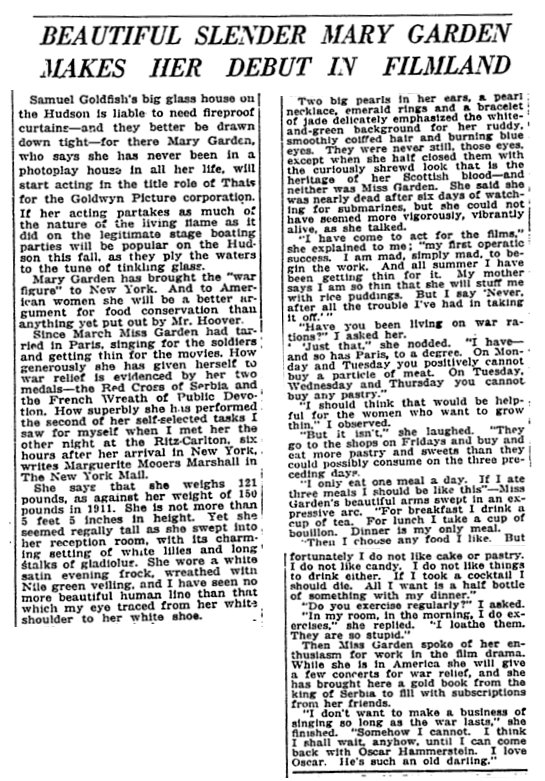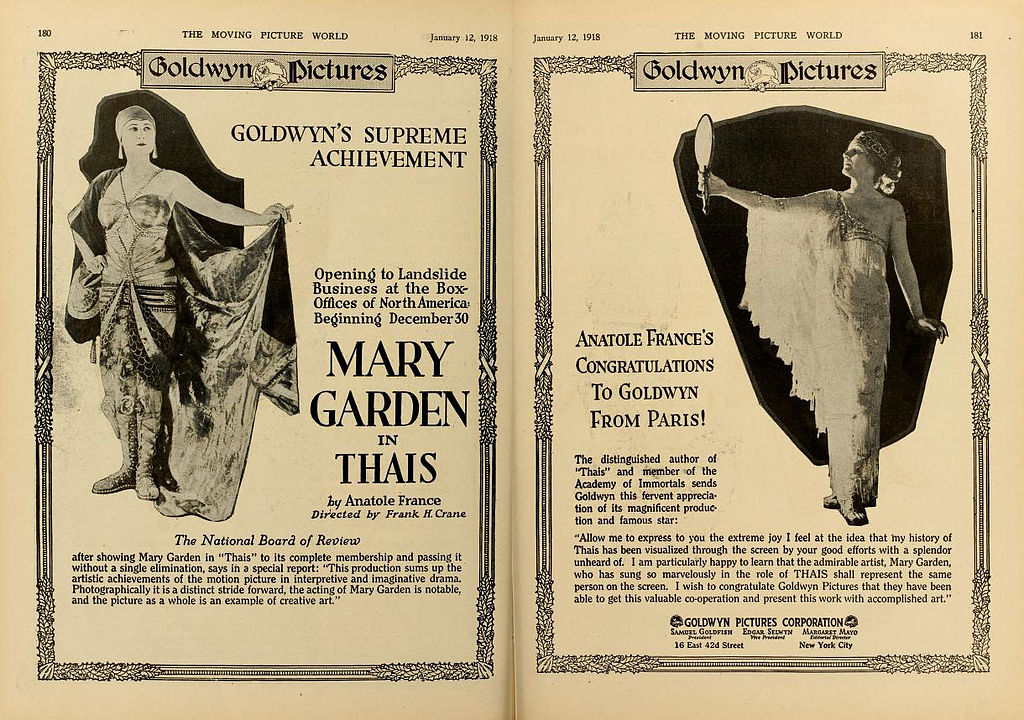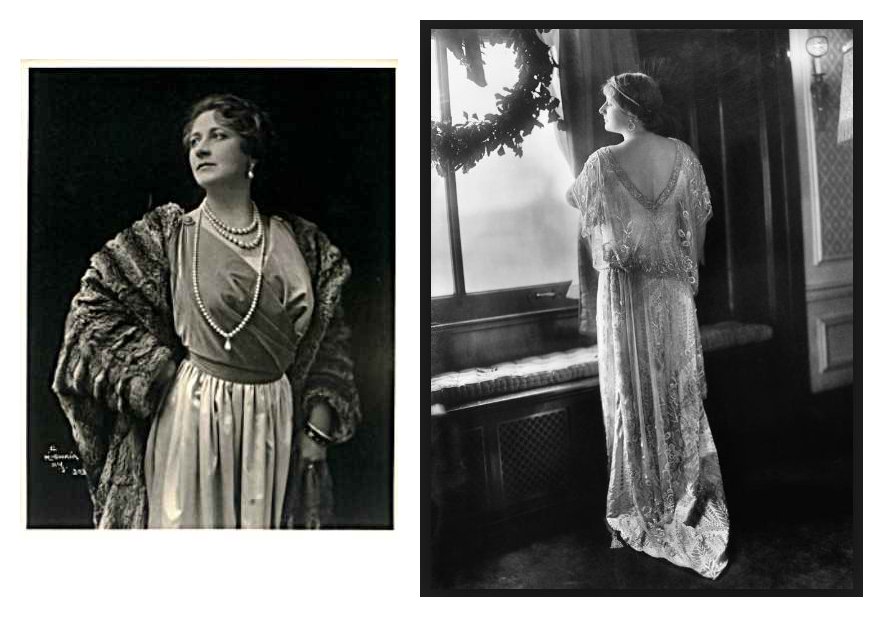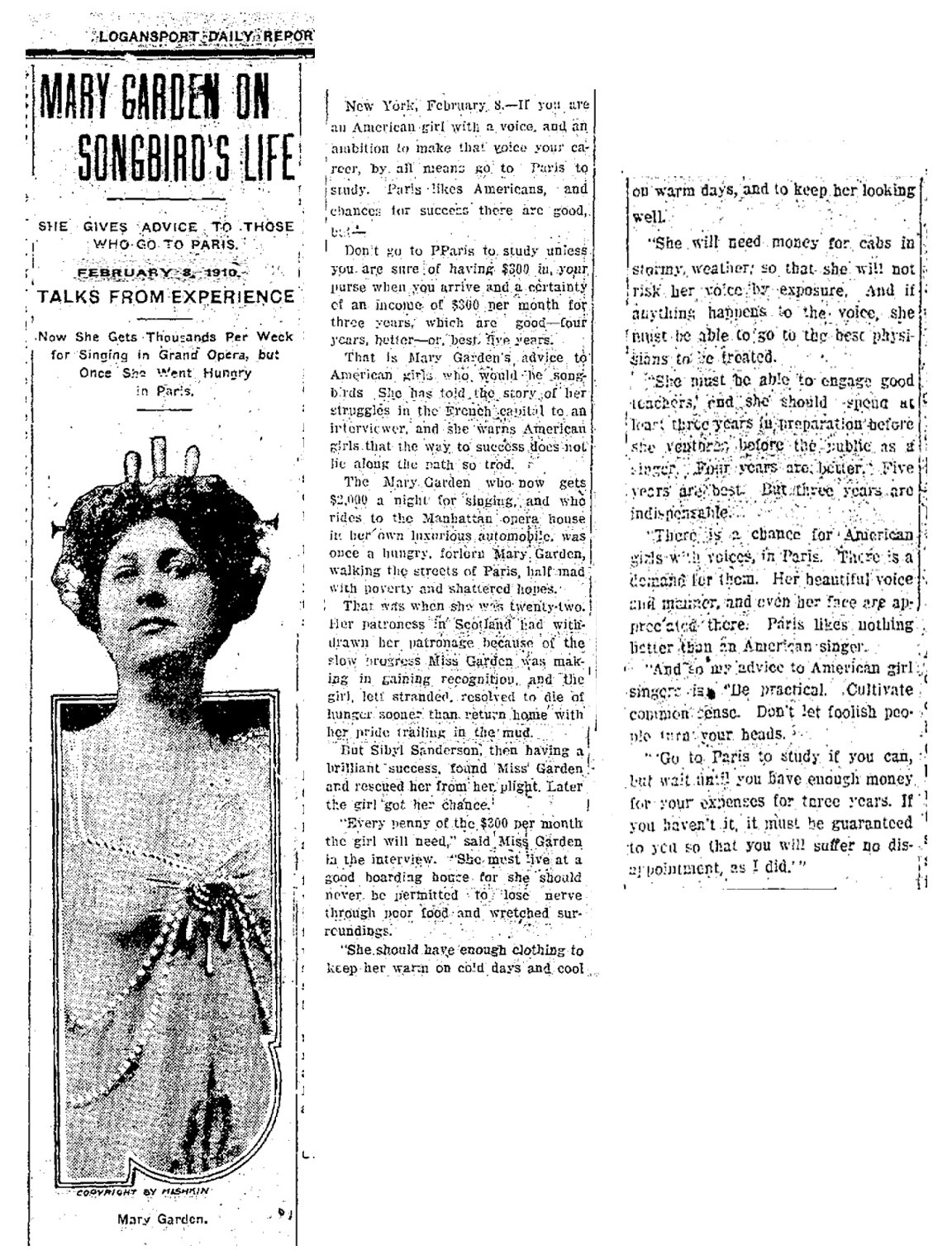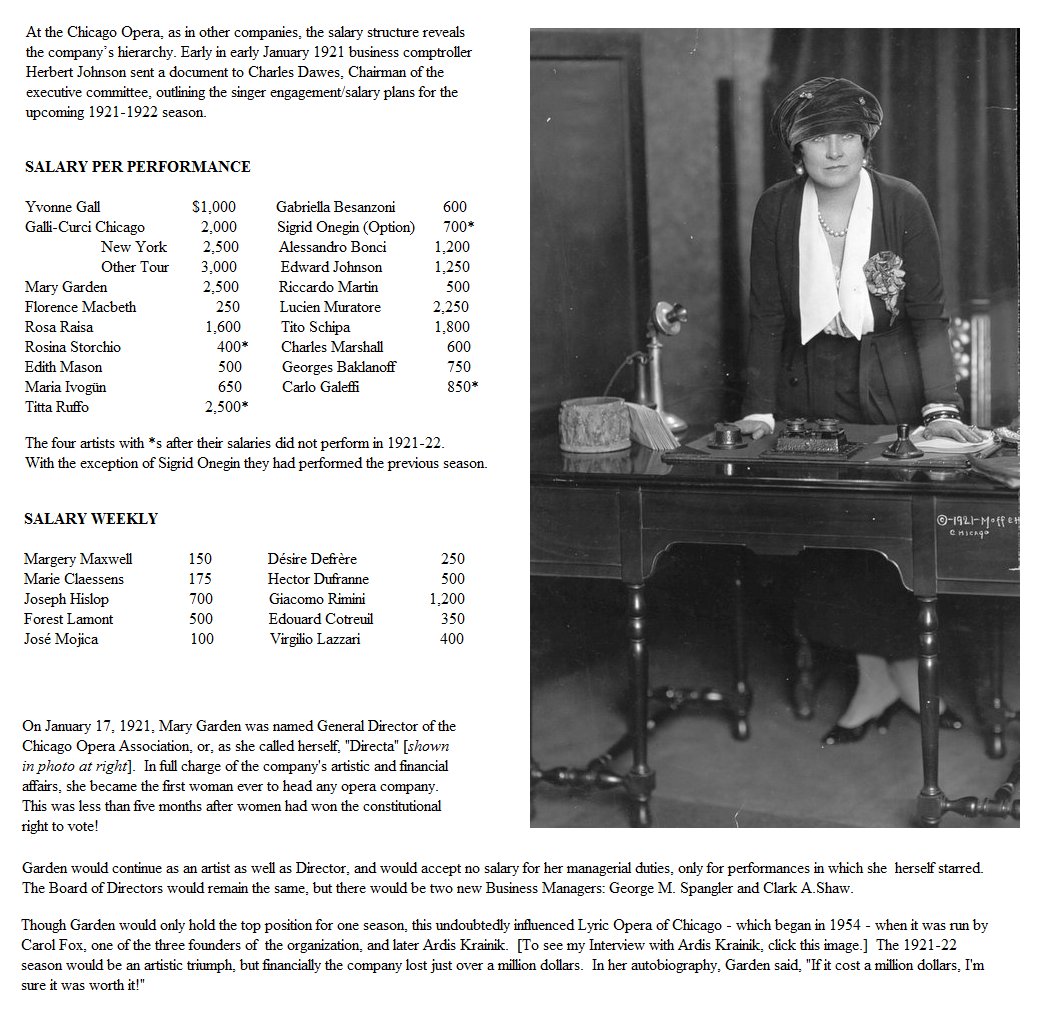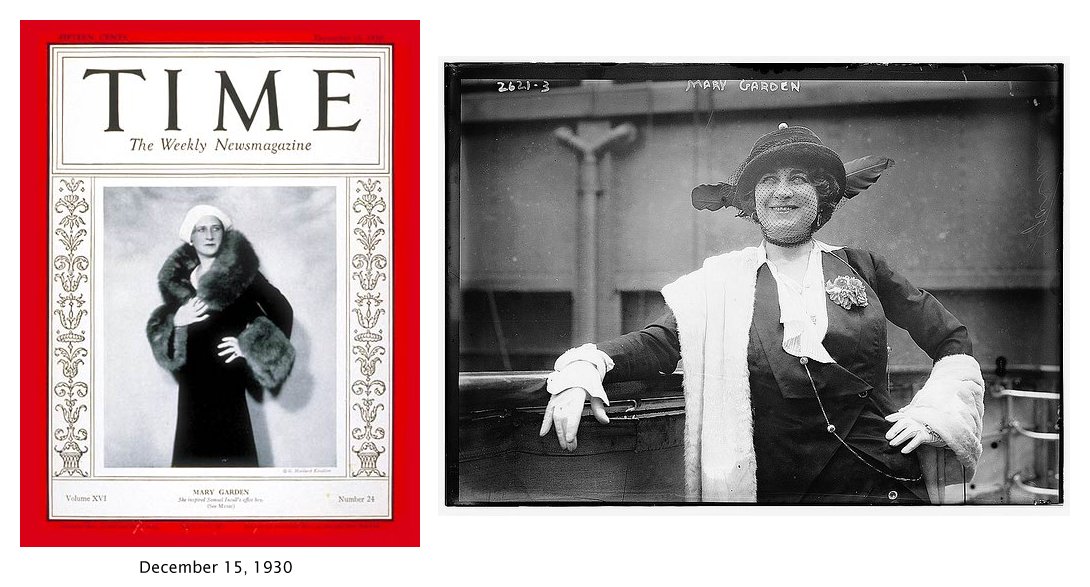By Bruce Duffie
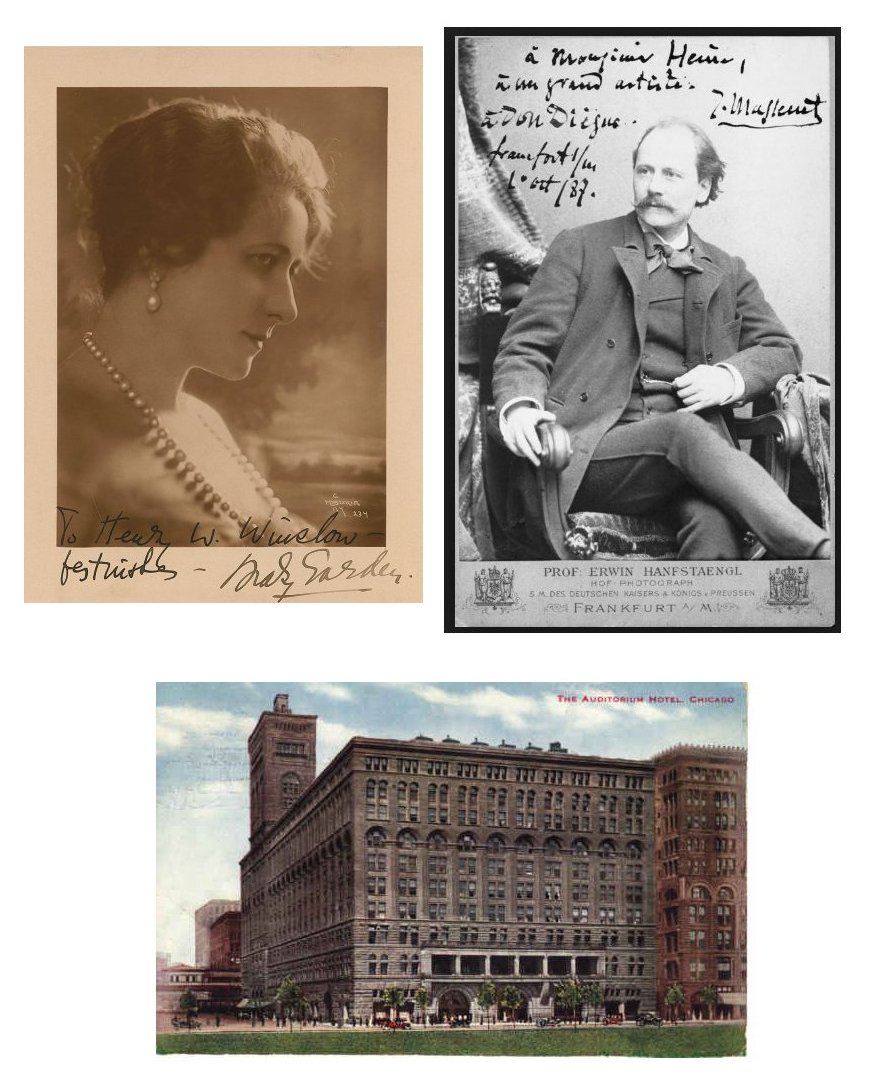
| What is contained on these three
webpages is an expanded version of an article which was first published the
Masssenet Newsletter dated
January, 1984. A semi-annual of the Massenet Society, thirty-two of
my interviews were presented there from 1982-1993, but this was my only researched-article
for them. A similar arrangement was made with Wagner News, published by the Wagner
Society of America, where forty-five interviews and five articles appeared
between 1980-1992, including a presentation very similar to
this one about Wagner in Chicago during the same period of the teens
and twenties. As you will see, this is a very logical time segment
to examine, and in some cases the singers overlapped into both repertoires. It is now exactly thirty years later, and many of my interviews are being posted on this website. So I felt it time to re-examine this article, update it a bit and give it another life! Originally the text and performance chart were published, but here I have added a new chart regarding tours, and have updated the original chart to include more names where possible. I have also now included biographies and photographs of most of the singers and conductors. There are five basic sources for all of this. Three books, a generous collection of clippings, and the ubiquitous world wide web. Specifically, -- Opera in Chicago - A Social and Cultural History
1850-1965 by Ronald Davis
-- Forty Years of Opera in Chicago by Edward Moore -- Oscar Hammerstein's Manhattan Opera Company by John F. Cone -- A collection of scrapbooks kept by [unknown] from 1922-1937 -- The internet and its all-encompassing trove of text material and photographs * *
* * *
The presentation is organized in the following manner. There are three webpages, with a link to the next page at the bottom of the first two. On the first page (this page)... -- The title and a photo group of Mary Garden, Massenet, and the Auditorium Theater of Chicago -- An introduction (this box), followed by another photo of Massenet -- The original text, slightly edited, with the addition of various photos, an "appendix" and other related items -- The original chart of performances and casts, greatly expanded with more names as well as the "prologue" for the years 1906-10 and a brief "epilogue" -- A new chart (in the same order) showing tour cities where each opera was done in the years 1907-29 -- Materials for each opera (in the same order) with programs, photos, commentary, etc., including a few of the illustrated biographies where appropriate -- A long, illustrated biography of Mary Garden (which includes part of an essay she wrote on the art of singing) -- A long, illustrated biography of Charles Dalmorès (which includes a day-to-day schedule illustrative of these principal singers) On the second page... -- An alphabetized list of all the singers, conductors and administrators whose illustrated biographies are contained in this presentation -- The illustrated biographies of the female singers invloved in the opera companies during this period On the third page... --The illustrated biographies of the male singers, as well as the illustrated biographies of the conductors and administrators |
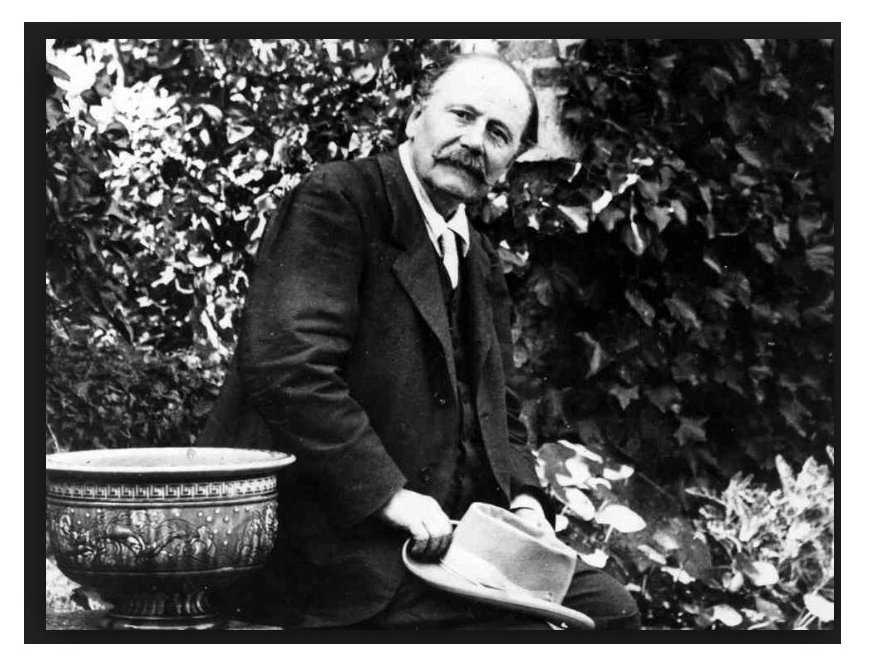
This study originally grew out of a lecture which I gave a few years ago before a performance of Don Quichotte. In digging for material about this little-known work, I began looking through a book called Opera In Chicago by Ronald L. Davis. The book is in two sections. First, a narrative describing the growth and development of the various opera companies in Chicago, and second, the annals of performance from 1910-1965.
Reading through the narrative of the very early days of opera in Chicago is, naturally, fascinating and enlightening. But it is not until one begins to look closely and analytically at the annals that the full impact of those glorious days becomes apparent.
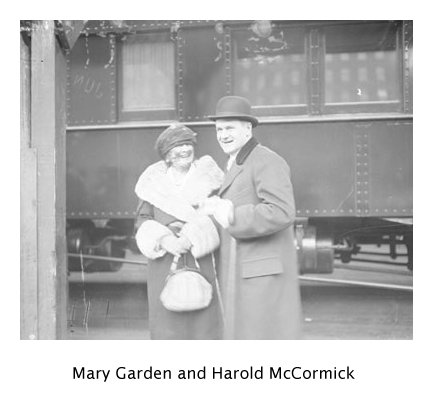 I mentioned that this was for a lecture on Don Quichotte. After noting that
the work had been given in two early seasons -- 1913 and 1929 -- I remembered
that Mary Garden had been the reigning star of the company, and for one season
had been the General Director. I also knew that she sang much French
repertoire and many modern works. A brief look at a few pages of the
book revealed numerous works with her name, including performances of the
operas of Massenet. So I got to wondering just how much Massenet had
been done by the various Chicago companies, and to my surprise and delight
I found that during the period 1910-32, at least one -- and often several
-- of his works had been presented in every season except one. Then
I hunted for the name of Mary Garden and found that from 1910-1931, she appeared
in all but one season, and in every season except two she sang at least one
Massenet opera!
I mentioned that this was for a lecture on Don Quichotte. After noting that
the work had been given in two early seasons -- 1913 and 1929 -- I remembered
that Mary Garden had been the reigning star of the company, and for one season
had been the General Director. I also knew that she sang much French
repertoire and many modern works. A brief look at a few pages of the
book revealed numerous works with her name, including performances of the
operas of Massenet. So I got to wondering just how much Massenet had
been done by the various Chicago companies, and to my surprise and delight
I found that during the period 1910-32, at least one -- and often several
-- of his works had been presented in every season except one. Then
I hunted for the name of Mary Garden and found that from 1910-1931, she appeared
in all but one season, and in every season except two she sang at least one
Massenet opera!Let me state right here that going through the annals of performance for any great opera company is as frustrating as it is fascinating. When one is familiar with the names and reputations of so many singers -- through reading books and reviews, and from listening to commercial recordings and air-checks -- one can (as I did) become completely bowled over by the repertoire and the casting combinations. There were many times when I simply spent hours looking over the lists, flipping from one season to another, checking to see if the cast was repeated or changed within a season, and seeing who reprised roles from year to year. Every time I would begin running something down, my eyes would catch something equally fascinating and I'd be off on another track for many minutes. And remember that each of these new tangents would usually provide additional side-trackings, so before long the original hunt was completely enmeshed in the maze of past performances. Isn't there a potato chip that claims you cannot eat just one?
Anyway, only after many hours of hunting does any series of patterns become clear, and one can finally get down to the business of sorting through it all with any semblance of satisfaction. I finally decided to make a chart, and that is reproduced farther down on this webpage. I have selected the years 1910-1932 for several specific reasons. First, the start date was simple for 1910 was the first year of resident opera in the city of Chicago. There had been opera before that, but always by touring companies and visiting artists. As with the earliest days of the Metropolitan Opera in New York, there were years in which no opera was given for one reason or another. In Chicago, the year 1914-15 had no opera by a resident company. The same was true for 1932-33, 1943-44, and the bleak period of 1947-53. It should be noted here that Chicago is often compared with San Francisco, and rightly so because of the traditions, size of houses, and specific length and time of the seasons. But the current company, Lyric Opera of Chicago, gave its first performances in 1954, and all current dating and company premieres are for this company. Often, when people hear of Lyric's upcoming 30th season or note that a certain well-known opera is a "Lyric Premiere," they fail to remember that Chicago has had resident opera since 1910. There are the gaps which I mentioned, and there were different companies with slightly different names, but Chicago has had ten more seasons of resident opera than San Francisco. The west coast, though, has been fortunate to still be the same company with no gaps in their yearly annals. Incidentally, Lyric did have one dark year, 1967, but that was an interruption, not a change in the management or name.
For the record, in these pre-1947 years the companies usually changed due to bankruptcy or upheaval in management. Specifically, the correct dates and titles are:
Chicago Grand Opera Company, 1910-1914
Chicago Opera Association, 1915-1921
Chicago Civic Opera, 1921-1932
Chicago Grand Opera Company (again), 1933-1935
Chicago City Opera, 1936-1939
Chicago Opera Company, 1940-1946
Chicago Opera Association, 1915-1921
Chicago Civic Opera, 1921-1932
Chicago Grand Opera Company (again), 1933-1935
Chicago City Opera, 1936-1939
Chicago Opera Company, 1940-1946
Even Lyric Opera of Chicago began in 1954 as the Lyric Theatre, and then changed its name to the present title when the management was re-structured in 1956 under Carol Fox.
To get back to the subject at hand, the time span of my chart stops after the 1931-32 season. The following year was a gap; Mary Garden was no longer appearing; the company had moved (in November of 1929) to the new Civic Opera House on Wacker Drive, which meant that few of the old sets could be used without major revisions. Further, the companies which presented opera during 1933-47 restricted the works of Massenet to just two - Manon, done is eight seasons with various casts including Moore, Jepson, Sayão, Kiepura, Crooks, Schipa, Brownlee, and Thaïs in three seasons 1935-37, always with Jepson, Martin, and John Charles Thomas. [See the "Appendix" immediately below for more details.] Indeed, during the Great Depression of the 1930s, opera was viewed by the management and patrons as escapism, and few modern works were presented.
So it can be plainly seen that the range of interest to the Massenet Society is clearly centered in the years 1910-1932 with the proliferation of his works and the appearances of Mary Garden.
|
"Appendix"
showing the works of Massenet given in Chicago between 1933 and 2013
[Seasons listed as "19xx-xx" were
longer and ran into the following calendar year.
Those seasons with just a single year-date were shorter and presented operas just in the fall.] [From 1933-45, Manon usually was done twice per year, and Thaïs received just one performance per season.] 1933-34 Manon with Claire, Borgioli, Defrère, Sjovik; Weber 1934 Manon with Hampton, Bentonelli, Royer; Kopp 1935 Thaïs with Jepson, Thomas, Martin, Cordon; Hasselmans 1936 Manon with Dosia/Moore, Burdino, Brownlee; Hasselmans Thaïs [same as 1935 except Ruisi for Cordon] 1937 Thaïs [same as 1936] 1938 Manon with Dosia, Burdino, Royer; Hasselmans 1939 Manon with Moore/Dosia, Burdino/Kiepura, Czaplicki; Hasselmans 1940 Manon with Jepson, Crooks/Schipa, Czaplicki, Kirsten as Pousette; Abravanel/Kopp 1942 Manon with Jepson, Crooks, Czaplicki; Kopp 1945 Manon with Sayão, Tokatyan, Bonelli/Brownlee; Cleva 1959 Thaïs with Leontyne Price, Roux, Simoneau, Corena, Ardis Krainik as Myrtale; Prêtre, directed by Vladimir Rosing 1971 Werther with Troyanos, Kraus, Angot, Andreolli; Fournet, Mansouri 1973 Manon with Zylis-Gara, Kraus, Patrick, Gramm; Fournet, Deiber 1974 Don Quichotte with Ghiaurov, Cortez, Foldi; Fournet, Tajo 1978 Werther with Minton, Kraus, Nolen; Giovaninetti, Samaritani 1981 Don Quichotte with Ghiaruov, Valentini-Terrani, Gramm, Gordon, Negrini, Cook; Fournet, Samaritani, Tallchief 1983 Manon with Scotto, Kraus, Titus, Washington; Rudel, Hebert 1992-93 Le Cid (in concert form) with Domingo, Vernet, Lloyd, Hagley; Delacôte 1993-94 Don Quichotte with Ramey, Mentzer, Lafont; Nelson, Koenig 2002-03 Thaïs with Fleming, Hampson, Kaasch, Morscheck; Davis, Cox 2008-09 [Opening Night] Manon with Dessay, Kaufman, Feigum, Aceto, Cangelosi; Villaume, McVicar 2012-13 Werther with Koch, Polenzani, Verm; Davis, Negrin -- Names which are links here and in
the text refer to my interviews elsewhere on this website
|
* *
* * *
Chicago first heard opera in July of 1850. A group of four singers came by boat from Milwaukee to perform La Sonnambula. The theater burned down the next night (with no loss of life), but opera had been heard and seen and was now demanded by the public. By the 1890s, Chicago was the railway transfer point for just about everyone, and as the hub of the nation it heard opera in the newly-opened Auditorium Theater on Congress Parkway. This historic landmark was considered by Jean De Reszke to have the finest acoustics of any theater in the world!
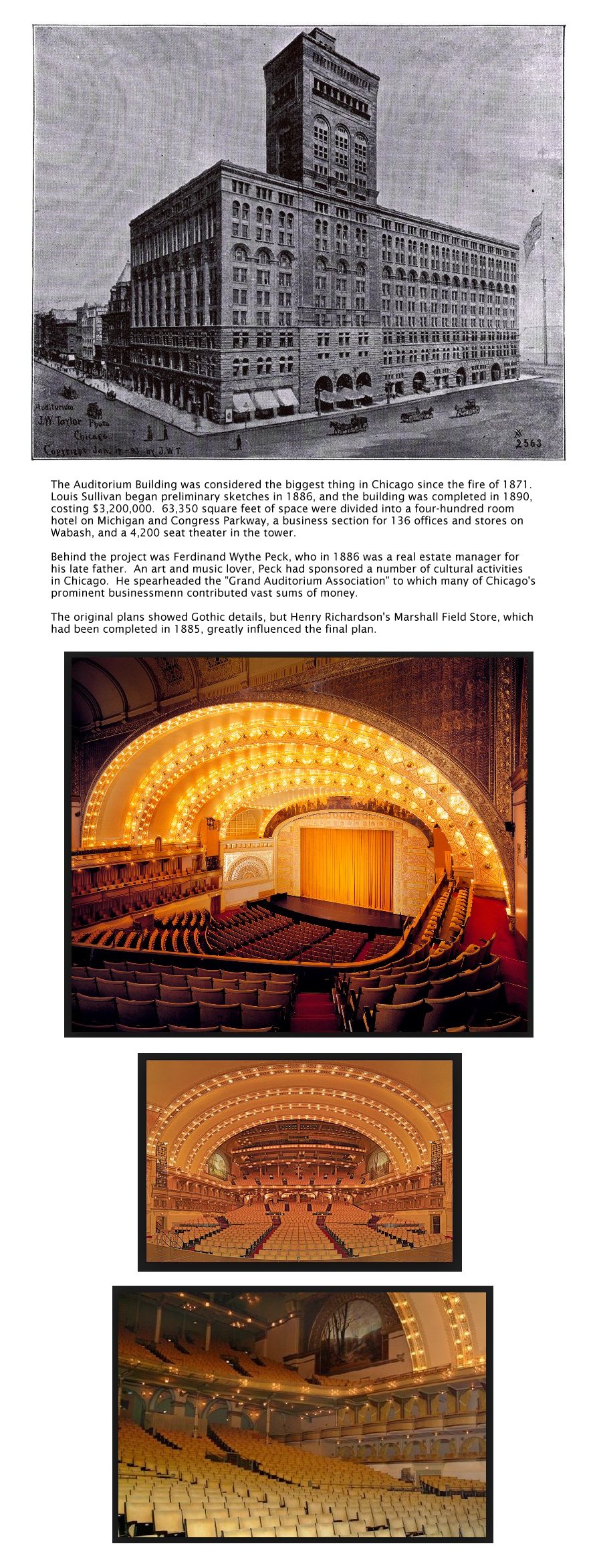
In 1893, the Columbian Exposition focussed world-wide attention on the city, and many touring companies presented their troupes. On the French front, one of the early artistic triumphs was a production of Le Cid in 1897, and this led to "seasons" of French operas from New Orleans in 1899 and 1900. But something was happening in New York City which would change the course of opera in Chicago.
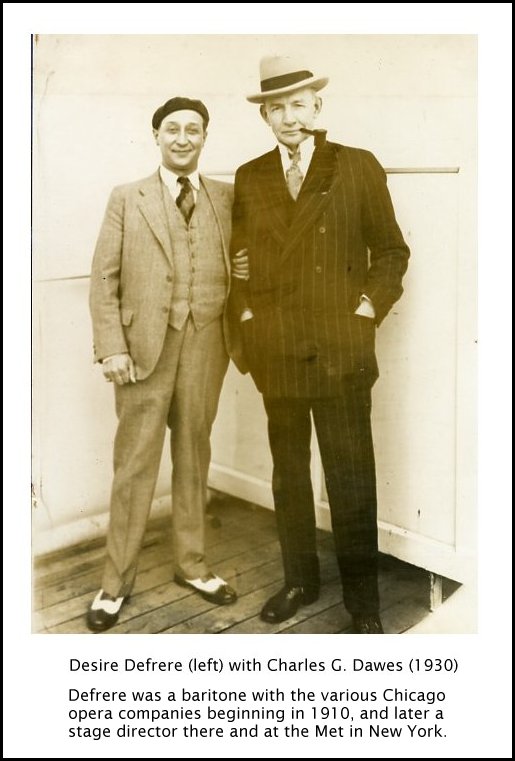 The story of the Hammerstein Opera Company in New York City is well-known,
and the four seasons he presented were so spectacular that the Met finally
paid him to cease competing with their company. In the settlement,
the Metropolitan Opera Company acquired the assets of the Hammerstein Company
-- which included scores, sets, and costumes for the predominantly French
repertoire. It was at this time that the financiers and backers from
Chicago were trying to get a resident opera company started, and since it
was felt in New York that Chicago would not be directly competing with the
Met, the newly-acquired assets were sent west to help start the Chicago Grand
Opera Company. Harold McCormick was the President of the new company,
Charles Dawes (later vice-president under Coolidge) was the First Vice-President
[shown in photo at right], Otto
Kahn (then President of the Met) was Second Vice-President. Andreas
Dippel, a former singer and then assistant to Gatti-Casazza at the Met was
named General Manager, and the leading star of the company was Mary Garden.
The story of the Hammerstein Opera Company in New York City is well-known,
and the four seasons he presented were so spectacular that the Met finally
paid him to cease competing with their company. In the settlement,
the Metropolitan Opera Company acquired the assets of the Hammerstein Company
-- which included scores, sets, and costumes for the predominantly French
repertoire. It was at this time that the financiers and backers from
Chicago were trying to get a resident opera company started, and since it
was felt in New York that Chicago would not be directly competing with the
Met, the newly-acquired assets were sent west to help start the Chicago Grand
Opera Company. Harold McCormick was the President of the new company,
Charles Dawes (later vice-president under Coolidge) was the First Vice-President
[shown in photo at right], Otto
Kahn (then President of the Met) was Second Vice-President. Andreas
Dippel, a former singer and then assistant to Gatti-Casazza at the Met was
named General Manager, and the leading star of the company was Mary Garden.Just to give some idea as to the glorious sounds heard in that first Chicago season of 1910, Melba sang Mimì and Violetta; McCormack sang Turiddu, Rodolfo, Alfredo, and the Duke; Farrar sang Butterfly; Renaud was the four villains in Tales of Hoffmann; Dalmorès was heard as Faust and Hoffmann; Gadski appeared in Les Huguenots; Caruso sang Pagliacci and Fanciulla del West just six weeks after doing the world premiere in New York -- though other casts had already done four performances, indicating just how up-to-date this brand new company was! Mary Garden sang Mélisande, Louise, Salome (!), Thaïs, and Marguerite. The next season brought Gerville-Réache as Dalila; Tetrazzini was Lucia, Violetta, Gilda, Rosina, and Lakmé; Maggie Teyte was Cherubino and Marguerite as well as Cendrillon; Garden sang Carmen, Natoma, Jongleur, Thaïs, and the Prince in Cendrillon; Dalmorès was Samson, Lohengrin, Siegmund, and Tristan which he sang with Fremstad, Gerville-Réache and Whitehill, and when it came back the following season, Dalmorès and Whitehill were joined by Nordica and Schumann-Heink.
Garden's first opera of that second season (1911-12) was Cendrillon. The Musical Courier said, "Garden is to the French contingent of the opera what Tetrazzini is to the Italian element -- the supreme star -- and her position has not in any way been endangered by the newcomers among the French singers." Both the score and the production came in for applause. The Tribune said, "The scenic display was the most attractive and pretentious ever shown in opera in Chicago."
Garden also did Jongleur that second season and it proved one of her very best roles. The part, as we know, was written for a tenor, but had been re-arranged especially for her. She played a young boy, a juggler, and for the part her voice became clear and almost sexless. Dramatically her portrayal was masterly; every movement was intense and realistic. In her autobiography she said of the role, "I danced my country dances, played my fiddle, juggled the three balls, and sometimes I used to let one go and make the people of the village laugh. It made them happier to think I was such a bad juggler. But I was always the boy, excited, and awkward and adoring." The audiences used to get highly amused with the little donkey which followed the young juggler and showed such a great interest in Garden's singing, but looked so totally indifferent when anyone else sang. Some jealous singers claimed that Garden had trained the animal to behave that way . . .
From time to time, there was talk of returning the role to a tenor, but one critic wrote in a later season, "No tenor, no matter how talented, could ever be as boyish as Garden. I would rather hear her sing and then cry and mop her eyes and wipe her nose than listen to the finest tenor on Earth in the part. When the Prior scolds her, she twists her body into something that is all knees and elbows, and it's all boy, too." [Note: While updating this article very late in 2013, I discovered that in 1909-10 David Devriès took part in the final season of Oscar Hammerstein I's Manhattan Opera Company, singing Jean in Jongleur while Garden was away, thus allowing audiences to hear both versions of the opera that season. Garden and Devriès later sang together in both Grisélidis and Pelléas et Mélisande while on tour with the company in Boston.]
The next few years -- during the period specifically concerned here -- in addition to the various Massenet works listed in the chart, Chicago heard Ruffo as Rigoletto, Hamlet, Tonio, Barnaba, Cristoforo Colombo of Franchetti, Figaro, and Don Giovanni; Florence Macbeth sang Olympia, Lucia, Rosina, Gilda, Adina, and Micaëla; Supervia was Mignon and Carmen; Stracciari did roles in Rigoletto, Traviata, Tosca, Ernani, Lucia, and Linda di Chamounix; Homer was Dalila and Amneris; Charles Marshall sang Otello, Tristan, Samson, Riccardo, Alvaro, Enzo, and Pollione; Schipa was in Don Giovanni, Mignon, Don Pasquale, Barbiere, Traviata, Martha, Lucia, Rigoletto, and Sonnambula; Chaliapin was both Boris and Méfistofélès, Galli-Curci was Gilda, Lucia, Violetta, Juilette, Dinorah, Sonnambula, Rosina, Linda di Chamounix, Mimì, and Lakmé; Vanni-Marcoux did roles in Louise, Tosca, Boris, Hoffmann, Mignon, Don Giovanni, Faust, Pelléas, and on the same evening sang both Gianni Schicchi and Chim-Fen in L'Oracolo; and the team of Rosa Raisa and Giacomo Rimini appeared separately -- but more often together -- in Norma, Aïda, Fanciulla del West, Francesca da Rimini (!), Falstaff, Andrea Chenier, Isabeau, I Gioelli della Madonna, Tosca, and La Juive.
It should be apparent after reading through all these items that the first two decades of resident opera in Chicago were such as to stagger the mind when viewed a helf-century later. And although there was a generous helping of the works of Massenet, if he seems absent from the preceding list, that is because the chart tells it all. Fit the notations of the chart into the list above, and the seasons become amazingly daring and yet balanced in a way that no company can boast in the current day and age. Needless to say, the list above is nowhere near complete, but simply jottings of the highlights that leaped off the pages at me while going over the annals. One other note should be mentioned and that is the annals refer only to the performances by the resident company in Chicago. These companies did tour to various cities -- including many trips to New York -- and the performances were usually well-received by the press and the public. For a few years there was a special connection with Philadelphia, and indeed the company was know for a time as the Chicago-Philadelphia Grand Opera Company... or if you lived on the east coast, the Philadelphia-Chicago Grand Opera Company! In any event, perhaps the City of Brotherly Love had the very best of it, what with productions from Chicago and the regular tours from the Met...
* *
* * *
Getting back to Mary Garden, in those days she sang practically nothing but modern operas -- many of them world premieres. But consider what they were: Pelléas et Mélisande, Louise, Salome, L'Amore dei Tre Re, and of course the works of Massenet, as well as Monna Vanna (Février), Aphrodite (Erlanger), and Camille (Hamilton Forrest) to mention just a few. Naturally she did sing some older operas -- including Carmen and Faust -- but her dramatic flair and natural flamboyance made these new works come alive. One prominent banker remarked in 1920, "I only go to the opera when Mary's there because, you know (ha! ha!) she really is good to gaze upon." Her Salome was both a scandal and a sensation, but she herself later remarked, "The Chicago audiences seem to prefer me in Thaïs because I wear fewer clothes in that one." Cléopâtre drew this notice, "After many years of study and thought, I have learned why they give grand opera in foreign languages. It is so that they may present Massenet's Cléopâtre... without danger of police interference. I won't dwell on the details in the columns of a newspaper intended for general circulation... Compared to it, her Salome of a few years ago was a demure and inexperienced young flapper." The critic went on, "It has the most appalling score that was ever perpetrated. Mary Garden's voice could neither help nor harm it."
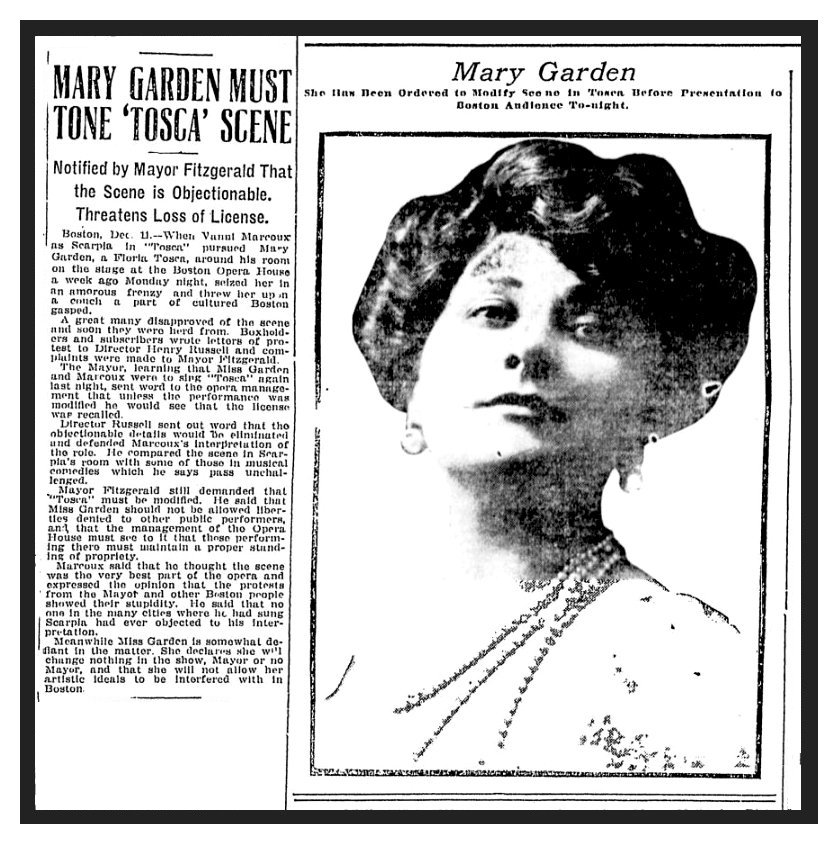
There were others, though. Sapho was dramatically good for Garden. One critic wrote, "The music seemed scarcely more than an irritation." The opera was staged carefully, particularly the orgy in the first act. "Garden flashed in gorgeous red hues, bare legged in the first act and bare armed in the second. She came close to making the hit of her Chicago career with it." In Montemezzi's L'Amore dei Tre Re, she spent the last twenty minutes of the opera with her head hanging over the end of a bench playing dead. She always was there herself - never utilizing an understudy for the scene. Operatic wags got to speculating at parties about what she was thinking during that time... The opera was done in the first season of the new house (1929-30) and a critic said, "There was such a love scene that would cause hesitation in the mind of any right-minded movie censor."
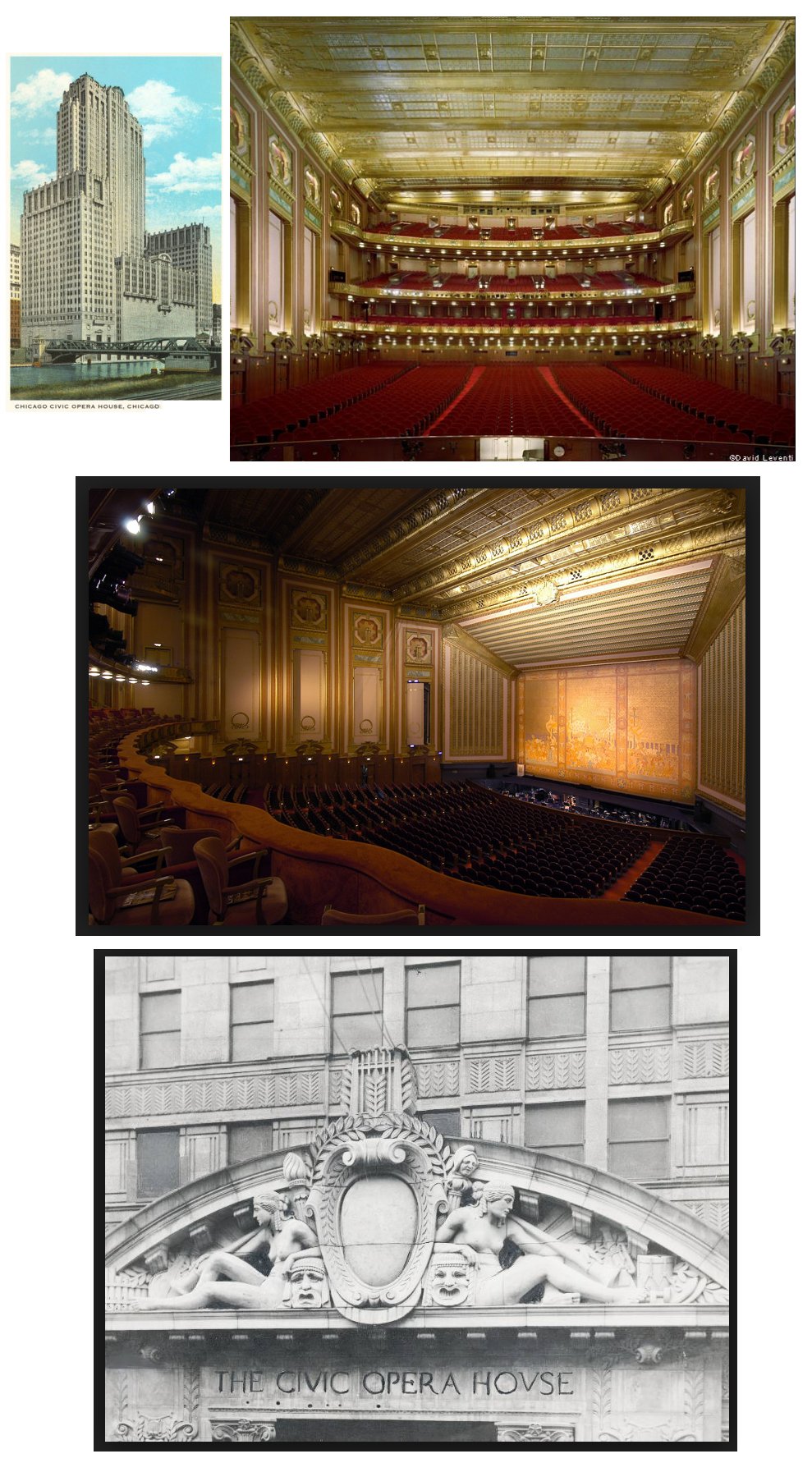
All of this freedom of expression was not confined to the stage. The Tribune said of Garden that she is "as difficult of classification as a French verb." In 1929 she wanted to talk to the press about the freedom of the modern woman and love. "Contemporary women and especially American woman" she said, "were too calculating to love completely. Women do not live for love; they work for their living. They do not inspire men and they do not care whether they do or not. Still, women are not wholly free. Perhaps in fifty years they may be." Garden continued, "I don't like the past. It's fine that women no longer love as they did, but it will be finer if they can win absolute freedom. Formerly we were under the man's heel. Now just his little toe is on us. Yet how conscious we are of that little toe."
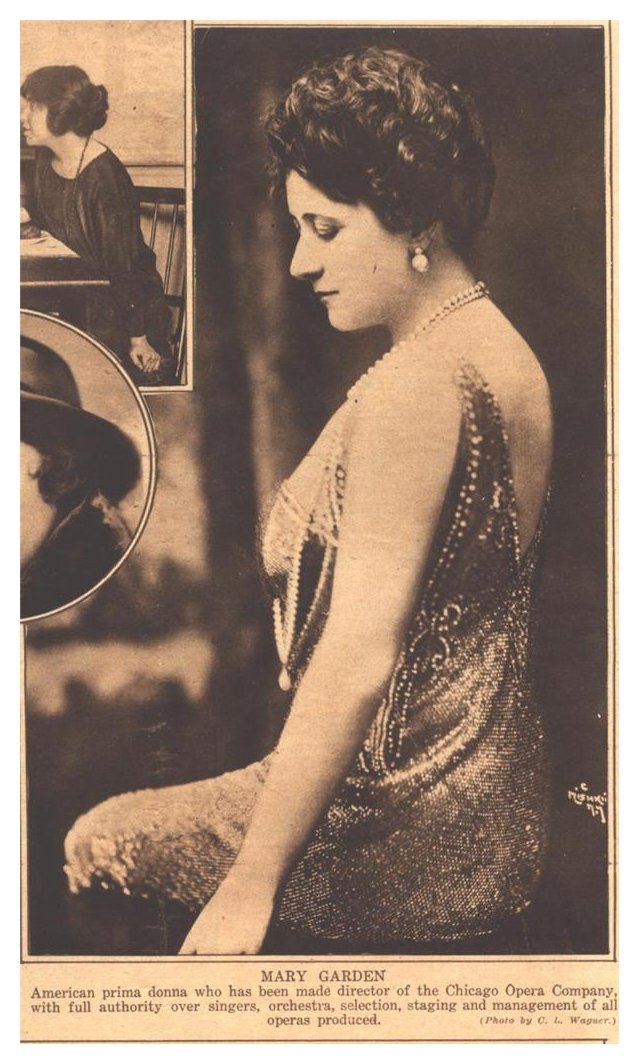 There is one further aspect of the artistry of Mary Garden that cannot be
left out. In 1921, Harold McCormick was about to end his association
with the opera company. He's been the financial mainstay for over a
decade, and the company was doing rather nicely. Attendance was down
a bit during the previous year, though, and he wanted to go out with a blaze
of glory. To do this, he needed something extra spectacular to induce
the public to return, and he approached Garden with the idea of naming her
the Director of the company. The idea had been considered by the Board
of Directors before, but this time McCormick was quite determined.
She finally accepted his offer, but with several things understood.
First, she was to have a completely free hand to choose casts and administrators;
second, she would take the post for just one season, but no one was to know
that fact lest she lose any trace of discipline; and third, she would not
be paid for the position, but only draw a salary for the performances she
sang. McCormick agreed to back her in every way -- including financially
-- and so in January of 1921, it was announced that Mary Garden would be
the General Director (or "Directa" as she liked to be called) of the Chicago
Civic Opera Association. She was the first woman ever to head an opera
company, and remember that this was less than five months after women got
the constitutional right to vote in this country!
There is one further aspect of the artistry of Mary Garden that cannot be
left out. In 1921, Harold McCormick was about to end his association
with the opera company. He's been the financial mainstay for over a
decade, and the company was doing rather nicely. Attendance was down
a bit during the previous year, though, and he wanted to go out with a blaze
of glory. To do this, he needed something extra spectacular to induce
the public to return, and he approached Garden with the idea of naming her
the Director of the company. The idea had been considered by the Board
of Directors before, but this time McCormick was quite determined.
She finally accepted his offer, but with several things understood.
First, she was to have a completely free hand to choose casts and administrators;
second, she would take the post for just one season, but no one was to know
that fact lest she lose any trace of discipline; and third, she would not
be paid for the position, but only draw a salary for the performances she
sang. McCormick agreed to back her in every way -- including financially
-- and so in January of 1921, it was announced that Mary Garden would be
the General Director (or "Directa" as she liked to be called) of the Chicago
Civic Opera Association. She was the first woman ever to head an opera
company, and remember that this was less than five months after women got
the constitutional right to vote in this country!The announcement was made the day before she was to sing a performance, so the reporters were kept away. But during the intermission that next day, she held a press conference in her dressing room. She told the world that she was delighted with the prospect and had been given virtually a blank check to run the company the way she saw fit. She was determined to make this an American opera company both onstage and in the offices, and she wanted to make it the very best opera company in the world. And she intended to impose discipline on the artists to achieve those goals.
That summer, Garden went to Europe hiring singers for the company. It must be remembered that decisions about repertoire and casting back then were not made years in advance as they are today, but rather almost on the spot from week to week. In the end, she wound up hiring many more singers than she could possibly use, with the result that during the season many world-class singers were hardly used or were completely idle. A few, after complaining about not working, were simply paid the amount in their contract and told their services were not needed. On balance, however, many singers commented that the amount of rehearsals provided time for comfort in their roles and with their colleagues.
And what a season it was! In addition to the Massenet works, Prokofiev conducted the premiere of his Love for Three Oranges; Muratore sang Samson, Faust, Roméo, Herod, Monna Vanna, L'Amore dei Tre Re and Pagliacci; Galli-Curci was Lucia, Violetta, Rosina, Gilda, Butterfly, Juliette, and Lakmé; Baklanoff sang Méfistofélès, Sharpless, Louise, Tosca, Lakmé, and L'Amore dei Tre Re; Schipa was the Duke, Edgardo, Almaviva, and Gerald; Raisa was Tosca and Elizabeth in Tannhäuser, while Rimini was in Bohème, Rigoletto, Lucia, and Butterfly, and together they were in Aïda, Otello, I Gioelli della Madonna, and Fanciulla del West. Edward Johnson sang Pinkerton, and Garden herself was Salome, Monna Vanna, Carmen, Mélisande, and in L'Amore dei Tre Re along with her Massenet roles of Jongleur and Thaïs. It was reported later that the company lost just over $1 million that season, but McCormick paid it with good humor and Garden stated flatly that it was worth it.
* *
* * *
The era of prohibition was an exciting one -- at least from the vantage point of the 1980s. Thanks to Al Capone, Chicago was notorious for gangsters and violence. Much of it was real, and sadly an everyday occurrence. During her year as General Director, Mary Garden found many interesting items in her mail, including threats of violence and even death. She was the recipient of a few knives and a couple of revolvers, and one time a box of bullets. The box had one of the bullets removed and the note explained that the missing one was meant for her. McCormick insisted that Garden have a bodyguard, but she managed to go about her business without too much inconvenience.
In 1925, a bootlegger was shot while getting a haircut at the barber shop. The press made much of the fact that in his coat pocket were four tickets to that evening's opera performance. That same year, a performance of Hérodiade was delayed when the baritone, William Beck, failed to show up. He was later found dead in his hotel room. The official verdict was that he died of a stroke, but the rumor had it that he'd been poisoned by a gift of some wine. The bottle was taken to police headquarters for examination, but the contents disappeared before the chemical analysis could be done.
| [Translation of a foreign-language
(Hungarian) newspaper archived at the Newberry Library, Chicago] The Chicago Foreign Language Press Survey was published in 1942 by the Chicago Public Library Omnibus Project of the Works Projects Administration of Illinois. The purpose of the project was to translate and classify selected news articles that appeared in the foreign language press from 1855 to 1938. The project consists of 120,000 typewritten pages translated from newspapers of 22 different foreign language communities of Chicago. 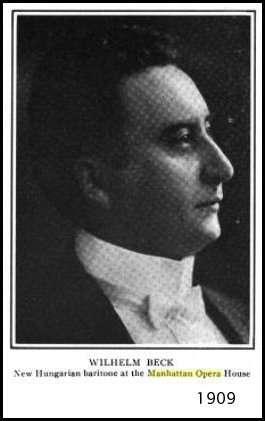 Otthon -- December 06, 1925
Otthon -- December 06, 1925William Beck, Hungarian Opera Singer Found Dead The news of the death of William Beck caused great consternation in Chicago and especially among the Hungarians. Everyone loved Beck, who has been with the Chicago Opera for the last fourteen years. Everyone was surprised to hear of his sudden death, because he had not been ill and sang his part in "Madame Butterfly" perfectly Sunday. Monday evening he was to sing the part of Vitellius in "Herodiade." When the performance started and Beck didn't appear, the manager sent the call-boy for him to his hotel. In the meantime, Desire Defrere, also a baritone, took his place on the stage. The call-boy went to Beck's room at the Auditorium Hotel, knocked on the door and received no answer. He tried to open the door and succeeded, because it wasn't locked. The singer was lying on his bed motionless. The boy thought he was just ill and called the house physician, who pronounced Beck dead, probable cause, heart failure. As Beck was a bachelor,with no known relatives, the Opera Company wanted to bury him. At this time Benjamin Ehrlich, an attorney, appeared, saying that he was Beck's best friend and he demanded that an inquest be made to find out whether Beck wasn't poisoned. Ehrlich said that the night before his death, Beck drank some wine at a party and complained soon after of illness. The funeral was postponed until Dec. 27. William Beck was fifty years old. He knew every opera ever written. Although he has no relatives in America, a million people mourn his death. |
And the claque made its presence felt. Singers were threatened with violence if they did not hire certain applauders. A notice appeared backstage which stated, "Ignore cajolery, but if direct threats are made to you, please inform the management." Chicago's widely-known reputation continues in some part even today. A recent [1974] television special about one of the triumphant tours of the Chicago Symphony with Sir Georg Solti was entitled, "Real Violins in their Cases."
But to get back once again to Mary Garden... She continued to sing with the company until 1931. It happened that Jongleur was her last appearance in Chicago, and it closed the 1930-31 season. She later said that during the opera, while others were singing, she sat by herself in one corner of the stage, and before she realized it she was talking to herself, or rather to the little boy she was playing. "Dear little Jongleur," she said, "you've performed all your little stunts. Everything you had you've given to the Virgin. Now your work is done." Then, turning to herself, she thought, "I, Mary Garden, have given twenty of the best years of my life to my work here in Chicago, and I've given everything to the people as well as I could, and now I think I'll go." When the curtain fell, she went to her dressing room, gathered her things together, returned to her hotel, and without saying good-bye to anyone, left the city. When she got back to Paris, she cabled the manager of the company, "My career in America is over."
During those twenty years, her name became virtually synonymous with the Chicago Opera, and her departure seemed to foreshadow the dark days ahead. With her, she took the great golden era of opera in Chicago. Garden caused more excitement on the operatic scene in Chicago -- both onstage and off -- than any other personality in the company's history. Her career began and ended in controversy, and she was never very long out of the newspapers. James Gibbons Huneker once called her, "A condor, an eagle, a peacock, a nightingale, a panther, a society dame, a gallery of moving pictures, a siren, an indomitable fighter, a human woman with a heart as big as a house, a lover of sport, a canny Scotch lassie -- a superwoman, that is Mary Garden."
* *
* * *
A few notes should be made regarding the chart of Massenet operas done in Chicago from 1910-1932. The reason for the seasons included and excluded have been mentioned before. It was also noted that there was no opera in 1914-15. The only season with no operas of Massenet was 1926-27. Two of his operas are short enough to allow something else on the evening's bill: Jongleur and Navarraise. Jongleur was done in twelve seasons, and in five of them there was nothing else at that performance. In three seasons the evening was filled out with a ballet after the opera. In the first two seasons, the opera was paired with Il Segreto di Suzanne (with Sammarco and White) and once with A Lover's Quarrel (with Sammarco and Zeppilli). Suzanne, incidentally, was also paired with a couple of other short works in the 1912 season. In 1917-18, Jongleur was done with The Daughter of the Forest by Nevin, and in its final appearance in 1930-31, the two short Massenet operas were done together with Garden appearing in both. The only other season with Navarraise (1915-16) had it paired with Pagliacci. That season, by the way, was the only one in which Mary Garden did not appear in Chicago.
It should also be noted that there are sometimes changes in casting from performance to performance, and these are mostly now reflected in the chart. [This was not done in the original published version.] Some of the names are completely unfamiliar to most people these days, but the biographies and photos which are now included on this webpage should help to introduce everyone to these forgotten artists, and bring the entire company -- or at least the French wing -- back together in this new, electronic way. One further note. There were several Gala Evenings during those years when scenes or acts of operas were given. Massenet's scores were represented in approximately the same proportion in which they were done in the rest of the season, which means a goodly helping. These have not been noted in the chart, however.
As I mentioned at the beginning, the task of compiling and sorting these operas was both immensely rewarding and excruciatingly frustrating. I hope that those who read this will enjoy what I have found, and will tingle just a bit at the glorious echoes which, some scientists say, will rustle around the universe forever.
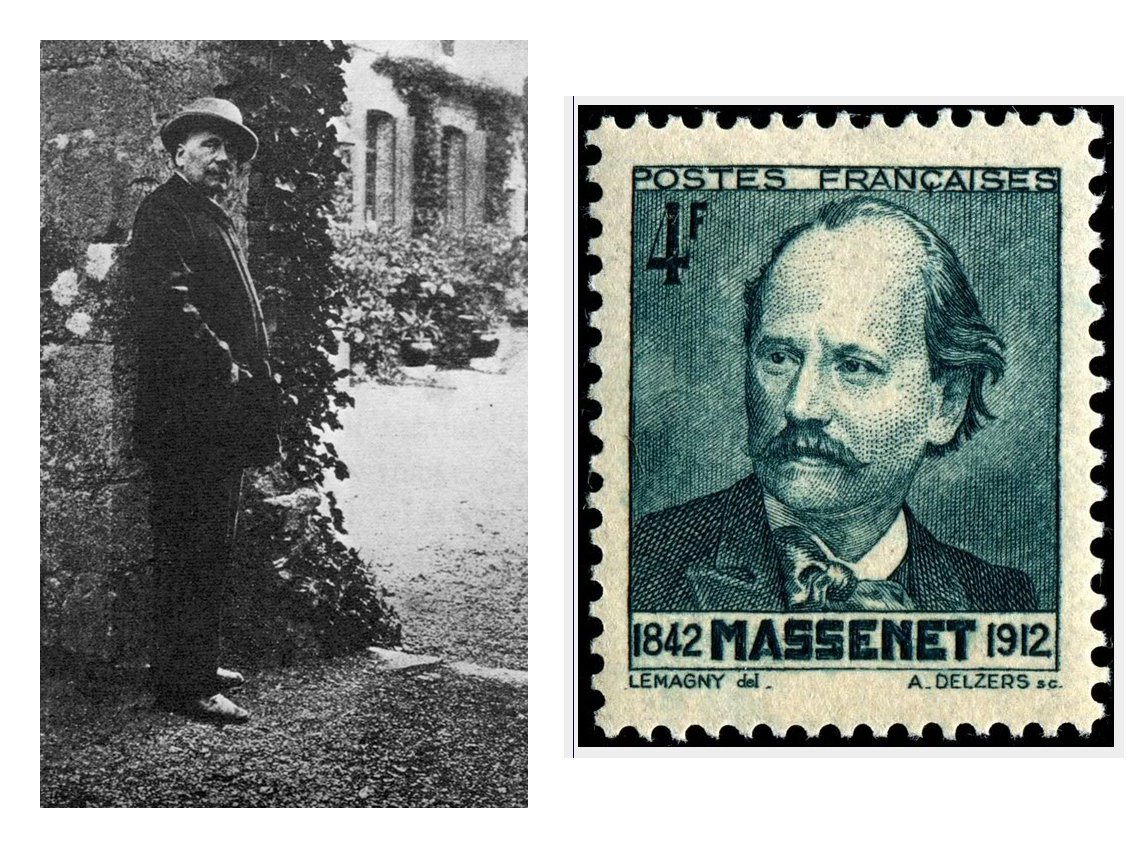
Operas of Massenet done by Resident Companies
in Chicago 1910-1932
(with a prologue showing the beginnings of the company in New York)
(with a prologue showing the beginnings of the company in New York)
| ///////////// |
Thaïs |
Jongleur |
Cendrillon |
Hérodiade |
Don Quichotte |
Manon |
Werther |
Navarraise |
Cléopâtre |
Grisélidis |
Sapho |
| Cast of characters in the opera |
Thaïs Athanaël Nicias Paalemon |
(Other work - if any) Jean Boniface Prior Monk Poet Monk Painter Monk Sculptor Monk Musician |
Cendrillon Prince Pandolphe King Mme. Haltiere Pleasure Supt. Prime Minister |
Hérodiade
Hérode Salomé Jean Vitellius Phanuel High Priest |
Don Quichotte Sancho Dulcinée |
Manon
Des Grieux Lescaut Comte Guillot De Brétigny |
Charlotte
Werther Albert Sophia Bailiff |
(Other work - if any) Anita Araguil Garrido Ramon Bustamente Remigio |
Cléopâtre
Spakos Ennius Marc Antoine |
Grisélidis
Alain Marquis Devil Gondebaud Bertrade |
Fanny Jean Caoudal Divonne Cesaire |
| Oscar Hammerstein's
Manhattan Opera Company |
|||||||||||
| 1906-07 |
Note:
There was no doubling of roles in Jongleur.
Some singers would, however, sing various roles in separate performances. |
During the seasons 1906-09, all of the performances with Garden,
as well as most of the other French repertoire (including Navarraise), were conducted by Cleofonte Campanini. During the final season of 1909-10, the conductor for all of these operas was Henriquez De la Fuente. |
(w/Pagliacci) Calvé Dalmorès Arimondi Altchevsky Gilbert Seveilhac/Gianoli-Galletti |
||||||||
| 1907-08 |
Garden Renaud Dalmorès Mugnoz |
Garden also sang Louise and Pelléas et Mélisande |
(w/Pagliacci) Gerville-Réache Dalmorès Arimondi Crabbé Gianoli-Galletti ? |
||||||||
| 1908-09 |
Garden Renaud [Cazauran]/Dalmorès/Vallès Vieuille/DeGrazia |
(alone) Garden Renaud Dufranne Vallès De Segurola Vieuille Crabbé |
Garden also sang Louise, Salome, and Pelléas et Mélisande. At one performance of Thaïs, Misha Elman played the Meditation with the orchestra. |
(w/Pagliacci) Gerville-Réache Vallès Dufranne Crabbé Gianoli-Galletti Vieuille |
|||||||
| 1909-10 |
Garden Renaud Vallès/Dalmorès/Lucas Scott |
(alone) Garden/Devriès (tenor) Renaud/Gilbert/Dufranne Dufranne/Huberdeau Lucas Laskin/Scott Huberdeau/Scott Crabbé/Scott |
Gerville-Réache/Doria/D'Alvarez Renaud Cavalieri/Mazarin Dalmorès/Duffault/Lucas Crabbé/Dufour Vallier Nicolay |
Garden also sang Faust, Salome, and Pelléas et Mélisande, and organized a benefit concert for Paris Flood sufferers, singing scenes from Roméo et Juliette, Thaïs and Manon. |
(w/Pagliacci) Gerville-Réache Dalmorès/Devriès Dufranne Crabbé Nicolay Huberdeau |
Garden Dalmorès Dufranne Scott Huberdeau Duchène |
Garden Dalmorès Dufranne D'Alvarez/Soyer Leroux |
||||
| The company moves to
the Windy City and becomes the Chicago Grand Opera Company |
|||||||||||
| 1910-11 |
Garden Renaud/Dufranne Dalmorès/Warnery Huberdeau/Nicolay |
Garden also sang Pelléas
et Mélisande, Salome, Louise, and Faust. From 1910-1917, all Massenet operas were conducted by Campanini, except as noted. |
Note: The Chicago reference being used for this section of the chart often lists fewer characters than the Manhattan reference used above. |
||||||||
| 1911-12 |
Garden Dufranne Dalmores/Warnery Huberdeau/Nicolay |
(w/Segreto) Garden Dufranne Huberdeau Warnery Scott Preisch/Nicolay Crabbé |
Teyte/Zeppilli Garden Dufranne Scott Berat Defrère Nicolay |
Garden also sang Carmen and Natoma by Victor Herbert. |
|||||||
| 1912-13 |
Garden Dufranne Warnery Huberdeau |
(w/Segreto) Garden Dufranne Huberdeau Warnery Scott Nicolay Crabbé |
Teyte/Zeppilli Darch/Stanley Dufranne/Warnery Huberdeau/Scott Berat Defrère Nicolay |
de Cisneros Dalmorès White Mascal Huberdeau [Phanuel] |
Garden also sang Louise,
Carmen, and Tosca - which she sang in French (except
forthe aria Vissi d'arte) while
the rest of the cast sang in Italian! Marcel Charlier conducted Cendrillon and Hérodiade. |
||||||
| 1913-14 |
Garden Ruffo/Dufranne Dalmores/Warnery Huberdeau |
(alone) Garden Dufranne Huberdeau |
Claussen Dalmorès White Crabbé Huberdeau [Phanuel] |
Vanni-Marcoux Dufranne Garden |
Garden Muratore Dufranne Huberdeau |
Garden also sang Louise, Tosca, and Monna Vanna. Charlier conducted Manon. |
|||||
| 1914-15 |
No
season, after which the company is re-formed and named the Chicago Opera
Association |
||||||||||
|
1915-16 |
Kuznietsov Dufranne Dalmores Nicolay |
Because the re-organization of the resident opera company was so late, Garden was unable to accept any Chicago engagements during this season. Charlier conducted Navarraise; Rodolfo Ferrari led Werther. |
Supervia Muratore Dufranne Sharlow Nicolay |
(w/Pagliacci) Claussen Dalmores Arimondi |
Kuznietsov Dalmores Journet Maguenat |
||||||
| 1916-17 |
Garden Dufranne Dalmores Nicolay |
(alone) Garden Dufranne Journet |
Claessens Dalmorès Amsden Beck Journet Nicolay |
Amsden Muratore Maguenat Journet |
Garden also sang Carmen, and Louise. Charlier conduced Hérodiade and Manon. |
Garden ? Dufranne Journet Maguenat Berat |
|||||
| 1917-18 |
Garden Dufranne Dalmores Huberdeau |
(w/A Daughter of the Forest) Vix Dufranne Huberdeau |
Garden was delayed in Paris until the last three weeks of the season, so Geneviève Vix took over most of her French roles. Besides Thaïs, Garden sang Carmen, Monna Vanna, and Pelléas et Mélisande. |
Vix Muratore Maguenat Huberdeau Dua Defrère |
From 1917-1920, all Massenet operas
were conducted by Charlier unless otherwise noted. |
Vix Dalmores Dufranne Berat |
|||||
| 1918-19 |
Gall Journet Lamont Huberdeau |
Garden also sang Monna Vanna and Gismonda, both by Henry Février, and Carmen. Louis Hasselmans conducted Thaïs, Werther, and Manon. |
Gall Fontaine Maguenat Huberdeau Dua Defrère |
Pavloska Muratore/O'Sullivan Maguenat Sharlow Huberdeau |
Garden Fontaine Journet Maguenat |
||||||
| 1919-20 |
Garden Baklanoff Fontaine Huberdeau |
(alone) Garden Dufranne Huberdeau |
D'Alvarez O'Sullivan/Fontaine Gall Maguenat Defrère Cotreuil |
Gall Schipa Maguenat Huberdeau Warnery Defrère |
Garden also sang Carmen, Pelléas et Mélisand, Monna Vanna, L'Amore dei Tre Re, and Louise. |
Garden Fontaine Huberdeau Maguenat |
Hasselmans conducted Thaïs. Gino Marinuzzi led Manon. |
||||
| 1920-21 |
Garden sang Aphrodite by Camille Erlanger, Monna Vanna, Carmen, Faust, and L'Amore dei Tre Re. Henri Morin conducted Manon. |
Gall Muratore Dufranne Cotreuil Defrère Nicolay |
|||||||||
| The Company is re-named the Chicago Civic Opera |
|||||||||||
1921-22 |
Namara/Garden Dufranne/Cotreuil Martin Nicolay |
(w/ballet) Garden Dufranne Payan |
Garden also sang Monna Vanna,
Carmen, Salome, L'Amore dei Tre Re, Pelléas et Mélisande, and Louise. From 1921-30, all Massenet operas were conducted by Giorgio Polacco unless otherwise noted. Gabriel Grovlez conducted Manon and Thaïs. |
Mason Muratore Maguenat Payan Dua Defrère |
During this season, Garden ran the company as the General Director, or as she called it, "Directa," as well as singing various roles. |
||||||
| 1922-23 |
Garden sang Carmen, L'Amore dei Tre Re, and Tosca. Richard Hageman conducted Manon. |
Galli-Curci Schipa Defrère Cotreuil Mojica Beck |
|||||||||
| 1923-24 |
Garden Cotreuil Mojica Kipnis |
(alone) Garden Cotreuil Kipnis Mojica Beck Lazzari Defrère |
Garden also sang Louise, and Carmen. Ettore Panizza conducted Manon, Cléopâtre, and Thaïs |
Mason Ansseau Defrère Cotreuil Mojica Beck |
Garden Defrère Cotreuil Baklanoff |
||||||
| 1924-25 |
Garden Schwarz/Cotreuil Mojica Kipnis/Nicolich Swarthout as Myrtale |
(alone) Garden Cotreuil Kipnis Mojica Beck Nicolich Defrère |
Garden also sang Carmen, L'Amore dei Tre Re, Louise, and Pelléas et Mélisande. Roberto Moranzoni conducted Thaïs. |
Garden Ansseau Kipnis Freund Cotreuil |
|||||||
| 1925-26 |
Van Gordon Ansseau Mason Bonelli Beck Cotreuil Nicolich |
Garden Ansseau Kipnis Freund Cotreuil |
Garden also sang Pelléas et Mélisande, Carmen, Louise, and Resurrection by Franco Alfano. Gabriel Grovlez conducted Hérodiade. |
||||||||
| 1926-27 | (No Massenet operas were done this season) [Garden sang Resurrection, Carmen, L'Amore dei Tre Re, Tosca, and Judith by Arthur Honegger.] | ||||||||||
| 1927-28 |
(w/ballet) Garden Formichi Cotreuil |
Garden also sang Monna Vanna, Carmen, Louise, and Resurrection. Both Polacco and Lauwers conducted performances of Sapho in this season and the next. |
Garden Ansseau/Maison Defrère Claessens Cotreuil |
||||||||
| 1928-29 |
Garden Formichi Mojica Nicolich |
Garden also sang L'Amore dei
Tre Re, Pelléas et Mélisande, and Judith. Moranzoni conducted Thaïs. |
Garden Maison ? Claessens |
||||||||
| 1929-30 |
Garden Vanni-Marcoux/Formichi Mojica Nicolich |
(w/ballet) Garden Formichi Cotreuil Ritch Ringling Nicolich Defrère |
Vanni-Marcoux Cotreuil Glade |
Garden also sang L'Amore dei Tre Re, Louise, and Pelléas et Mélisande. Moranzoni conducted Thaïs. Emil Cooper conducted Don Quichotte. |
|||||||
| 1930-31 |
(w/Navaraise) Garden Formichi Baromeo |
Garden also sang Resurrection,
Pelléas et Mélisande, and Camille by Hamilton Forrest. Charles Lauwers conducted Jongleur. Cooper conducted all the rest of the Massenet operas this season and the next. |
McCormic Hackett Vieulle Coutreuil Dua Defrère/Ringling |
(w/Jongleur) Garden Maison Ritch ? Cotreuil |
A performance of Jongleur (w/ballet) closed the season, and ended Mary Garden's career in Chicago. |
||||||
1931-32 |
Olszewska Maison McCormic Thomas Defrère Baromeo Benoni |
||||||||||
|
Epilogue There was no season in 1932-33. The company was reconstituted as the Chicago Grand Opera Company (again) for 1933-35, with significantly shorter seasons - just a few weeks in the fall starting in 1934. The company was called the Chicago City Opera from 1936-39, and the Chicago Opera Company from 1940-46, with no season in 1943. 1947-53 was the "dark period" before the Lyric Theater was formed in 1954. After a couple of years it was re-named Lyric Opera which enjoys a long and continuous chapter of opera in the Windy City. Between 1933 and 1947, the only two Massenet operas done were Manon and Thaïs. A single performance of Manon in 1933-34 had Marion Claire, Dino Borgioli and Desiré Defrère. The conductor, Henry Weber, was married to Claire, the third instance of a long-time Chicago opera conductor wedded to a significant soprano! [Previous pairs were Cleofonte Campanini & Luisa Tetrazzini, and Giorgio Polacco & Edith Mason.] Helen Jepson sang both Massenet operas, as well as two other Garden specialties -- Louise and L'Amore dei Tre Re -- in various seasons between 1935 and 1942. Thaïs of 1935, 1936 and 1937 also featured John Charles Thomas as Athanaël, and Martin as Nicias. Hageman and Hasselmans conducted. The Manon of 1940 featured Dorothy Kirsten as Pousette! Grace Moore also sang Manon and L'Amore dei Tre Re in the years 1937-39, and Elen Dosia also sang Manon in those three seasons. Maria Jeritza was Salome in 1934, and Marjorie Lawrence sang the role in 1940, Bidú Sayão was Mélisande and Manon in 1944 and 1945 respectively. There were a few other French works scattered in these seasons, but nothing like the period in the chart above. |
|||||||||||
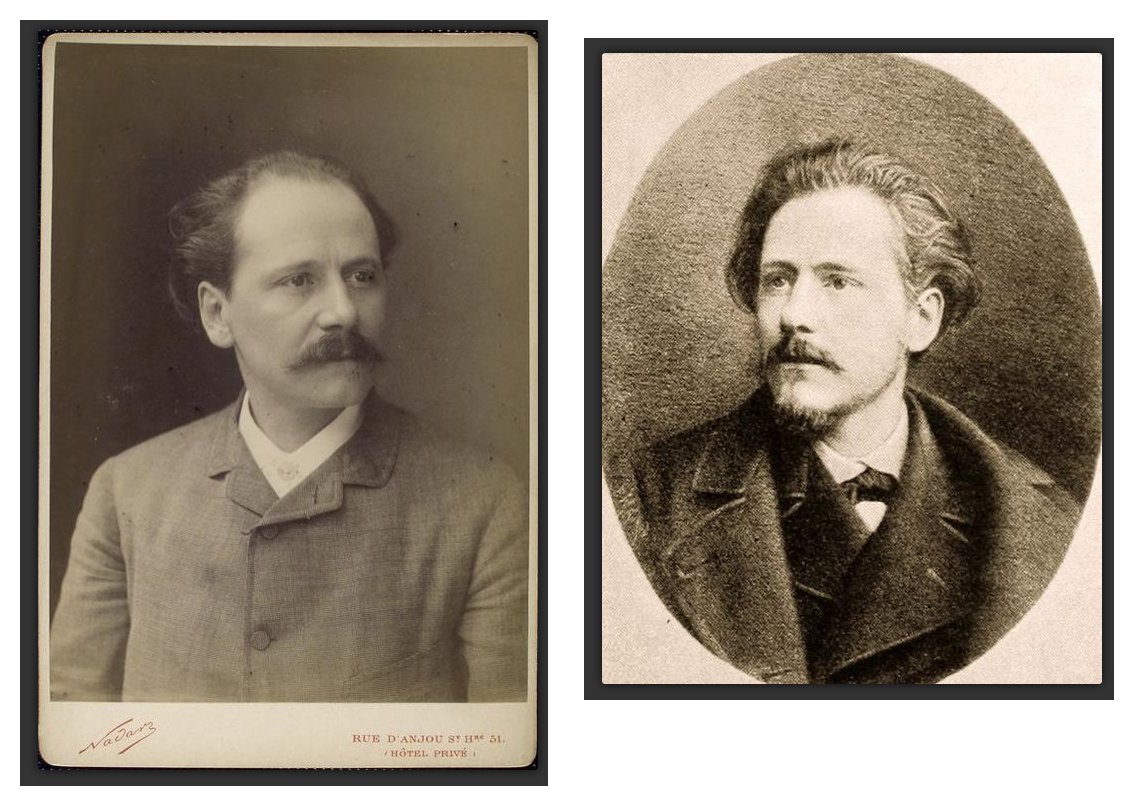
Performances on Tour 1907-29
(Casts and conductors were very much the same as in Manhattan and Chicago)
(Casts and conductors were very much the same as in Manhattan and Chicago)
| ///////////// |
Thaïs |
Jongleur |
Cendrillon |
Hérodiade |
Don Quichotte |
Manon |
Werther |
Navarraise |
Cléopâtre |
Grisélidis |
Sapho |
| Oscar Hammerstein's
Manhattan Opera Company |
|||||||||||
| 1907-08 |
No Massenet operas were done on tour this season. Garden
sang Louise in Philadelphia conducted
by Campanini. |
||||||||||
| 1908-09 |
Philadelphia Boston |
Philadelphia Boston |
Garden also sang Louise,
Salome, and Pelléas et Mélisande. Campanini, Sturani, and Charlier each conducted some performances |
(w/Pagliacci) Philadelphia Boston |
|||||||
| 1909-10 |
Washington |
Philadelphia Pittsburgh Washington Boston |
Philadelphia |
Garden also sang Faust,
Louise, and Pelléas
et Mélisande, plus Act III of Roméo
et Juliette at the closing Gala. Nicosia, Sturani, De la Fuente and Charlier each conducted some performances. |
(w/.Fille du Regiment; or w/Pagliacci) Philadelphia Boston |
Philadelphia Boston |
Philadelphia Pittsburgh Cincinnati |
||||
| The company moves to
the Windy City and becomes the Chicago Grand Opera Company |
|||||||||||
| 1910-11 |
Baltimore Brooklyn Milwaukee New York City Philadelphia |
(w/Segreto) Baltimore New York City Philadelphia |
There were also performances in various cities of Carmen, Salome, Louise, Pelléas et Mélisande, and Natoma by Victor Herbert. As no cast lists are printed in the reference used, it can be assumed that the casts were the same or very similar, so Garden probably appeared in most or all of these operas. |
||||||||
| 1911-12 |
Baltimore Cleveland Philadelphia St. Louis |
(w/Segreto) New York City Philadelphia St. Paul, MN |
New
York City Philadelphia |
There were also performances of Pelléas et Mélisande, Louise, and Natoma. |
|||||||
| 1912-13 |
Butte,
MT Dallas Denver Kansas City, MO Los Angeles Minneapolis New York City Philadelphia Portland, OR San Diego, CA San Francisco Seattle Spokane, WA |
(w/Segreto or w/ Lover's Quarrel) Cincinnati Milwaukee Minneapolis Philadelphia St. Louis San Fraancisco |
Philadelphia |
There were also performances of Louise, Natoma, and Salome. |
|||||||
| 1913-14 |
Des
Moines, IA Omaha, NE Philadelphia St. Joseph, MO San Francisco Witchita, KS |
Kansas
City, MO Los Angeles |
Philadelphia San Francisco |
New York
City Philadelphia |
Philadelphia St. Paul, MN |
There were also performances of Louise, Monna Vanna, and Natoma |
|||||
| 1914-15 |
No
season, after which the company is re-formed and named the Chicago Opera
Association |
||||||||||
| 1915-17 |
There were no tours by the company during these
two seasons. |
||||||||||
| 1917-18 |
Boston New York City |
(w/Cavalleria) New York City |
There were also performances of Louise, Monna Vanna, and Pelléas et Mélisande. |
New York |
|||||||
| 1918-19 |
Detroit New York City Philadelphia Pittsburgh |
(w/ballet) New York City |
There were also performances of Monna Vanna, Carmen, and Pelléas et Mélisande. |
New York |
New York |
New
York City Philadelphia |
New York |
||||
| 1919-20 |
Boston New York City |
New
York City |
New York City |
There were also performances of Aphrodite by Camille Erlanger, Gismonda by Henry Février, Pelléas et Mélisande,
Louise, and L'Amore dei Tre Re.
|
|||||||
| 1920-21 |
New
York City San Francisco Tulsa, OK |
New York City |
There were also performances of Monna Vanna, Carmen, and L'Amore dei Tre Re. |
New York |
|||||||
| The Company is re-named the Chicago Civic Opera |
|||||||||||
1921-22 |
Dallas Helena, MT Los Angeles New York City Portland, OR St. Paul, MN San Antonio, TX |
Philadelphia |
There were also performanes of Monna Vanna, L'Amore dei Tre Re, Salome, Pelléas et Mélisande, and Louise. |
New York |
During this season, Garden ran the company as the General Director, or as she called it, "Directa." |
||||||
| 1922-23 |
No Massenet operas were done on tour this season. There
were performances of Carmen, and
L'Amore dei Tre Re. |
||||||||||
| 1923-24 |
(w/.(Maestro) Boston |
There were also performances of Louise, Salome, and Carmen. |
Chattanooga,
TN Denver Los Angeles Pittsburgh Portland, OR San Francisco Tulsa, OK Witchita, KS |
||||||||
| 1924-25 |
Baltimore Boston Chattanooga, TN Cincinnati Cleveland Memphis Pittsburgh Washington, DC |
There were also performances of Carmen, L'Amore dei Tre Re, Louise, and Pelléas et Mélisande. |
|||||||||
| 1925-26 |
Birmingham,
AL Boston Buffalo, NY Miami |
Boston |
There were also performances of Louise, Pelléas et Mélisande, Carmen, and Resurrection by Franco Alfano. |
||||||||
| 1926-27 | No Massenet operas were done this season in Chicago or on tour.
There were performances of Resurrection,
Carmen, Pelléas et Mélisande, and
Judith by Arthur Honegger. |
||||||||||
| 1927-28 |
(w/ballet) Boston |
There were also performances of Carmen, Louise, and Resurrection. |
Boston Fresno, CA Los Angeles |
||||||||
| 1928-29 |
Amarillo,
TX Boston Columbus, OH Detroit El Paso, TX Jackson, MS Los Angeles Minneapolis Nashville Oakland, CA Phoenix, AZ Sacramento, CA Tulsa, OK |
There were also performances of Judith and L'Amore dei Tre Re. |
|||||||||
| There were tours during
the final three seasons of 1929-32, but I do not currently have access to
those records. |
|||||||||||
Some programs and illustrations
of Massenet operas
mostly from the Chicago Opera during this period
(and presented here in the same order as in the chart above!)
mostly from the Chicago Opera during this period
(and presented here in the same order as in the chart above!)
Unless otherwise noted, all photographs
are of Mary Garden
in the specific opera being illustrated.
in the specific opera being illustrated.
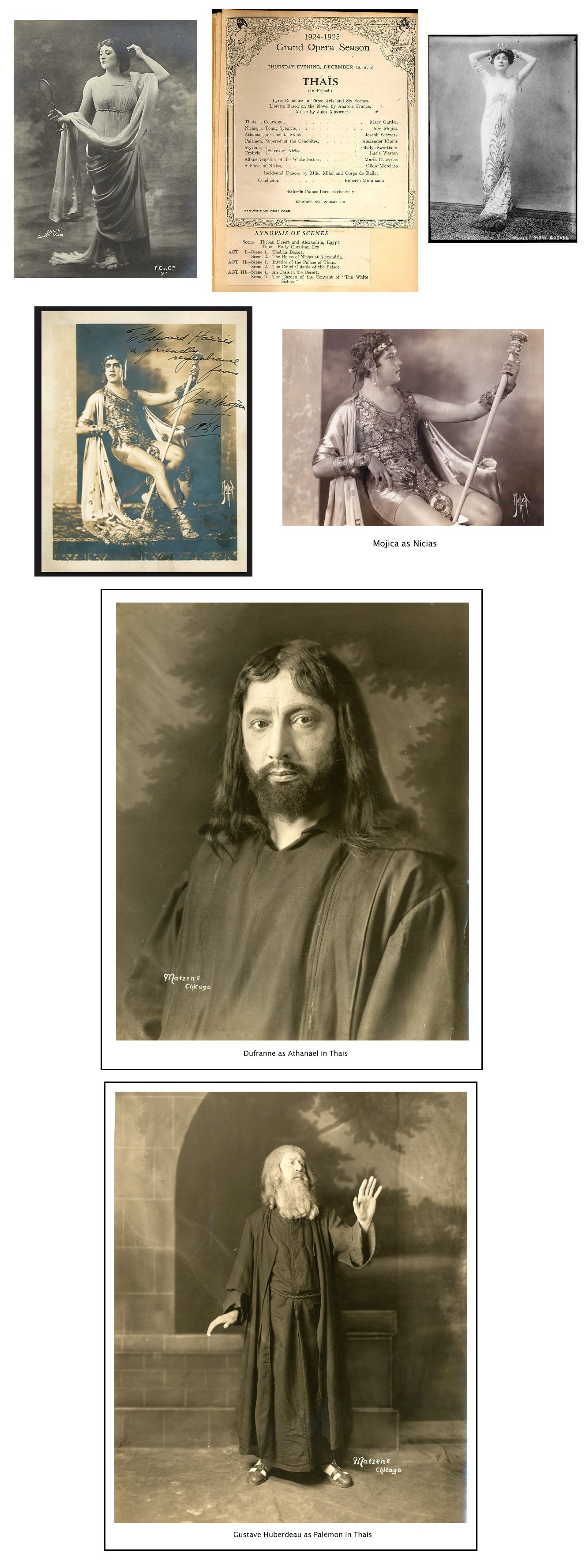
| [Writing of Louise...] There are other
ways of singing and acting this rôle. Others have sung and acted it,
others will sing and act it, effectively. The abandoned (almost aggressive)
perversity of Miss Garden's performance has perhaps not been equalled, but
this rôle does not belong to her as completely as do Thaïs and
Mélisande; no other interpreters will satisfy any one who has seen
her in these two parts. Miss Garden made her American début in Massenet's opera, Thaïs, written, by the way, for Sybil Sanderson. The date was November 25, 1907. Previous to this time Miss Garden had never sung this opera in Paris, but she had appeared in it during a summer season at one of the French watering places. Since that night, nearly ten years ago, however, it has become the most stable feature of her répertoire. She has sung it frequently in Paris, and during the long tours undertaken by the Chicago Opera Company this sentimental tale of the Alexandrian courtesan and the hermit of the desert has startled the inhabitants of hamlets in Iowa and California. It is a very brilliant scenic show, and is utterly successful as a vehicle for the exploitation of the charms of a fragrant personality. Miss Garden has found the part grateful; her very lovely figure is particularly well suited to the allurements of Grecian drapery, and the unwinding of her charms at the close of the first act is an event calculated to stir the sluggish blood of a hardened theatre-goer, let alone that of a Nebraska farmer. The play becomes the more vivid as it is obvious that the retiary meshes with which she ensnares Athanaël are strong enough to entangle any of us. Thaïs-become-nun — Evelyn Innes should have sung this character before she became Sister Teresa — is in violent contrast to these opening scenes, but the acts in the desert, as the Alexandrian strumpet wilts before the aroused passion of the monk, are carried through with equal skill by this artist who is an adept in her means of expression and expressiveness. The opera is sentimental, theatrical, and over its falsely constructed drama—a perversion of Anatole France's psychological tale—Massenet has overlaid as banal a coverlet of music as could well be devised by an eminent composer. "The bad fairies have given him [Massenet] only one gift," writes Pierre Lalo, "...the desire to please." It cannot be said that Miss Garden allows the music to affect her interpretation. She sings some of it, particularly her part in the duet in the desert, with considerable charm and warmth of tone. I have never cared very much for her singing of the mirror air, although she is dramatically admirable at this point; on the other hand, I have found her rendering of the farewell to Eros most pathetic in its tenderness. At times she has attacked the high notes, which fall in unison with the exposure of her attractions, with brilliancy; at other times she has avoided them altogether (it must be remembered that Miss Sanderson, for whom this opera was written, had a voice like the Tour Eiffel; she sang to G above the staff). But the general tone of her interpretation has not been weakened by the weakness of the music or by her inability to sing a good deal of it. Quite the contrary. I am sure she sings the part with more steadiness of tone than Milka Ternina ever commanded for Tosca, and her performance is equally unforgettable. -- From Interpreters by Carl Van Vechten (1917)
|
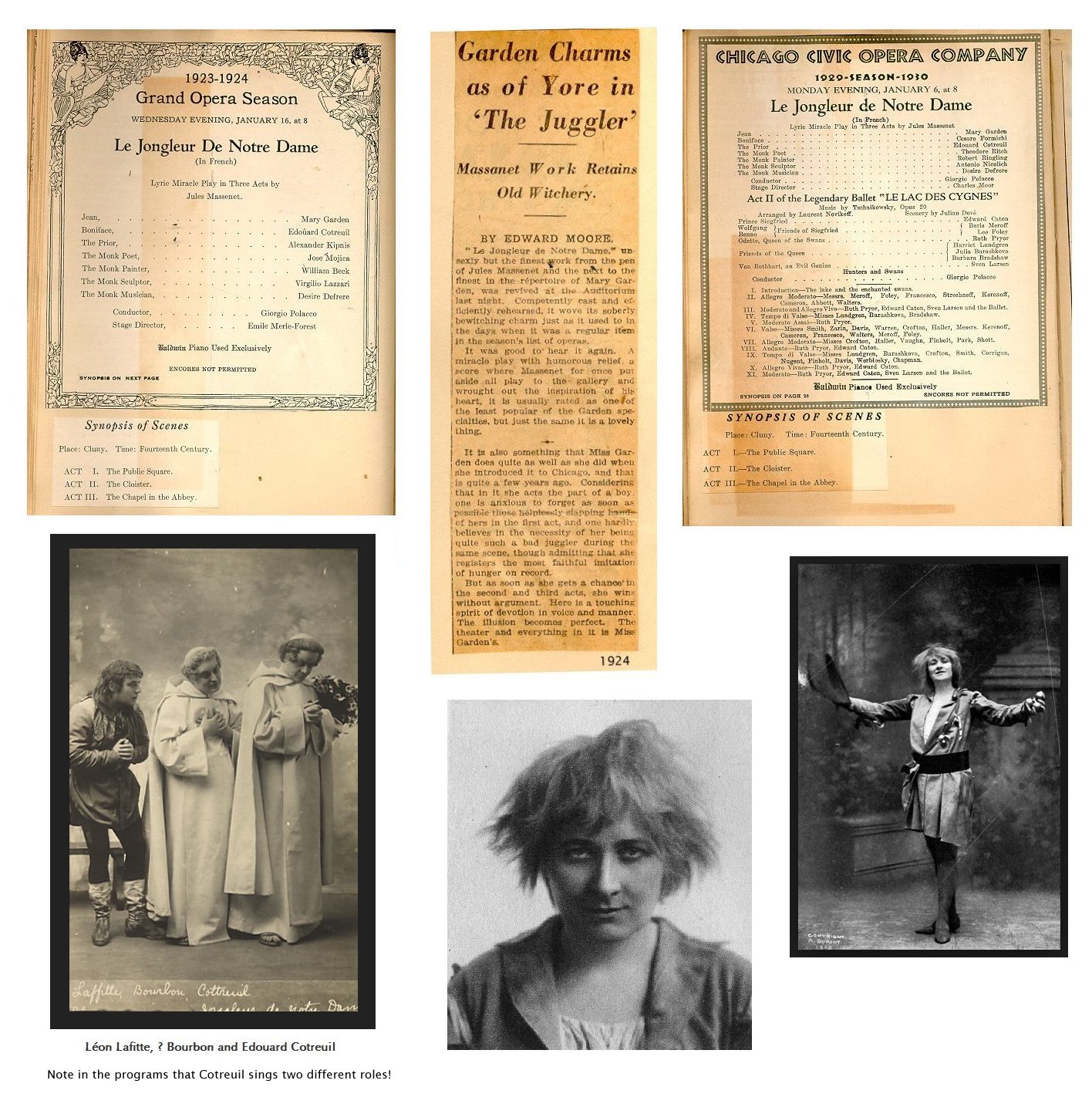
| The story has often been related how
Massenet, piqued by the frequently repeated assertion that his muse was only
at his command when he depicted female frailty, determined to write an opera
in which only one woman was to appear, and she was to be both mute and a
virgin! Le Jongleur de Notre Dame,
perhaps the most poetically conceived of Massenet's lyric dramas, was the
result of this decision. Until Mr. Hammerstein made up his mind to produce
the opera, the rôle of Jean had invariably been sung by a man. Mr.
Hammerstein thought that Americans would prefer a woman in the part. He easily
enlisted the interest of Miss Garden in this scheme, and Massenet, it is
said, consented to make certain changes in the score. The taste of the experiment
was doubtful, but it was one for which there had been much precedent. Nor
is it necessary to linger on Sarah Bernhardt's assumption of the rôles
of Hamlet, Shylock, and the Duc de Reichstadt. In the "golden period of song,"
Orfeo was not the only man's part sung by a woman. Mme. Pasta frequently
appeared as Romeo in Zingarelli's opera and as Tancredi, and she also sang
Otello on one occasion when Henrietta Sontag was the Desdemona. The rôle
of Orfeo, I believe, was written originally for a castrato, and later, when
the work was refurbished for production at what was then the Paris Opéra,
Gluck allotted the rôle to a tenor. Now it is sung by a woman as invariably
as are Stephano in Roméo et Juliette
and Siebel in Faust. There is really
more excuse for the masquerade of sex in Massenet's opera. The timid, pathetic
little juggler, ridiculous in his inefficiency, is a part for which tenors,
as they exist to-day, seem manifestly unsuited. And certainly no tenor could
hope to make the appeal in the part that Mary Garden did. In the second act
she found it difficult to entirely conceal the suggestion of her sex under
the monk's robe, but the sad little figure of the first act and the adorable
juggler of the last, performing his imbecile tricks before Our Lady's altar,
were triumphant details of an artistic impersonation; on the whole, one of
Miss Garden's most moving performances. -- From Interpreters by Carl Van Vechten (1917)
|
| Margaret
Tate was born in Wolverhampton, England, one of ten children of Jacob
James Tate, a successful wine and spirit merchant and proprietor of public
houses and later lodgings. Her parents were keen amateur musicians and opera
enthusiasts. She was the sister of composer James W. Tate. Her family moved
to London in 1898, where Teyte attended St. Joseph's Convent School, Snow
Hill, and later studied at the Royal School of Music. Her father died in 1903 and she went to Paris the following year to become a pupil of the celebrated tenor Jean de Reszke. She made her first public appearance in Paris in 1906 when she sang Cherubino in The Marriage of Figaro and Zerlina in Don Giovanni, both conducted by Reynaldo Hahn. Her professional debut took place at the Opera House in Monte Carlo on 1 February 1907, where she performed Tyrcis in Myriame et Daphné (André Bloch's arrangement of Jacques Offenbach's Daphnis et Chloé), with Paderewski. The following week, again at the Opera House in Monte Carlo, she sang Zerlina. 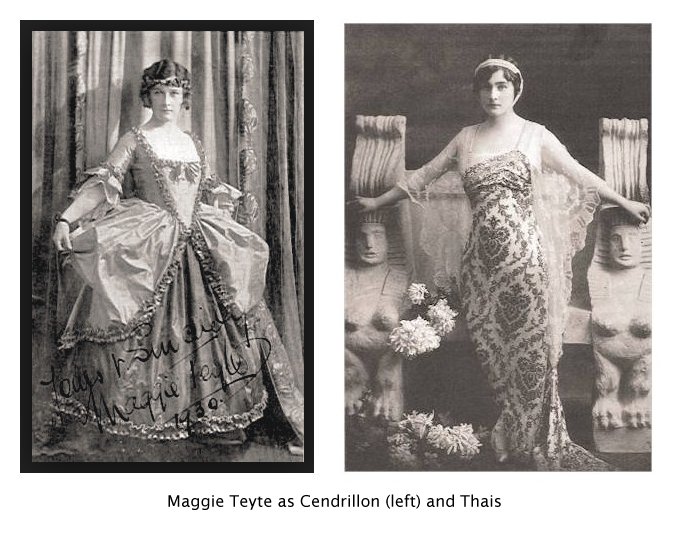
Finding that her surname was generally mispronounced in France, she changed it from Tate to Teyte before joining the Opéra-Comique in Paris. After a few small parts, she was cast as Mélisande in Pelléas et Mélisande by Debussy, replacing the originator of the role, Mary Garden. To prepare, she studied with Debussy himself, and she is the only singer ever to be accompanied by Debussy on the piano with an orchestra in public. In 1910, Sir Thomas Beecham cast Teyte as Cherubino and Mélisande and also as Blonde in Die Entführung aus dem Serail for his London season. Despite her early singing successes, Teyte did not easily establish herself in the main opera houses. Instead, she moved to America and performed with the Chicago Opera Company from 1911–1914 and the Boston Opera Company from 1914–17, singing in Philadelphia and elsewhere, but not in New York, though she created the title role in Henry Kimball Hadley's opera, Bianca, at Manhattan's Park Theater in 1918. Returning to Britain in 1919, she created the rôle of Lady Mary Carlisle in André Messager's operetta, Monsieur Beaucaire, at the Prince's Theatre. She married for a second time in 1921, to Canadian millionaire Sherwin Cottingham, and went into semi-retirement until 1930, when she performed as Mélisande and played Puccini's Madama Butterfly. After difficulty in reviving her career, she ended up performing music hall and variety (24 performances a week) at the Victoria Palace in London. Finally, in 1936, her recordings of Debussy songs accompanied by Alfred Cortot attracted attention, and recordings remained an important factor in her renewed fame, as she gained a reputation in England and the United States as the leading French art song interpreter of her time. She sang at the Royal Opera House in 1936–37 in Hansel and Gretel, as Eurydice in Gluck's Orfeo ed Euridice and as Butterfly in Madama Butterfly. In 1938–39 she broadcast performances of Massenet's Manon in English, in addition to Eva in Wagner's Die Meistersinger. She also appeared in operetta and musical comedy between the wars. She made her first New York appearances in 1948, including a Town Hall recital followed by performances of Pelléas at the New York City Center Opera. She continued to record and perform in opera until 1951, making her final appearance in the part of Belinda (to Kirsten Flagstad’s Dido) in Purcell's Dido and Aeneas at the Mermaid Theatre in London. Her final concert appearance was at the Royal Festival Hall on 22 April 1956, aged 68. She spent her last years teaching. She died in London in 1976, aged 88. |
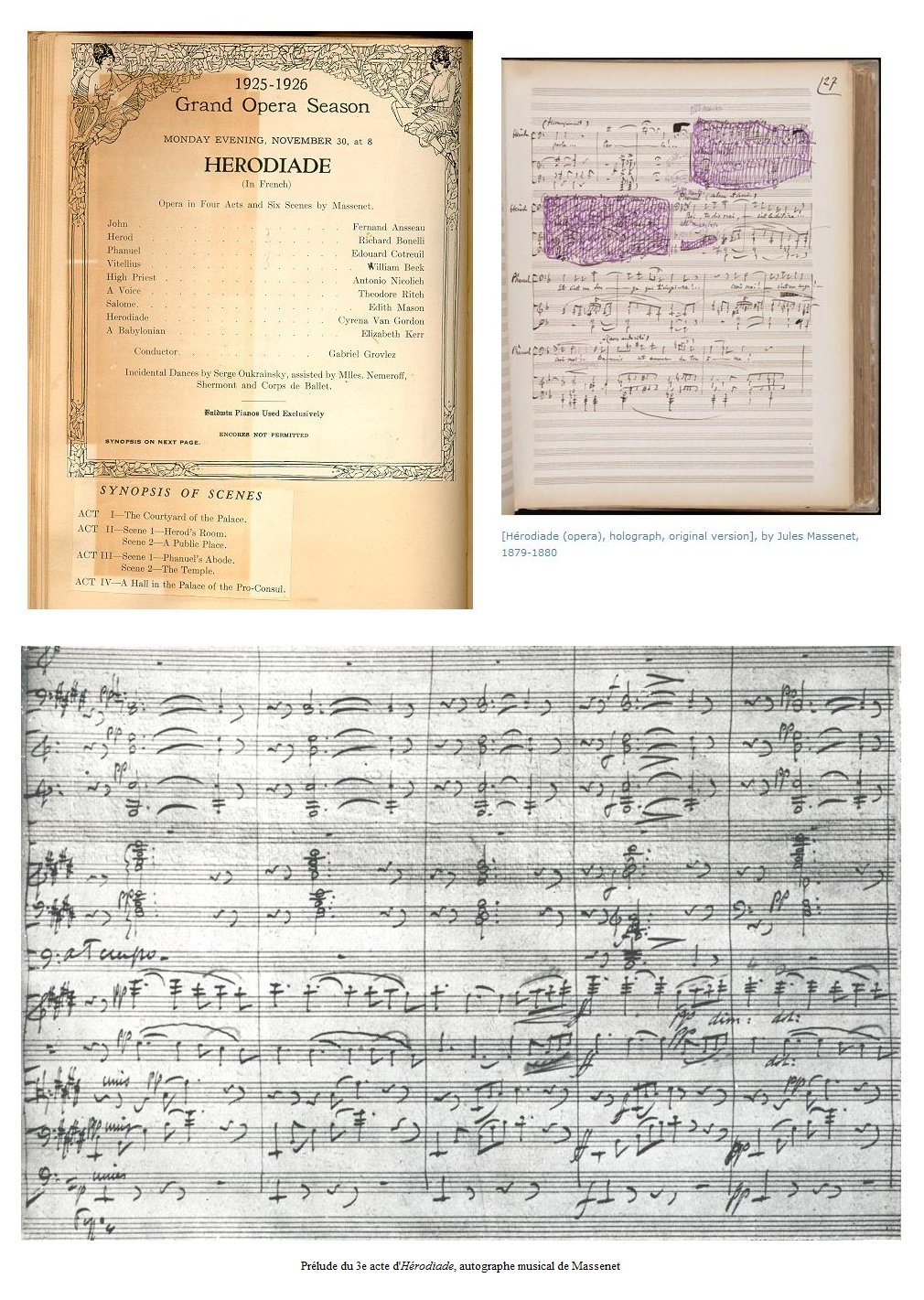
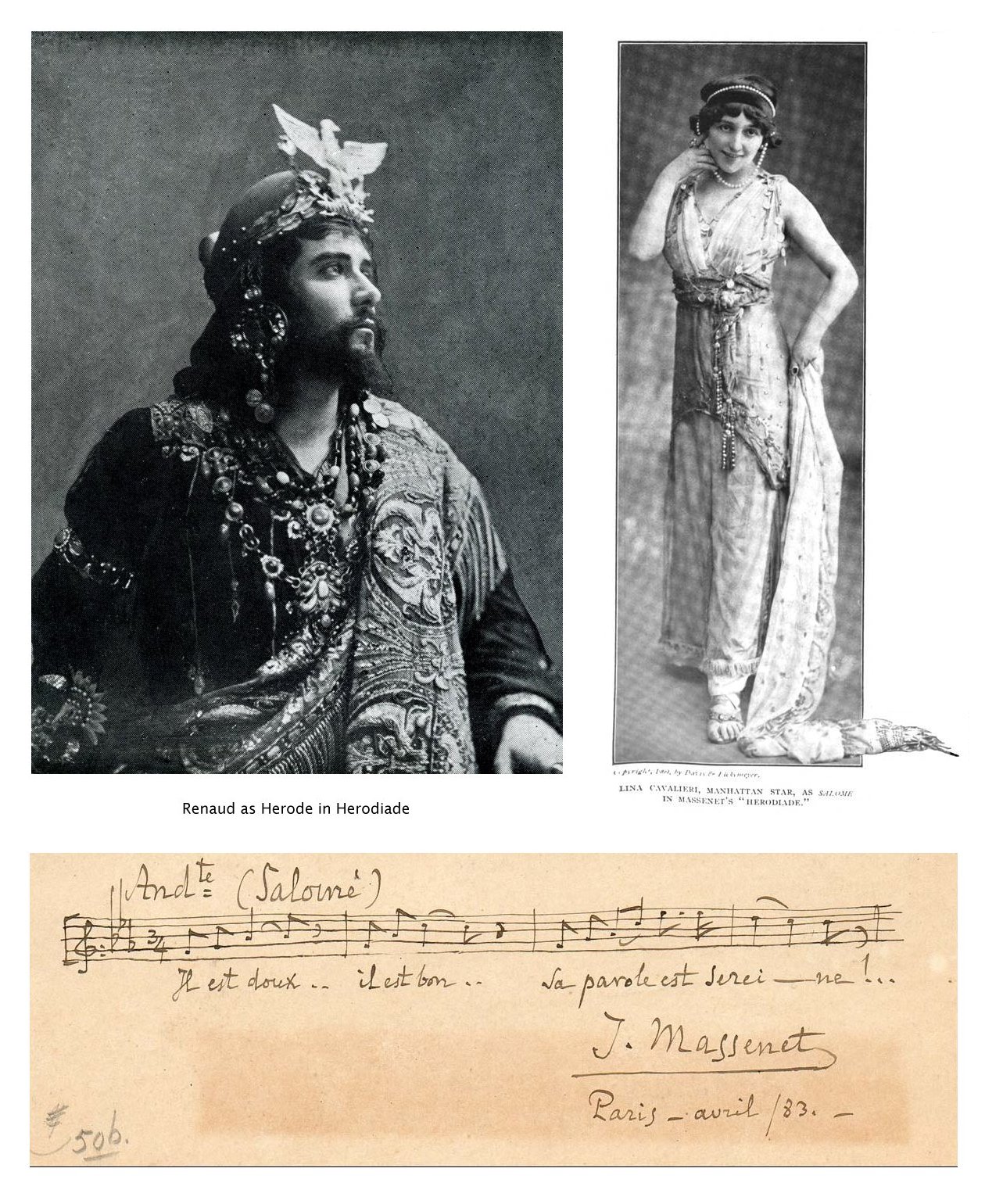
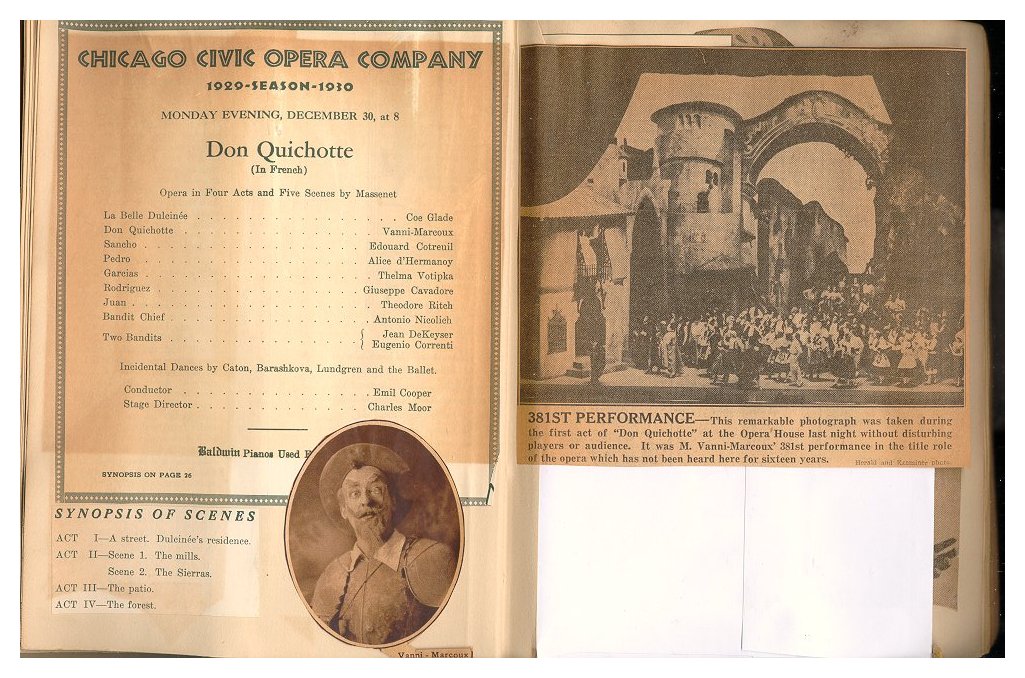
Vanni-Marcoux
was born Giovanni (Jean-Emile Diogène) Marcoux in 1877 in Turin. Vanni,
an Italian abbrevation for Giovanni, reminds us that he was the son of a French
father and an Italian mother. He studied with Collini at his hometown and
with Frédéric Boyer at the Paris Conservatoire. After successfully
completing law studies, Marcoux decided to devote himself full to singing.
His debut took place at Turin in 1894 as Sparafucile. It was not until 1899
that he made his first stage appearance in France, at Bayonne as Frère
Laurent. Thereafter he toured a number of provincial theatres and was a guest
at the La Monnaie in Brussels. In 1905 he debuted at Covent Garden as Basilio
and returned there every season until 1912, singing comprimario parts as
well as Colline and Sparafucile. Eventually he was given such parts
like Arkel, Marcel in Les Huguenots
and the Father in Charpentier’s Louise.
In 1909 he made his debut at the Opéra Paris, creating Guido Colonna
in Henri Février’s Monna Vanna,
a role which brought him fame. Three years later he appeared in the title
role of Massenet’s Don Quichotte
(probably his greatest achievement). Massenet wrote his opera Panurge especially for him. Its creation
took place in 1913. Before World War I Vanni-Marcoux was predominantly a
bass, singing even Hunding and Fafner. For nearly 40 years he was a familiar
and much admired figure in Parisian musical life, mainly at the Opéra,
but also at the Opéra-Comique, creating a number of roles in contemporary
operas such as Gunsbourg’s Lysistrata,
d’Olonne’s L’Arlequin, Février’s
Monna Vanna and La Femme nue, and Honegger-Ibert’s L’Aiglon. 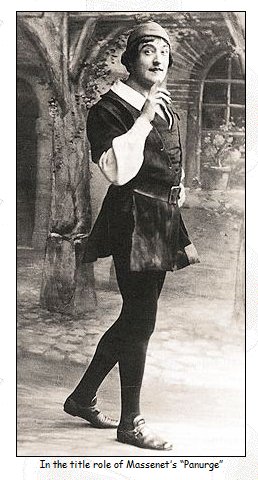
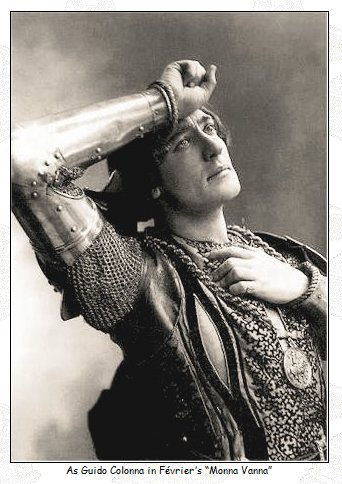
Subsequently he was engaged by Henry Russell to the Boston Opera where he established as a star. His first performance was in Pelléas et Mélisande, now as Golaud. His dramatic conception of Méphistophélès in Faust was also much admired by the public. The four roles in Les Contes d’Hoffmann (Coppélius, Dr. Miracle, Crespel, Dapertutto) belonged to his greatest histrionic achievements. Without doubt, Vanni-Marcoux owed much of his success in the United States to Mary Garden. Her popularisations of the works of the modern French composers soon provided him with all sort of dramatic opportunities. There was the rumour that he had divorced his second wife in order to marry Mary Garden. She declined, but she shared the stage with him in many performances of Thaïs, Tosca, Don Quichotte, Pelléas et Mélisande and Carmen. He followed her to Chicago in 1913 and was a regular guest there between 1926 and 1931. When Mary Garden finished her career, French opera could not survive without her, and thereafter there was no place for him. La Scala saw him as Boris (in French) under Arturo Toscanini and Sigismund Zaleski in 1922. He was generally regarded as the finest exponent of the role after Chaliapin. Paris invited him to sing the title role in the first French performance of Puccini’s Gianni Schicchi. From 1948 to 1951 Vanni-Marcoux was director of the Grand Théâtre at Bordeaux. He died in 1962. 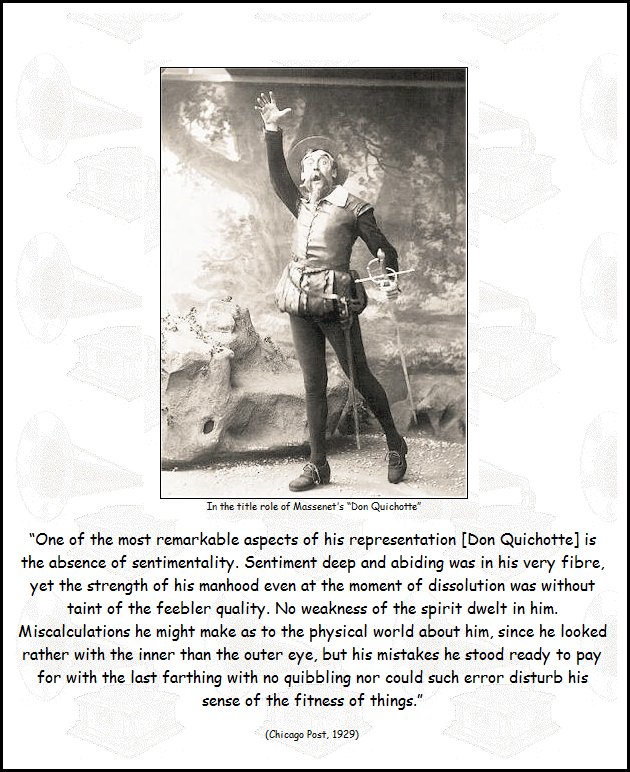
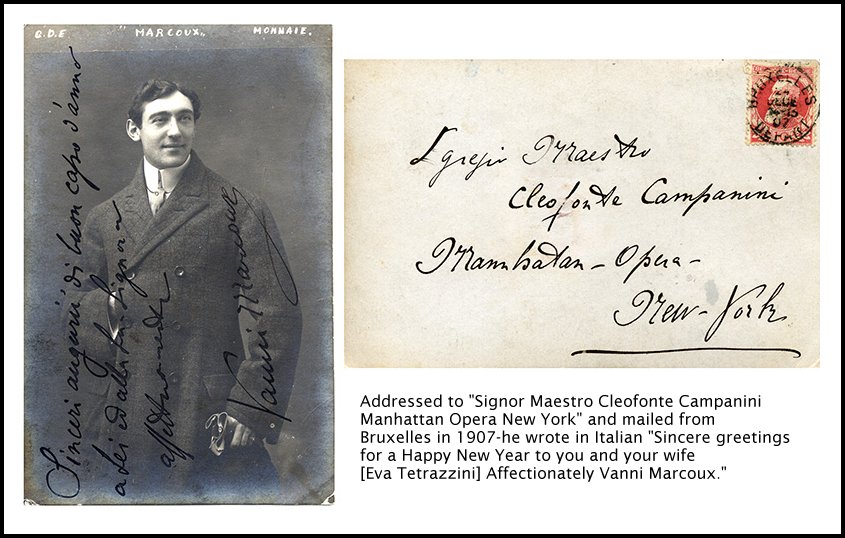
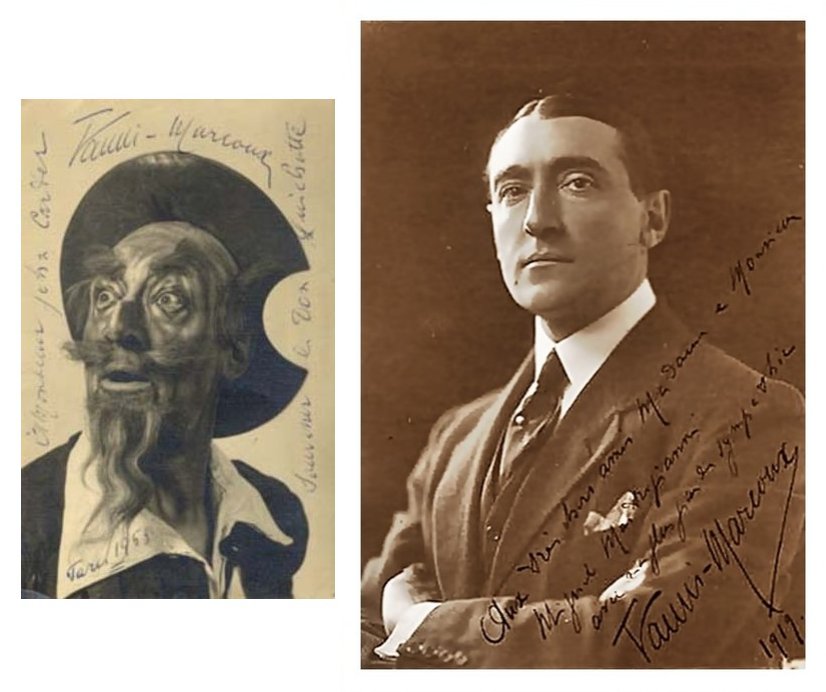
|
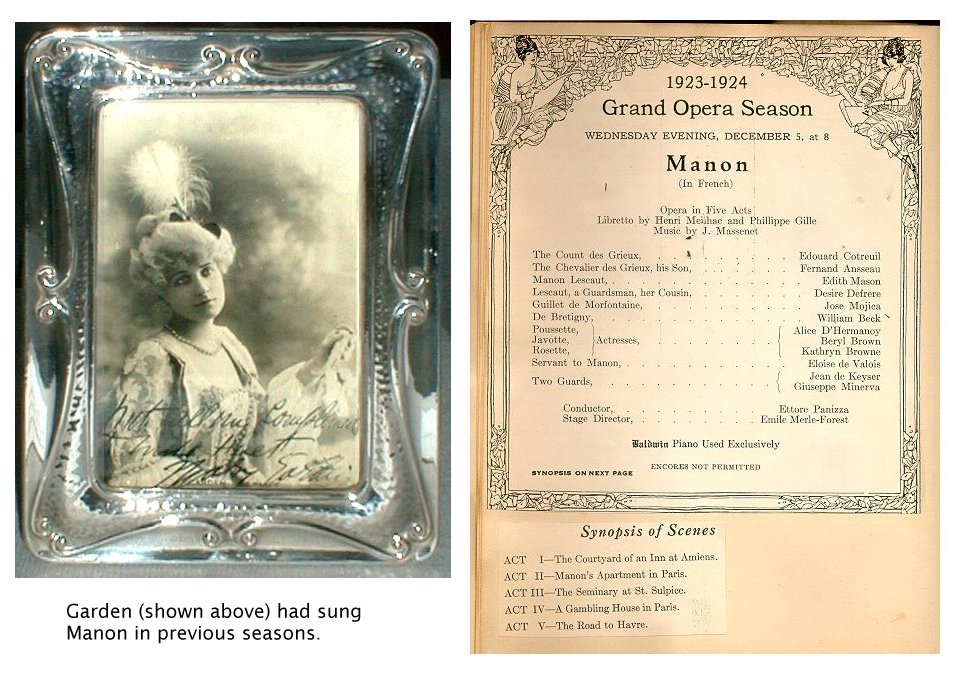
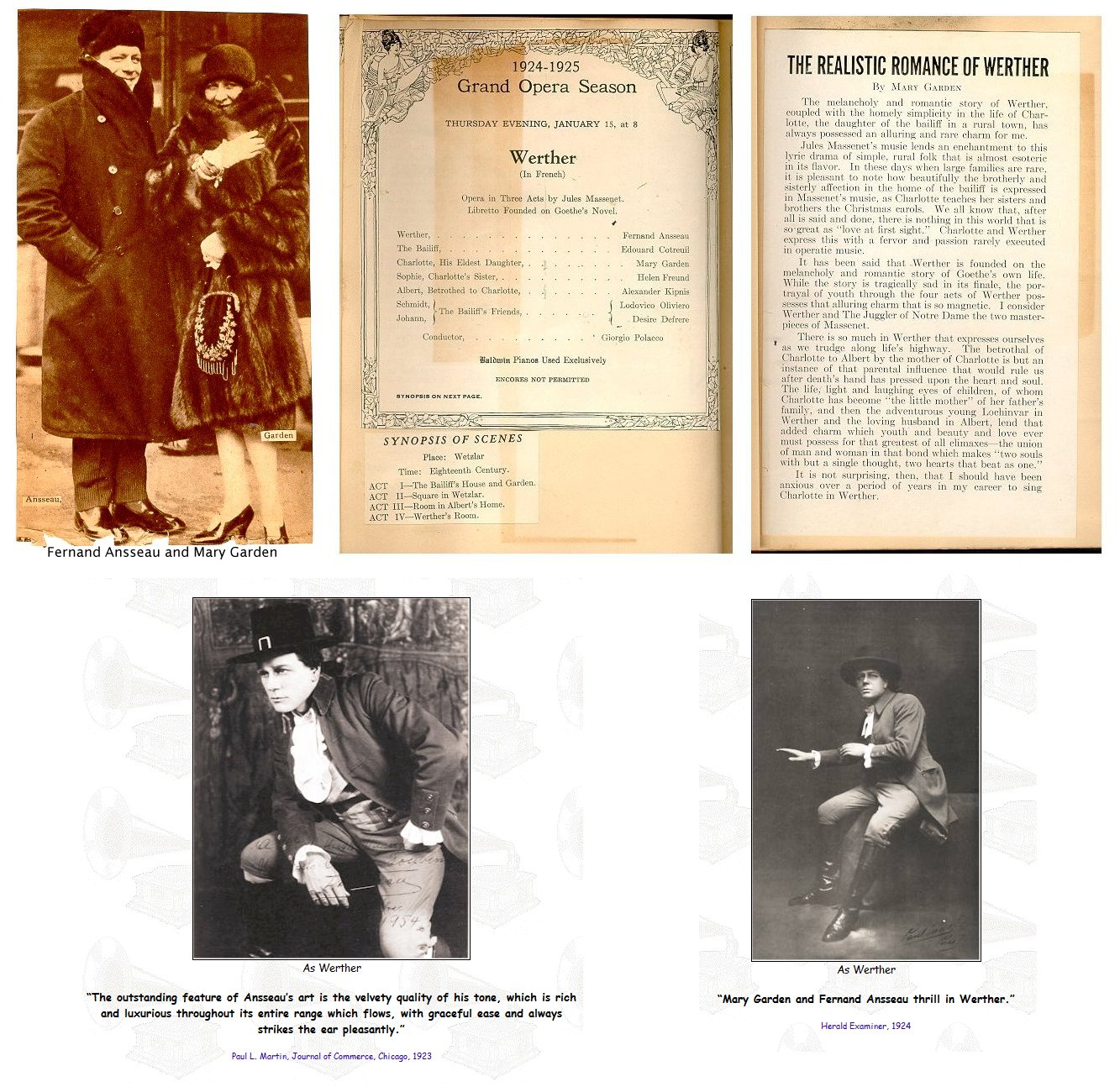
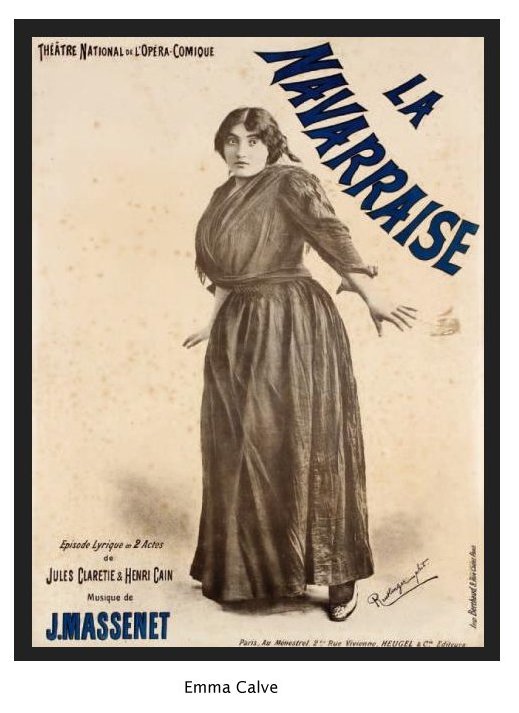
Emma Calvé, born Rosa Emma Calvet (August 15, 1858 – January 6, 1942), was a French operatic soprano. Calvé was probably the most famous French female opera singer of the Belle Époque. Hers was an international career, and she sang regularly at the Metropolitan Opera House, New York, and the Royal Opera House, London. Calvé was born on August 15, 1858, in Decazeville, Aveyron. Her birth name was Rosa Emma Calvet. Her father, Justin Calvet, was a civil engineer. She spent her childhood at first in Spain with her parents, then in different convent schools in Roquefort and Tournemire (Aveyron). After her parents separated, she moved with her mother to Paris. There she attempted to enter the Paris Conservatory, while she studied singing under Jules Puget. She started learning music in Paris from Mathilde Marchesi, a retired German mezzo-soprano and Manuel García. She made a tour of Italy, where she saw the famous actress Eleonora Duse, whose impersonations made a deep impression on the young singer. She trained herself in stage craft and gesture by closely observing Duse's performances. Her operatic debut occurred on September 23, 1881, in Gounod's Faust at Brussels' La Monnaie. Later she sang at La Scala in Milan, and also at the principal theatres of Naples, Rome, and Florence. Returning to Paris in 1891, she created the part of Suzel in L'amico Fritz by Pietro Mascagni, playing and singing the role later at Rome. Because of her great success in it, she was chosen to appear as Santuzza in the French premiere of Cavalleria rusticana, which was viewed as one of her greatest parts. She repeated her success in it in London. Her next triumph was Bizet's Carmen. Before beginning the study of this part, she went to Spain, learned the Spanish dances, mingled with the people and patterned her characterization after the cigarette girls whom she watched at their work and at play. In 1894, she made her appearance in the role at the Opéra-Comique, Paris. The city's opera-goers immediately hailed her as the greatest Carmen that had ever appeared, a verdict other cities would later echo. She had had many famous predecessors in the role, including Adelina Patti, Minnie Hauk and Célestine Galli-Marié, but critics and musicians agreed that in Calvé they had found their ideal of Bizet's cigarette girl of Seville. Calvé first appeared in America in the season of 1893–1894 as Mignon. She would make regular visits to the country, both in grand opera and in concert tours. After making her Metropolitan Opera debut as Santuzza, she went on to appear a total of 261 times with the company between 1893 and 1904. She created the part of Anita, which was written for her, in Massenet's La Navarraise in London in 1894 and sang Sapho in an opera written by the same composer. 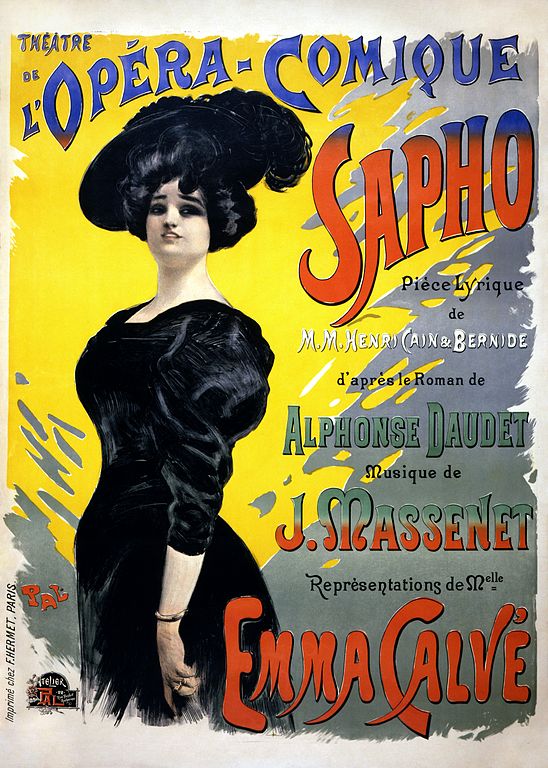
She sang Ophélie in Ambroise Thomas's Hamlet in Paris in 1899, but the part was not suited to her and she dropped it. She appeared with success in many roles, among them, as the Countess in The Marriage of Figaro, the title role in Félicien David's Lalla-Rookh, as Pamina in The Magic Flute, and as Camille in Hérold's Zampa, but she is best known as Carmen. Calvé developed an interest in the paranormal and was once engaged to the occult author Jules Bois. Calvé wrote of Swami Vivekananda in her autobiography: "[He] truly walked with God, a noble being, a saint, a philosopher and a true friend. His influence upon my spiritual life was profound [...] my soul will bear him eternal gratitude". She also visited Belur Math, Swami Vivekananda's tribute to his guru Ramakrishna Paramahansa. She said of this visit and her association with the monks there: "The hours that I spent with these gentle philosophers have remained in my memory as a time apart. These beings – pure, beautiful and remote seemed to belong to another universe, a better and wiser world" Swami Vivekananda wrote of Calvé: She was born poor but by her innate talents, prodigious labour and diligence, and after wrestling against much hardship, she is now enormously rich and commands respect from kings and emperors....The rare combination of beauty, youth, talents, and "divine" voice has assigned Calve the highest place among the singers of the West. There is, indeed, no better teacher than misery and poverty. That constant fight against the dire poverty, misery, and hardship of the days of her girlhood, which has led to her present triumph over them, has brought into her life a unique sympathy and a depth of thought with a wide outlook. 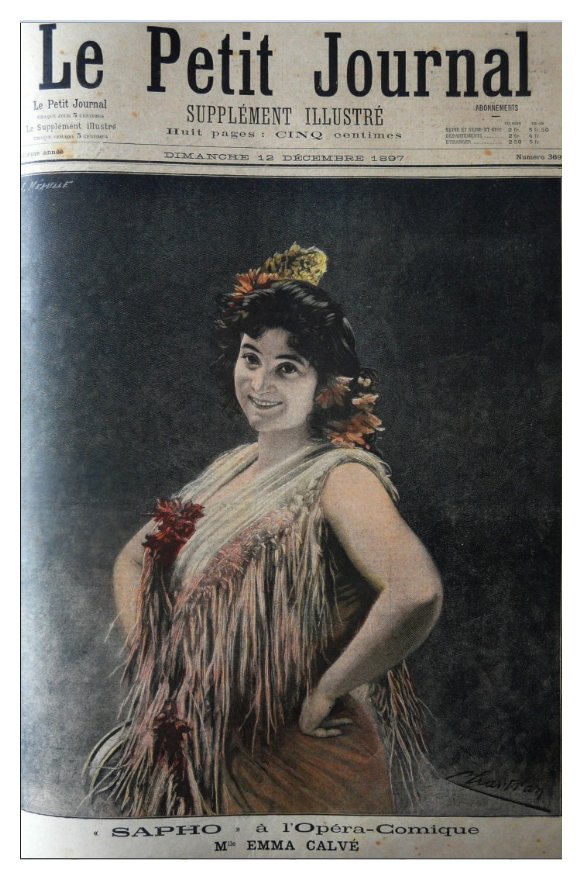
[More about Emma Calvé can be seen in the biography of her protege, Edna Darch, on the following page] |
Maria
Nikolayevna Kuznetsova (1880 – April 25, 1966) (Russian: Мария Николаевна
Кузнецова, also spelled Maria Kuznetsova-Benois, Ukrainian: Марія Нiколаевна
Кузнецова), was a famous 20th century Russian Empire and Soviet opera singer
and dancer.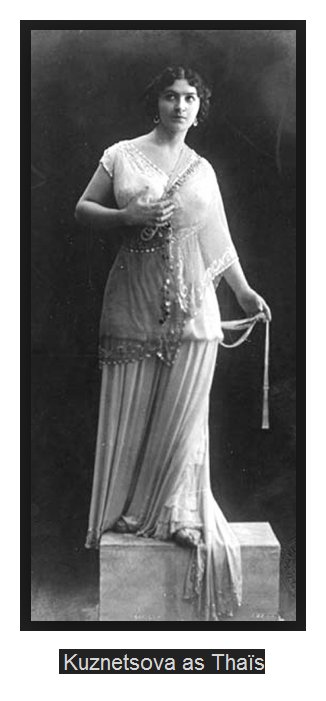 Prior to the Revolution, Kuznetsova was one of the most celebrated opera singers
in Imperial Russia, having worked with Richard Strauss, Nikolai Rimsky-Korsakov
and Jules Massenet. She was frequently paired with Feodor Chaliapin. After
leaving Russia in 1917, Kuznetsova continued to perform for another thirty
years abroad before retiring.
Prior to the Revolution, Kuznetsova was one of the most celebrated opera singers
in Imperial Russia, having worked with Richard Strauss, Nikolai Rimsky-Korsakov
and Jules Massenet. She was frequently paired with Feodor Chaliapin. After
leaving Russia in 1917, Kuznetsova continued to perform for another thirty
years abroad before retiring.Kuznetsova was born in 1880, in Odessa, Ukraine, the daughter of portraitist Nikolai Kuznetsov. Kuznetsova's mother was descended from a distinguished family of scientists and intellectuals of Romanian and Russo-Jewish descent. Her maternal grandmother, Emilia (Nevakhovich) Metchnikoff, was the daughter of Lev Nevakhovich (1776-1831), a Russo-Jewish author, translator, and founder of the Haskalah movement in Russia. Emilia married a Guards officer, Ilya Metchnikoff, and had two sons; the Nobel Prize-winning microbiologist Élie Metchnikoff and the sociologist Lev Metchnikoff. Kuznetsova's great-uncles Mikhail and Aleksandr Nevakhovich also had successful careers. Mikhail was a cartoonist and founder of Russia's first satirical magazine, Mish-Mash (Eralash). Aleksandr was a playwright and served as repertory director of Imperial Theaters in Saint Petersburg during the reign of Nicholas I. Kuznetsova initially studied ballet in Saint Petersburg, Russia, but abandoned dancing to study music with the baritone Joachim Tartakov. Kuznetsova was a lyrical soprano with a clear and beautiful singing voice. She also possessed notable talent as an actress. Igor Stravinsky described her as "very appetizing to look at as well as to hear". She initially debuted at the Saint Petersburg Conservatory as Tatiana in Tchaikovsky's Eugene Onegin in 1904. Kuznetsova debuted for a second time in 1905 at the Mariinsky Theatre as Marguérite in Charles Gounod's Faust. One night, not long after her Mariinsky debut, a dispute erupted in the theater's lobby between students and army officers while Kuznetsova was singing the role of Elsa in Wagner's Lohengrin. Before panic ensued, an unfazed Kuznetsova interrupted the performance, and she then quickly calmed the crowd by leading everyone in a rousing rendition of the Russian national anthem God Save The Tsar! She remained at the Mariinsky as soloist for twelve years until the Revolution in 1917. During her lengthy career, Kuznetsova originated several roles including Fevroniya in Rimsky-Korsakov's The Legend of the Invisible City of Kitezh and the Maiden Fevroniya, the title role in Massenet's Cléopâtre, Woglinde in the first Russian production of Wagner's Das Rheingold and Fausta in another Massenet creation, Roma. Other signature roles included Oksana in Tchaikovsky's Cherevichki, Thaïs in Massenet's Thaïs, Violetta in Verdi's La traviata, The Snow Maiden in Rimsky-Korsakov's The Snow Maiden, Mimi in Puccini's La bohème, Antonida in Glinka's A Life for the Tsar, Lyudmila in Ruslan and Ludmila and Tamara in Anton Rubinstein's The Demon. Kuznetsova, eventually, developed a sizable following abroad; making her Paris Opera debut in 1908 and her London debut at Covent Garden in 1909. During this period, she appeared in Emmanuel Chabrier's Gwendoline (1910) and Jules Massenet's Roma (1912). In 1916, Kuznetsova made her American debut, performing in New York and Chicago. In New York she caused a sensation, performing with the Manhattan Opera Company in the first American production of Cleopatre. 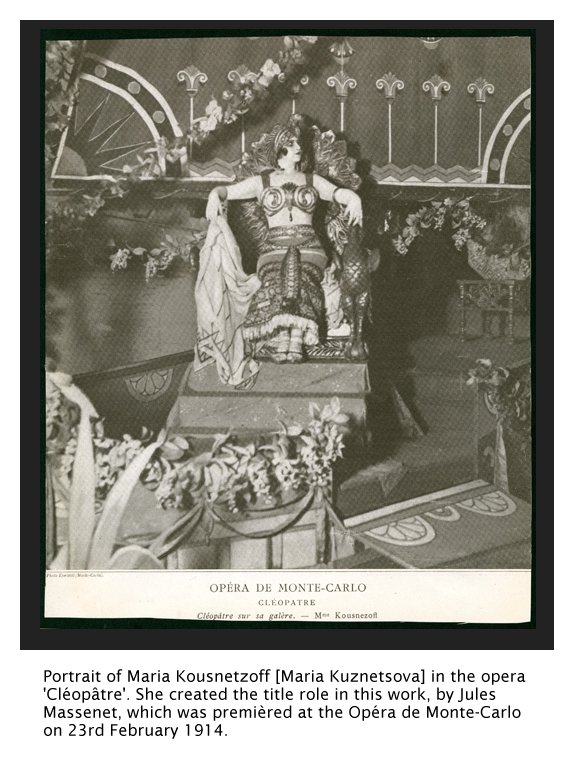
On the eve of the First World War, Kuznetsova participated in, and helped to finance, the famed Les Saisons Russes of Sergei Diaghilev's Ballets Russes in London and Paris. With the help of her friend, the artist and designer Léon Bakst, Kuznetsova won the role of Potiphar's wife in Richard Strauss's ballet La Légende de Joseph (or Josephslegende) in 1914. The production included a veritable who's who of the Edwardian art world. It was produced by Diaghilev, composed and conducted by Strauss, choreographed by Michel Fokine, designed by Bakst and José Maria Sert, while the lead was danced by Léonide Massine. It was an important role, and she was certainly in good company, but they were held to a punishing schedule with little time to rehearse. To make matters worse, Strauss was in a foul mood because his lover, Ida Rubinstein, who was to have danced Lydia Sokolova's role, had abruptly abandoned the project. Furthermore, Strauss abhorred working with French musicians, and was constantly at daggers drawn with the orchestra. Diaghilev, meanwhile, had not yet recovered from Vaslav Nijinsky's departure the previous year from the Ballets Russes. Despite the problems backstage and an outraged British press, who found the work obscene, the ballet successfully debuted in both London and Paris that spring as reported in the New York Times: PARIS, May 14 - At the Opera tonight the Russian ballet season opened with the premiere of Richard Strauss's The Legend of St. Joseph.... The part of Joseph was excellently performed by a young member of the Moscow "Artists Theatre", Leonide Miassine, who joined M. Diaghilew's ballet company for this purpose. Mme Kousnetzoff abandoned singing for the time being to impersonate Potiphar's wife ... A crowded house was evidently highly pleased. The most memorable thing about the production was said to be Sert's luxurious Venetian themed sets and Bakst's costumes. Sokolova recalled Kuznetsova's costume as being particularly inspired: She moved about on high gilded clogs, attended by servants, two of whom had a couple of honey-coloured wolfhounds on white leads ... In addition to trying her hand at ballet, Kuznetsova performed in several operas that season. In one memorable performance she joined the celebrated Russian bass Feodor Chaliapin in a production of Borodin's Prince Igor, choreographed by Fokine, and staged at Drury Lane on June 8, 1914. After the Revolution in 1917, Kuznetsova fled Russia, making a suitably dramatic escape dressed as a cabin boy and hidden inside a steamer trunk aboard a ship headed for Sweden. Her first performance in exile was with the Stockholm Opera in 1919.Later that year, she was engaged at the Gaiété-Lyrique in Paris, singing alongside Lucien Fugère, Maria Barrientos, Lydia Lipkowska, Georgette Leblanc, André Gilly, and Vanni Marcoux. In 1920, Kuznetsova participated in a large a charity concert at the Paris Opéra along with Vera Karalli and others, to raise funds to aid impoverished fellow Russian émigrés. Kuznetsova's other performances during the 1920s were of a more practical and less philanthropic nature. She organized private concerts and recitals where she would sing Russian and Spanish folk music, Gypsy music, and opera. At these recitals she would often perform Spanish folk dances and Flamenco after singing. In addition to these private performances, Kuznetsova worked as a soloist at Covent Garden, the Copenhagen Opera House, and other theaters and opera houses throughout Europe. She founded the Theatre of Miniatures with Léon Bakst in 1922, where, for a very brief time, she performed. In 1927, with the help of the Ukrainian baritone Mikhail Karakash and his wife Elizaveta Popova, and of the Count Alexis Ceretelli, Kuznetsova founded the Opéra Russe à Paris. The Opéra Russe staged a number of ballets and operas in London, Paris, Barcelona, Madrid, Milan, and as far afield as Buenos Aires and Japan, between 1927 and 1933. Kuznetsova gave fewer performances after 1933, but as late as 1947 her name appeared on the program of a choreographic competition held in Copenhagen, hosted by Rolf de Maré. Her contribution to the event was described quite simply: "Songs and dances of Spain, by Maria Kousnetzoff and a flamenco group." Kuznetsova's first husband was Nikolai Albertovich Benois, the son of watercolorist Albert Nikolayevich Benois (1852–1936). After the death of Benois, Kuznetsova wed Jules Massenet's nephew, the banker and industrialist Alfred Massenet. Alfred had worked for a time in the Russian Empire, prior to the Revolution, as the president of the Société d'Industrie Minière de Chagali-Heliar, a French copper mining company headquartered in Tbilisi, Georgia. Kuznetsova's last years were spent in poverty; she lived in one room in a small hotel off the Champs Elysees, abandoned by her son Mikhael and her former colleagues and friends. Kuznetsova's sole companion was her dresser Olga and she supported herself by giving lessons in singing and acting. Olga used to recount how Chaliapin died in Kuznetsova's arms, against the wishes of his wife. Kuznetsova died in Paris on April 25, 1966. |
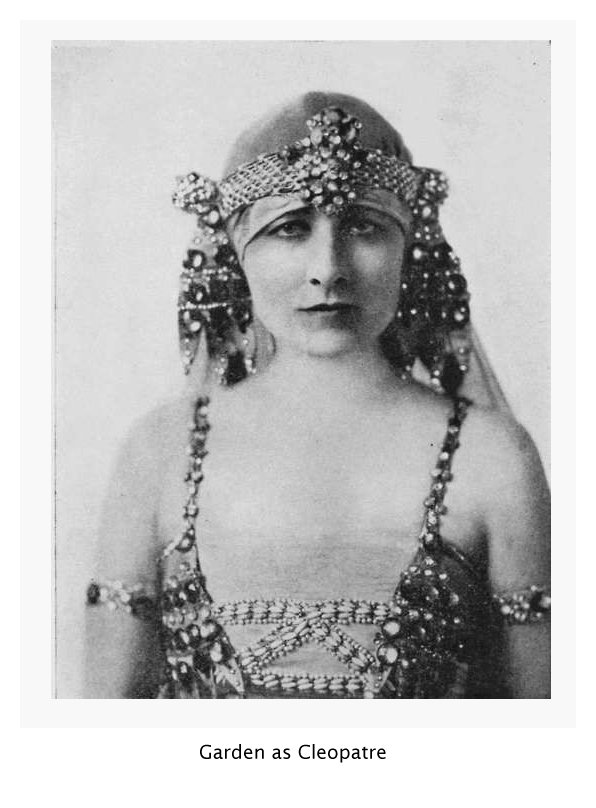
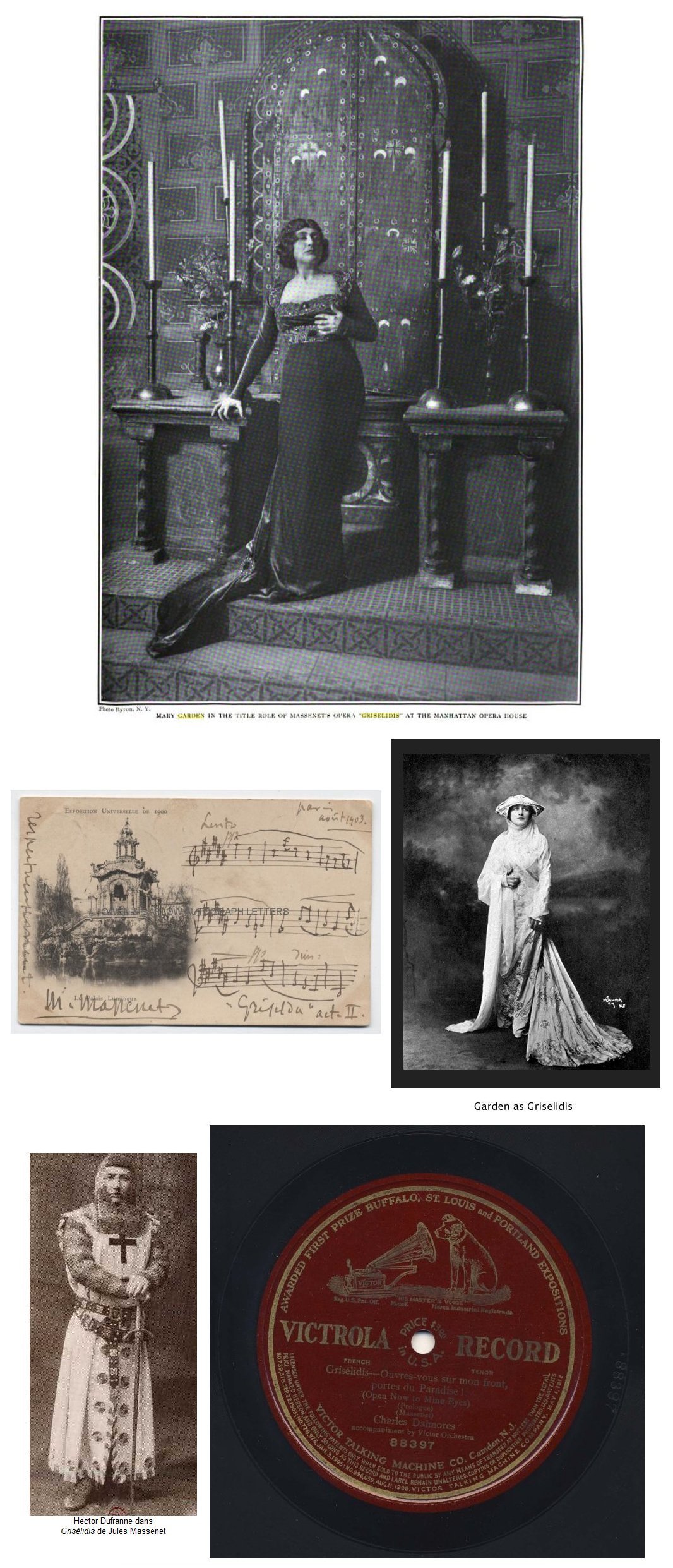
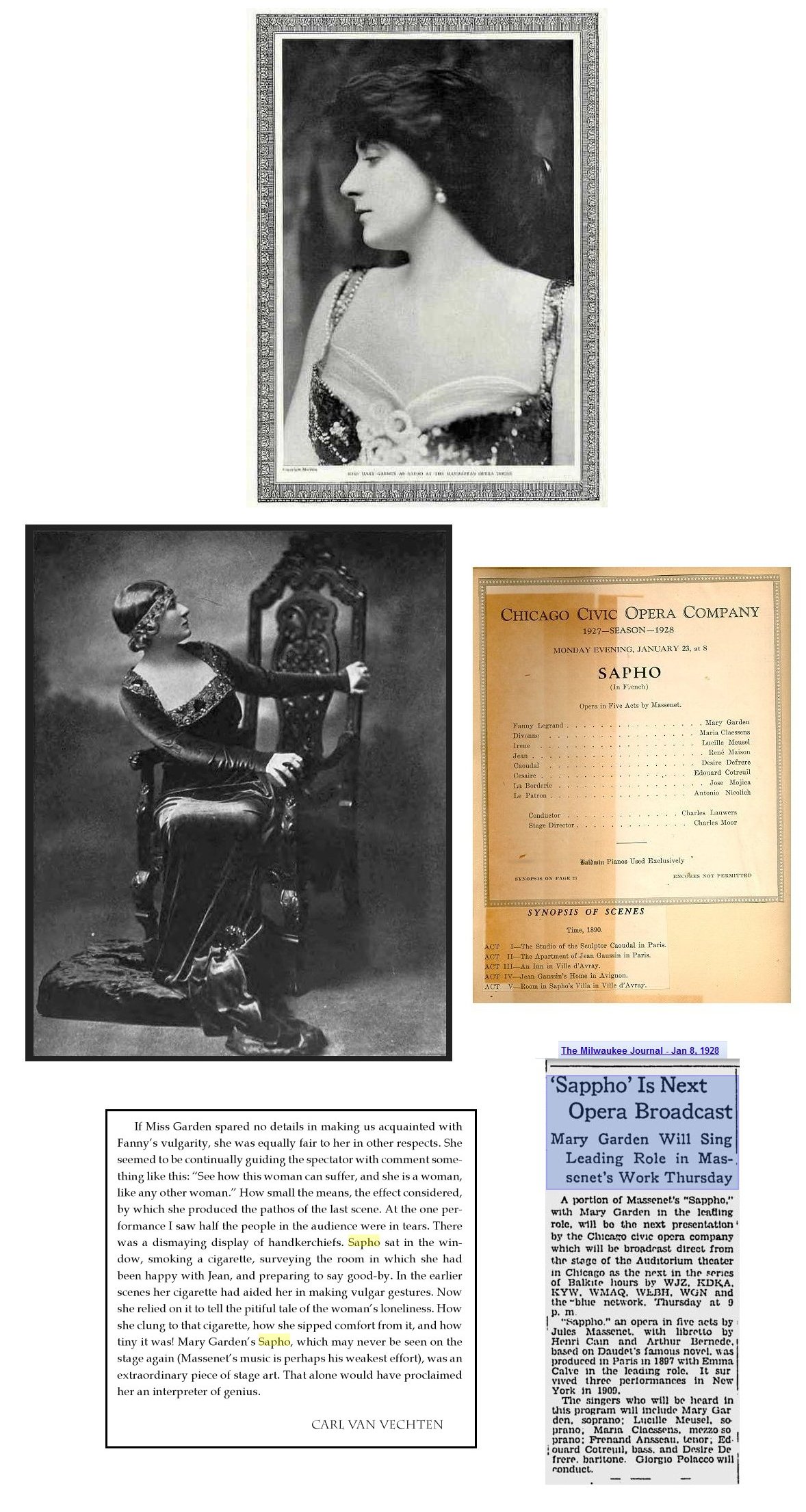
The item (above-right) about the broadcast in 1928
reminded me that Mary Garden was the
very first voice ever heard on the
radio in Chicago!
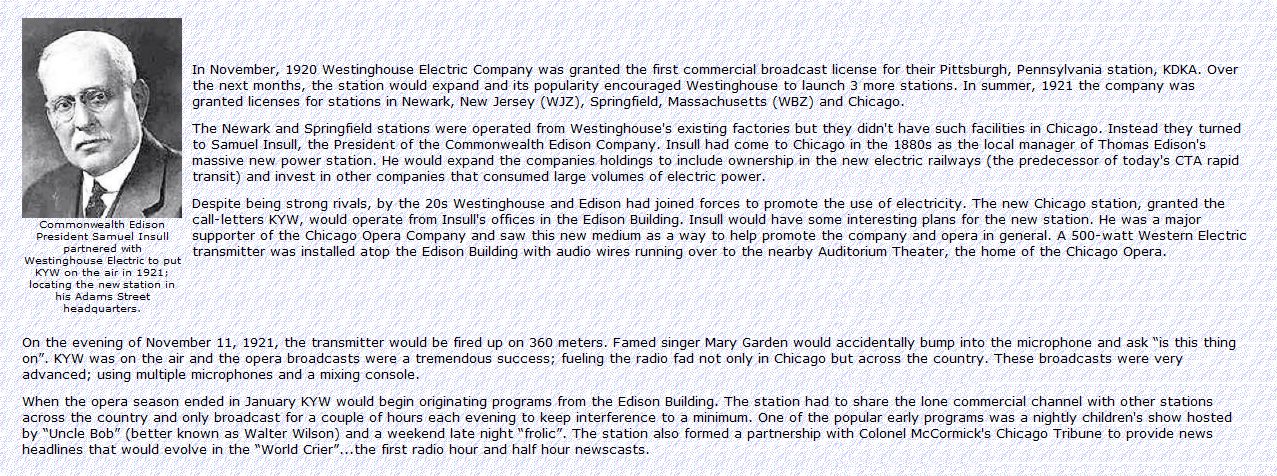
What follows are two of the illustrated biographies
of the musicians listed in the chart above.
Similar presentations of most of the
others can be found of the
following webpages.
First,
more about and by Mary Garden
| Mary
Garden (20 February 1874 - 3 January 1967), was a Scottish-American
operatic soprano with a substantial career in France and America in the first
third of the 20th century. She spent the latter part of her childhood and
youth in the United States and eventually became an American citizen, although
she lived in France for many years and eventually retired to Scotland, where
she died. Mary was one of four daughters; she and two others were born in Aberdeen, Scotland, while another was born in the United States. Her parents, both from Aberdeen in Scotland, were Robert Davidson Garden (b. 19 Jul 1855) and Mary Joss Garden (née Joss, b. 23 Feb 1860). The family moved to Chicopee, Massachusetts, United States when she was nine years old. They then moved to Hartford, Connecticut a few year later, followed by a relocation to Chicago, Illinois in 1888 when Mary was fourteen. She showed promise as a young singer, and studied with Sarah Robinson-Duff in Chicago under the financial support of wealthy patrons David and Florence Mayer. In 1896 she pursued further studies in Paris, chiefly with Trabadelo and Lucien Fugère, still under the support of the Mayers. She also studied some under Jacques Bouhy, Jules Chevalier, and Mathilde Marchesi. In 1899 Garden lost the backing of her benefactors, and she began to study singing with the American soprano Sybil Sanderson. Sanderson introduced her to Jules Massenet and Albert Carré, the director of the Opéra-Comique. Impressed with her voice, Carré invited her to join the roster at the Opéra-Comique in 1900. Garden made her professional opera debut with the company on 10 April 1900 in the title role of Gustave Charpentier's Louise, which had received its world premiere only two months before. Although Garden had been preparing the role, her debut, at the eighth performance of the work, was unscheduled as she was a last minute replacement for Marthe Rioton who had become ill. From 1901 for two years, she carried on an affair with André Messager, who conducted her in Louise. She claimed that when the Opéra-Comique director Albert Carré asked her to marry him, she replied that she had someone else in her life – Messager. Her description is of a tempestuous relationship, but they remained friends until his death. 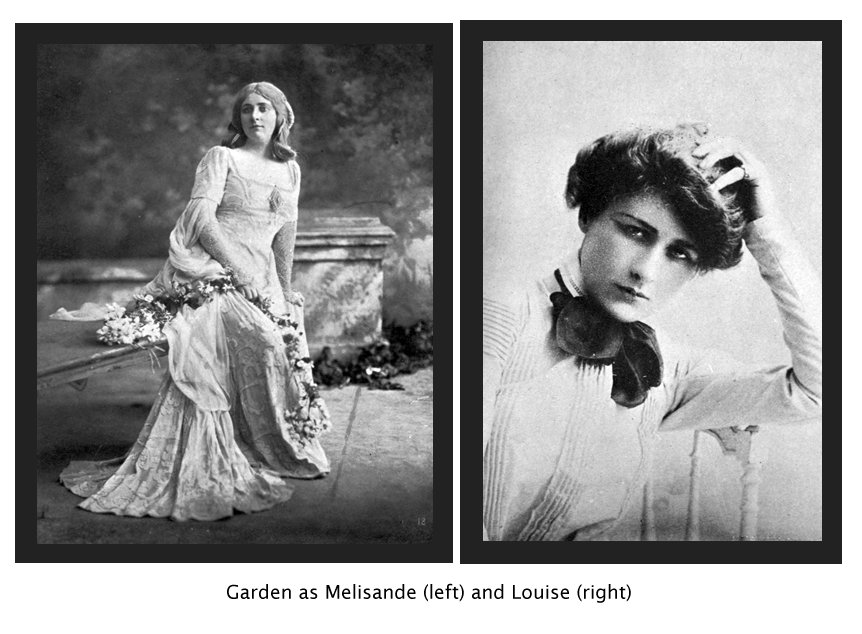
After her debut, Garden quickly became one of the leading sopranos at the Opéra-Comique. In 1901 she starred in two world premieres, Marie in Lucien Lambert's La Marseillaise and Diane in Gabriel Pierné's La fille de Tabarin. That same year she sang the title role in Massenet's Thaïs at Aix-les-Bains, and sang both the title roles in Massenet's Manon and Messager's Madame Chrysanthème at the Opéra de Monte-Carlo; all under the coaching of Sanderson. In 1902, Claude Debussy selected her to play the female lead at the Opéra-Comique debut of his Pelléas et Mélisande. Garden's performances met with considerable critical acclaim. She also created a sensation as Salomé in the French version of Richard Strauss's opera of that name. 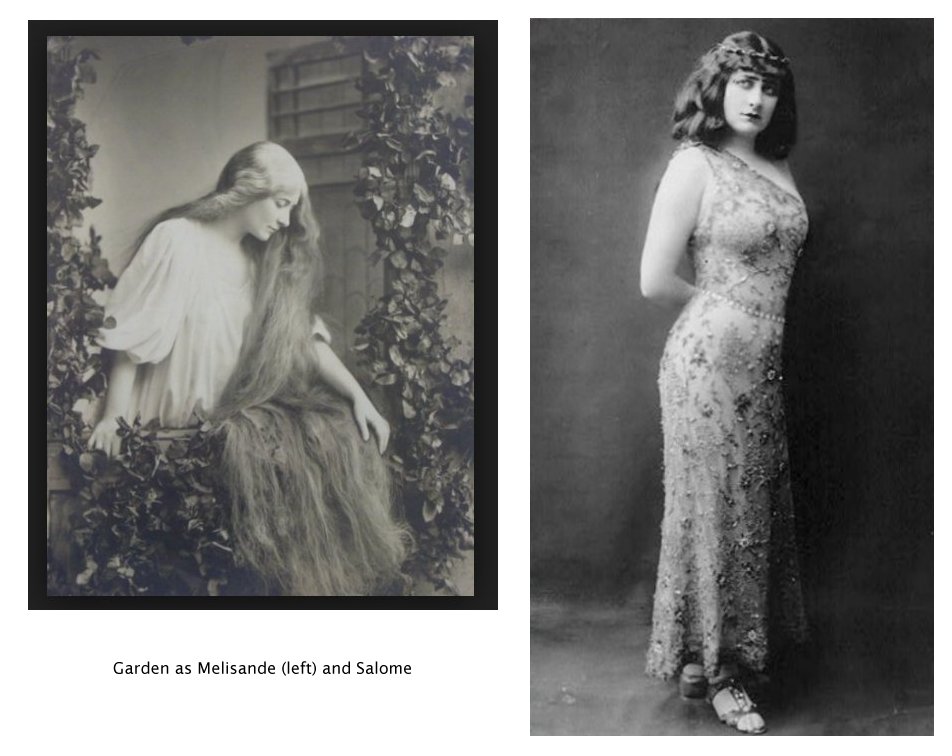
Following the success of Pelléas et Mélisande, Garden periodically went to London to sing at the Royal Opera House, Covent Garden while still appearing in performances in Paris. At Covent Garden she sang Manon, Juliette in Charles Gounod's Roméo et Juliette, and Marguerite in Gounod's Faust' during the 1902 and 1903 seasons. Garden, however, did not care for London and decided to not take any more engagements in that city. Her performances at the Opéra-Comique during this time included the title role in Massenet's Grisélidis (1902), Violetta in Giuseppe Verdi's La traviata (1903), the title role in the world premiere of Xavier Leroux's La reine Fiammette (1903), and the title role in Saint-Saëns's Hélène (1905). In 1905 she sang at the Opéra de Monte-Carlo in the world premiere of Massenet's Chérubin, a role which the composer wrote specifically for her. The following year she returned to the Opéra-Comique to sing Chrysis in the world premiere of Camille Erlanger's Aphrodite. 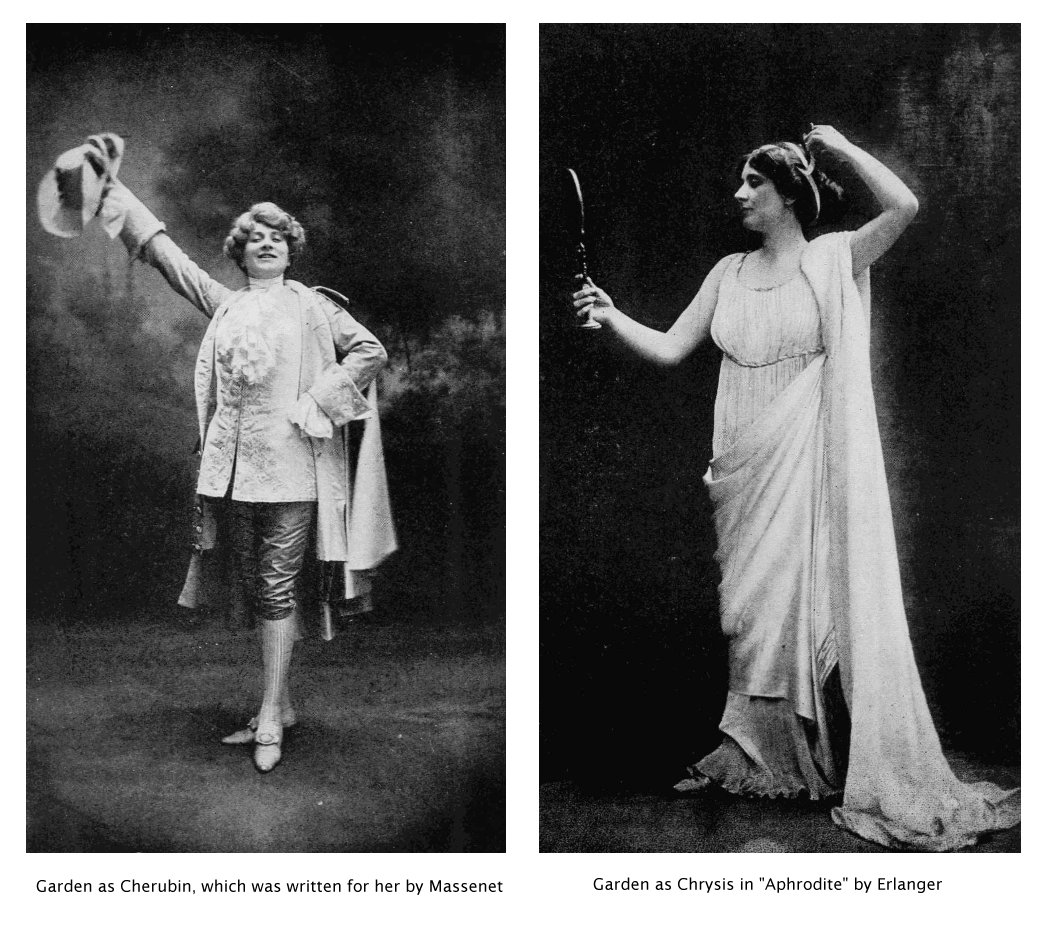
Persuaded by Oscar Hammerstein to join his competition against the Metropolitan Opera, Garden quit her frequent Opéra-Comique engagements to join the Manhattan Opera House in New York City. She made her American debut in the Manhattan Opera House on November 25, 1907 in the title role in Thaïs, a role which fitted her personality and art like a glove. She further astounded American audiences with her uncanny portrayal of a young boy in Massenet's Le jongleur de Notre Dame (1908) and in the United States premiere of Pelléas et Mélisande. In 1908 she returned to Paris to join the roster at the Opéra National de Paris. She sang there for one season, notably portraying Ophelia in Ambroise Thomas's Hamlet (1908) and the title part in Henry Février's Monna Vanna (1909) among other roles. She also sang the role of Marguerite in Gounod's Faust (1909) in Brussels. Afterwords, Garden returned again to New York in 1909 to perform the title role in Richard Strauss's Salome. During the performance she lasciviously kissed the severed head of John the Baptist which shocked the morals of a number of the audience members even more than her Dance of the Seven Veils (which she performed in a bodystocking). 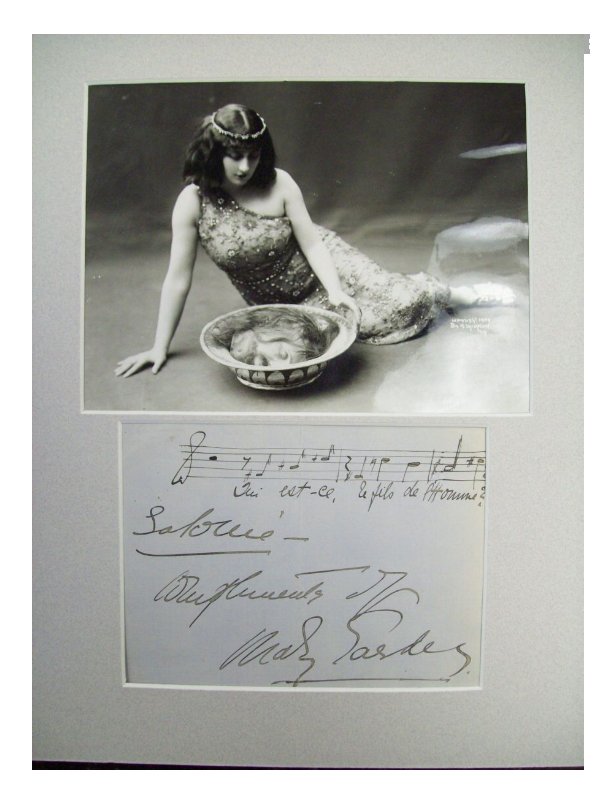
By 1910, Garden had become a household name within America. The Manhattan Opera Company became the Chicago Grand Opera Company where she sang from 1910 to 1913 in such roles as Mélisande, Fanny in Massenet's Sapho, Dulcinée in Massenet's Don Quichotte, the Prince in Massenet's Cendrillon, the title role in Georges Bizet's Carmen, and the title role in Giacomo Puccini's Tosca. During this time she also sang in other American cities, notably appearing in the world premiere of Victor Herbert's Natoma in Philadelphia on 25 February 1911 and in the title role Février's Monna Vanna in its United States premiere in Boston. 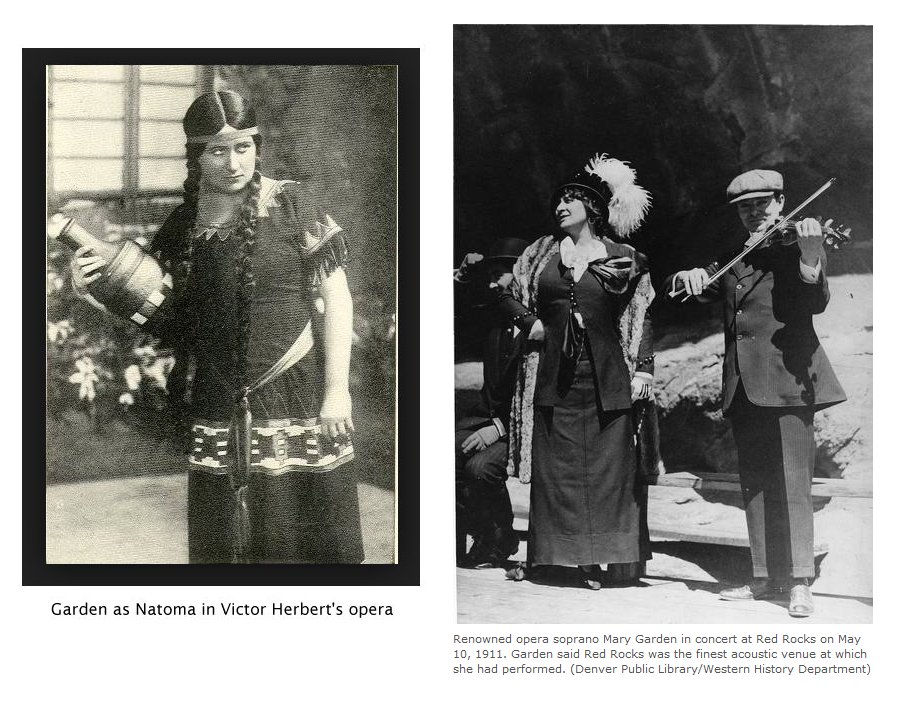
The company became the Chicago Opera Association from 1915 where she sang such roles as the title part in Massenet's Cléopâtre and the title part in the world premiere of Henry Février's Gismonda (both 1919), and the role of Fiora in Montemezzi's L'amore dei tre re (1920) among many others. She notably became the director of the Chicago Opera Association in the organization's final 1921–22 season. Although serving as director for only one year, she was responsible for producing an immensely glamorous season, including the world première of Prokofiev's The Love for Three Oranges which was sung in French and conducted by the composer. Also during this time she appeared in two silent films made by Samuel Goldwyn -- the title role in a film version of Thais (1917) and the role of Dolores Fargis in The Splendid Sinner (1918). Without her singing voice, her acting was criticized and neither film was a success.
In the 1930s, Garden appeared on Cecil B. DeMille's Lux Radio Theater. One such airing had Garden and Melvyn Douglas reading the play Tonight or Never which had recently been made into a motion picture. 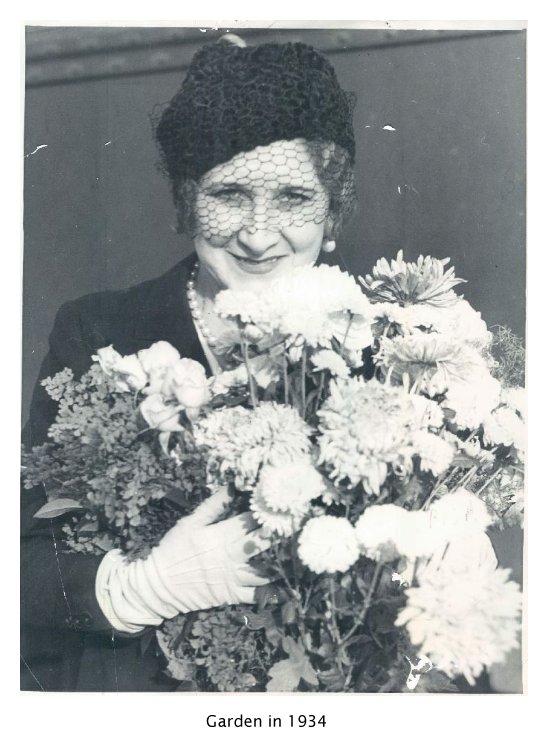 In 1922 the company became the Chicago Civic Opera where she sang until 1931.
Among the many roles she performed there ware Charlotte in Massenet's Werther (1924), Katyusha in Franco Alfano's
Risurrezione (1925, in French)
and the heroine of Arthur Honegger's Judith
(1927), the last two both United States premières. In 1930 she sang
in the world premiere of Hamilton Forrest's Camille. [Note: A page from the score
of Camille can be seen in my Interview with Nicolas
Slonimsky.] That same year she returned to the Opéra-Comique
to appear in several operas.
In 1922 the company became the Chicago Civic Opera where she sang until 1931.
Among the many roles she performed there ware Charlotte in Massenet's Werther (1924), Katyusha in Franco Alfano's
Risurrezione (1925, in French)
and the heroine of Arthur Honegger's Judith
(1927), the last two both United States premières. In 1930 she sang
in the world premiere of Hamilton Forrest's Camille. [Note: A page from the score
of Camille can be seen in my Interview with Nicolas
Slonimsky.] That same year she returned to the Opéra-Comique
to appear in several operas.Garden retired from the opera stage in 1934 [shown in photo at right], after making her last appearance as Katyusha in Risurrezione at the Opéra-Comique. After retiring, Garden worked as a talent scout for MGM and gave lectures and recitals, mostly on the life and works of Claude Debussy up through 1949. For much of her life she had openly encouraged young singers and even secretly paid for them to receive training. She continued to support young artists after her retirement through master classes, often allowing aspiring artists to attend for free. During World War I she was decorated by the French and Serbian governments and made a Chevalier of the Légion d'Honneur in 1921. She was a National Patron of Delta Omicron, an international professional music fraternity. It was in recognition of her personal history that Scottish Opera chose to present in their inaugural 1962 season Pelléas et Mélisande. That year marked the centenary of Debussy’s birth and the diamond jubilee of the opera. Sadly, by the time of the first performance Mary Garden was unable to accept her invitation to attend, being in hospital after a fall, and her health in decline. Mary Garden died in Inverurie, close to Aberdeen, where she spent the last 30 years of her life. An award for opera singing at the Aberdeen International Youth Festival is made in her name. There is a small memorial garden dedicated to her in the west-end of Aberdeen, with a small inscriptioned stone and a bench. Mary Garden made about 40 gramophone records between 1903 and 1929 for G & T, Columbia and Victor. They continue to be reissued and are of much interest to connoisseurs of historical recordings—although Garden herself was said to have been generally disappointed with the results. Of special interest are the four 1904 Black G&T recordings she made accompanied by Claude Debussy in Paris. There are also a small number of recordings made from radio broadcasts. * *
* * *
* * *
*
The following few paragraphs are taken from an essay entitled The Know How in the Art of Singing which Garden wrote for the book Great Singers on the Art of Singing, originally published in 1921 and now available as an e-book that is completely free to use or reproduce. [Text only - photos added] Three-quarters of an hour a day practice suffices me. I find it injurious to practice too long. But I study for hours. Such a rôle as Aphrodite I take quietly and sing it over mentally time and time again without making a sound. I study the harmonies, the nuances, the phrasing, the breathing, so that when the time for singing it comes I know it and do not waste my voice by going over it time and again, as some singers do. In the end I find that I know it better for this kind of study. 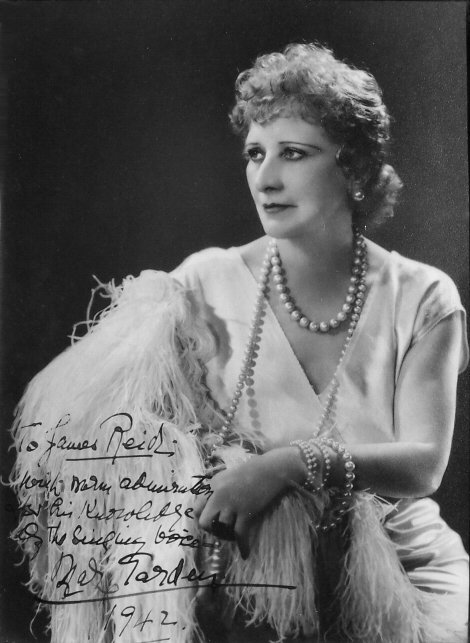 The study of acting has been a very personal matter with me. I have never
been through any courses of study, such as that given in dramatic schools.
This may do for some people, but it would have been impossible for me. There
must be technic in all forms of art, but it has always seemed to me that
acting was one of the arts in which the individual must make his own technic.
I have seen many representatives of the schools of acting here and abroad.
Sometimes their performances, based upon technical studies of the art, result
in superb acting. Again, their work is altogether indifferent. Technic in
acting is more likely to suppress than to inspire. If acting is not inspired,
it is nothing. I study the human emotions that would naturally underlie the
scene in which I am placed—then I think what one would be most likely to
do under such conditions. When the actual time of appearance on the stage
arrives, I forget all about this and make myself the person of the rôle.
The study of acting has been a very personal matter with me. I have never
been through any courses of study, such as that given in dramatic schools.
This may do for some people, but it would have been impossible for me. There
must be technic in all forms of art, but it has always seemed to me that
acting was one of the arts in which the individual must make his own technic.
I have seen many representatives of the schools of acting here and abroad.
Sometimes their performances, based upon technical studies of the art, result
in superb acting. Again, their work is altogether indifferent. Technic in
acting is more likely to suppress than to inspire. If acting is not inspired,
it is nothing. I study the human emotions that would naturally underlie the
scene in which I am placed—then I think what one would be most likely to
do under such conditions. When the actual time of appearance on the stage
arrives, I forget all about this and make myself the person of the rôle.This is the Italian method rather than the French. There are, to my mind, no greater actors living than Duse and Zacchona, and they are both exponents of the natural method that I employ. Great acting has always impressed me wonderfully. I went from Paris to London repeatedly to see Beerbohm Tree in his best rôles. Sir Herbert was not always uniformly fine, but he was a great actor and I learned much from watching him. Once I induced Debussy to make the trip to see him act. Debussy was delighted. Debussy! Ah, what a rare genius—my greatest friend in Art! Everything he wrote we went over together. He was a terribly exacting master. Few people in America realize what a transcendent pianist he was. The piano seemed to be thinking, feeling, vibrating while he was at the keyboard. Time and again we went over his principal works, note for note. Now and then he would stop and clasp his hands over his face in sudden silence, repeating, "It is all wrong—it is all wrong." But he was too good a teacher to let it go at that. He could tell me exactly what was wrong and how to remedy it. When I first sang for him, at the time when they were about to produce Pelleas and Melisande at the Opera Comique, I thought that I had not pleased him. But I learned later that he had said to M. Carré, the director: "Don't look for anyone else." From that time he and his family became my close friends. The fatalistic side of our meeting seemed to interest him very much. "To think," he used to say, "that you were born in Aberdeen, Scotland, lived in America all those years and should come to Paris to create my Melisande!" As I have said, Debussy was a gorgeous pianist. He could play with the greatest delicacy and could play in the leonine fashion of Rubinstein. He was familiar with Beethoven, Bach, Handel and the classics, and was devoted to them. Wagner he could not abide. He called him a "griffe papier"—a scribbler. He thought that he had no importance in the world of music, and to mention Wagner to him was like waving a red flag before a bull. It is difficult to account for such an opinion. Wagner, to me, is the great tone colorist, the master of orchestral wealth and dramatic intensity. Sometimes I have been so Wagner-hungry that I have not known what to do. For years I went every year to Munich to see the wonderful performances at the Prinzregenten Theater. In closing let me say that it seems to me a great deal of the failure among young singers is that they are too impatient to acquire the "know how." They want to blossom out on the first night as great prima donnas, without any previous experience. How ridiculous this is! I worked for a whole year at the Opera Comique, at $100 a month, singing such a trying opera as Louise two and three times a week. When they raised me to $175 a month I thought that I was rich, and when $400 a month came, my fortune had surely been made! All this time I was gaining precious experience. It could not have come to me in any other way. As I have said, the natural school—the natural school, like that of the Italians—stuffed as it is with glorious red blood instead of the white bones of technic in the misunderstood sense, was the only possible school for me. If our girls would only stop hoping to make a début at $1,000 a night and get down to real hard work, the results would come much quicker and there would be fewer broken hearts. |
||||||||
The biogtraphy of
Charles Dalmorès has been placed here
because he often appeared with Garden, but also because
of the lengthy description of his day-to-day schedule.
This section covers the period and companies of the
discussion at hand, and can be extrapolated to
be similar for other colleagues at the time.
because he often appeared with Garden, but also because
of the lengthy description of his day-to-day schedule.
This section covers the period and companies of the
discussion at hand, and can be extrapolated to
be similar for other colleagues at the time.
Charles
Dalmorès was born on January 1, 1871 as Henri Alphonse Brin
in Nancy, France. Dalmorès studied at the local conservatory of music
and embarked on a career as a horn player with the Colonne and Lamoureux
orchestras. In 1894, the Lyons Conservatory appointed him to a professorial
position. Later, when his voice showed signs of promise, he abandoned instrumental
music and took singing lessons in Paris. He made his operatic debut at the
Théâtre des Arts in Rouen on October 6, 1899, in the heavy Wagnerian
role of Siegfried. Following this, he spent six seasons with the Théâtre
de la Monnaie in Brussels and sang with success at London's Royal Opera House,
Covent Garden, in 1904-1905 and 1909-1911.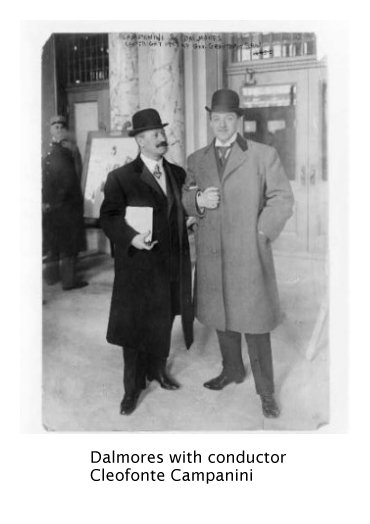 His American debut took place in Charles Gounod's Faust, in which he appeared with New
York's Manhattan Opera Company on December 7, 1906. He spent four years with
the company, specializing in French roles. For American audiences, he created
the roles of Julien in Gustave Charpentier's Louise and Jean Gaussin in Jules Massenet's
Sapho. Another famous part
that he sang was Pelleas in Claude Debussy's Pelléas et Mélisande. He
also appeared in numerous productions with the Philadelphia Opera Company
between 1908-1910.
His American debut took place in Charles Gounod's Faust, in which he appeared with New
York's Manhattan Opera Company on December 7, 1906. He spent four years with
the company, specializing in French roles. For American audiences, he created
the roles of Julien in Gustave Charpentier's Louise and Jean Gaussin in Jules Massenet's
Sapho. Another famous part
that he sang was Pelleas in Claude Debussy's Pelléas et Mélisande. He
also appeared in numerous productions with the Philadelphia Opera Company
between 1908-1910.In 1910 Dalmorès was engaged by the Chicago Grand Opera Company with whom he performed until 1914. The company was highly active in Philadelphia as well as Chicago and often performed under the title of the Philadelphia-Chicago Grand Opera Comoany while in that city. With that company he notably performed the role of Vinicius in the United States premiere of Jean Nouguès's Quo vadis. In 1917 Dalmorès joined the Chicago Opera Association. There he sang for the first time the title roles in Richard Wagner's Parsifal and Tristan und Isolde. He also visited Germany and Austria on different occasions prior to the outbreak of World War I, performing Wagner in the original language in Berlin and other cities. In 1908-1909, he appeared at the Vienna Court Opera and undertook the role of Lohengrin, in Wagner's eponymous opera, at the 1908 Bayreuth Festival. Tall for a tenor, he was praised by contemporary critics not only for his strong, steady, well-modulated voice but also for his impressive stage presence and acting. Fortunately, he made a number of gramophone records for the Victor Talking Machine Company which have been reissued on CD. Produced between 1907 and 1912, they confirm the excellence of his musicianship and the imposing power of his declamatory singing, although the top of his range sounds a bit constricted on these 100-year-old discs. One of his most celebrated records is a 1907 rendition of Manrico's aria Ah! si, ben mio, from Giuseppe Verdi's Il trovatore, in which he displays an admirably smooth legato line, elegant phrasing and a splendid trill. He also recorded a few French songs as well as arias and duets from various operas, including Lohengrin, Giacomo Meyerbeer's Le prophète, Camille Saint-Saëns' Samson et Dalila [shown in bottom photo], Jacques Offenbach's Les Contes d'Hoffmann, Georges Bizet's Carmen, Massenet's Griselidis, and Gounod's Roméo et Juliette and Faust. 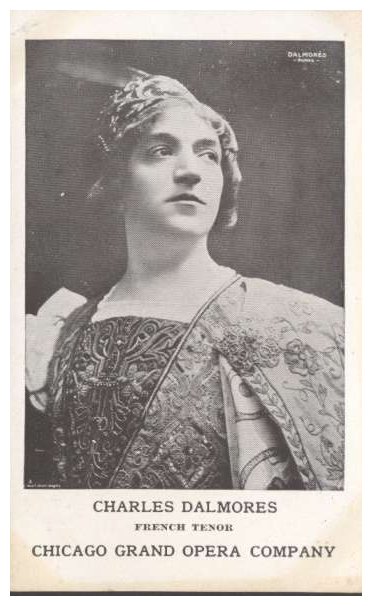
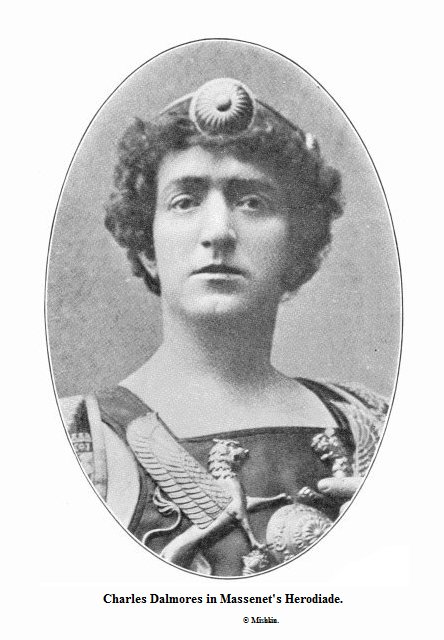
Dalmorès returned to France in 1918 but subsequently went back to the United States to live where he taught singing. He died in Hollywood, California on December 6, 1939, at the age of 68. 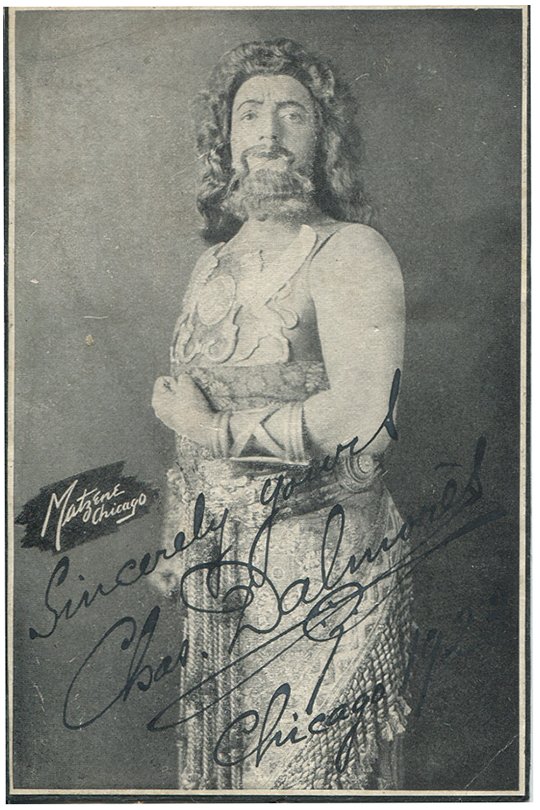
The following quote is an excerpt from
an essay by Dalmorès published in 1921 in the book Great Singers on the Art of Singing by
James Francis Cooke.
"The voice is one of the most intricate and wonderful of the human organs. Properly exercised and cared for, it may be developed to a remarkable degree; but there are cases, of course, where there is not enough voice at the start to warrant the aspirant making the sacrifices that I have made to reach my goal. This is a very serious matter and one which should be determined by responsible judges. At the same time, the singers may see how possible it is for even experienced musicians, like my colleagues in Lyons, to be mistaken. If I had depended upon them and not fought my own way out, I would probably be an obscure teacher in the same old city earning the munificent salary of one hundred dollars a month. "The student who has to fight his own way has a much harder battle of it; but he has a satisfaction which certainly does not come to the one who has all his instruction fees and living expenses paid for him. He feels that he has earned his success; and, by the processes of exploration through which the self-help student must invariably pass, he becomes invested with a confidence and "I know" feeling which is a great asset to him. The main thing is for him to keep busy all the time. He has not a minute to spare upon dreaming. He has no one to carry his burden but himself; and the exercise of carrying it himself is the thing which will do most to make him strong and successful. "The artists who leap into success are very rare. Hundreds who have held mediocre positions come to the front, while those who appear most favored stay in the background. Do not seek to gain eminence by any influence but that of real earnest work; and if you do not intend to work and to work hard, drop all of your aspirations for operatic laurels." * *
* * *
What follows is an excerpt from a very lengthy article on the tenor by Charles A. Hooey. The reason for including this material here is to show not only the range of this singer's repertoire -- which was typical of all those who sang at this level -- but also to indicate the hectic pace of life. Performers who were under this kind of contract flitted about from city to city night after night, just as they often still do in Europe. These paragraphs also help to delineate the struggles of these specific opera companies as they worked to fulfill artistic goals within the framework of their financial abilities. This section also deals directly with the Hammerstein and Chicago opera companies during the period being discussed . . . . . CHARLES DALMORÈS by Charles A. Hooey Not surprisingly, this French artist sang primarily in his native tongue during his first few years on stage and continued to feature French operas in his repertoire throughout his career. He did, however, come to believe opera should be sung in its original language and when he developed a love for Wagner’s music, he studied German assiduously. As well he learned Italian and English. His voice was described as a noble organ, manly, tender and always sympathetic. He sang with great skill, was always musical and as well was as an accomplished actor. He achieved fame through outstanding seasons in London, New York, Chicago, Boston and elsewhere. His name was ‘Charles Dalmorès’. ( . . . )
On a high, probably envisioning a way to benefit financially, Dalmorès signed a contract with the Metropolitan Opera covering the period of 15 November 1908 until 30 April 1909 worth $50,000, double his current income, with a prospect of four more years with an earning potential of $200,000. Trouble was, he was still under contract to Hammerstein so a few days later, regretfully, he notified the Metropolitan that he would not honor his contract. Immediately the Met countered with a lawsuit. In the end two years later, Dalmorès lost and was required to pay the Met $20,000, according to a forfeiture clause in the contract. Instead, the tenor decided to avoid the Met collectors by boarding the steamer Potsdam disguised as a member of the ship’s band. The incident created scandalous headlines but was his decision really a wise one? He lost thousands. So he continued with Hammerstein, now showing his true métier as a star performer in French opera. As the third season got underway, Dalmorès and Mary Garden appeared on 11 November 1908 in Thaïs, an event witnessed by the New York Times: ‘Mr. Dalmorès was heard again with great pleasure and his fine tenor, with the virility of the baritone quality that makes itself evident from time to time, was again the object of just admiration. “He sang with splendid fervour and power, and he makes of a comparatively minor part of Nicias something of dramatic value.’ Two nights later, ‘As Samson, Dalmorès again offered his superb characterization of his role, impressing by his diction, vigour, personal appearance, and magnificent voice.’ He sang this role six times. Meanwhile in Philadelphia, Hammerstein’s spanking, new Opera House was due to open on Tuesday, November 17, 1908 with Bizet’s Carmen. “Never had the city seen anything like it. An estimated total of 1800 vehicles wound their way to the opera house, choking the main avenues.” Of the singers, “Maria Labia was a most attractive Carmen pictorially but disappointing dramatically. Dalmorès and Zeppilli were highly praised and De Segurola encored for his second act aria, sang with authority and ardor.” Two nights later, with Jeanne Gerville-Réache, Hector Dufranne and Armand Crabbé, he sang the first of three performances of Samson et Dalila. Then, on 10 December, he essayed a third role, Hoffmann in Offenbach’s Les Contes d’Hoffman, enabling him to romance three lovelies: Alice Zeppilli (Olympia), Jeanne Espinasse (Giulietta) and Emma Trentini (Antonia) with Armand Crabbé and Maurice Renaud supplying the villainy. Returning to New York, the company repeated Offenbach’s opera on 16 December with essentially the same cast, providing seven performances overall. On 6 January 1909, however, Dalmorès began a series of four Pelléas et Mélisandes with Mary Garden, Jeanne Gerville Réache as Genéviève, Hector Dufranne as Golaud and Felix Vieuille as Arkel with Campanini conducting. Though usually successful in roles he performed, for The Sun, Dalmorès proved “too vital a figure, seemingly miscast as the dreamy, shadowy legendary Pelléas” and was also judged to be not at all familiar with the style of the opera, in that he seemed uncomfortable in the part. On 12 January, he was back in Philadelphia to repeat Les Contes d’Hoffmann with Helene Koèlling as Antonia. When Richard Strauss’s Salome was given its American Première at the Metropolitan Opera in New York on 22 January 1907, Olive Fremstad was a sleek tigress of a princess, yet hardly a 15 year old. Giving his reaction, Henry E. Krehbiel wrote in the New York Tribune: “There is a vast deal of ugly music in Salome ... music that offends the ears and rasps the nerves like fiddlestrings played on a coarse file. There is not a whiff of fresh and healthy air blowing through it. Salome is the unspeakable; Hérodias is a human hyena; Hérod a neurasthenic voluptuary…” So, when Hammerstein’s Manhattan Opera chose to offer Salome in French on 28 January 1909, it was the most eagerly anticipated event of the season. Once again the critics couldn’t stop praising Mary Garden while Dalmorès, as the neurotic Hérod, gave a lifelike picture of the Royal voluptuary, his interpretation being ‘truly noble’. Just fifteen days after the Salome launching in Chicago, and in the midst of a series of operas there, Dalmorès brought his role of Hérod to Philadelphia. However, before that could happen, he and Mary Garden gave the city’s opera-lovers their version of Pelléas et Mélisande on the 9th February. Quite different was Strauss’s opera. When it was announced that Salome would be given, loud rumblings of discontent were heard and the vituperation soon exceeded that registered when the opera had been mounted by the Metropolitan in New York. Enormous crowds gathered both outside and inside the house. The Public Ledger described it “the most extraordinary operatic occasion in the history of the city”. Mary Garden’s characterization was praised to the skies, her singing less so. Her dance was remarkable for its grace and voluptuous charm ... through it all she was a vision of loveliness. Dalmorès, the neurotic Herod, gave a lifelike picture of the royal voluptuary. Dufranne, the Prophet, sang and acted impressively while Doria was the able Hérodias. When Hammerstein presented the opera a second time on 16 February, the house again was crowded, hundreds not being able to obtain admission. A third performance on 1 March was the last. Hammerstein withdrew the opera, preferring “not to take the risk of being the man who taught Philadelphia anything it thinks it ought not to know.” Louise was also performed on March 18th and 23rd with Mary Garden and Dalmorès together on stage once more. Finally Dalmorès joined Jeanne Gerville-Reache in Samson et Dalila on 30 March to complete his season in this city. When the second spring tour got underway, Dalmorès skipped Baltimore but was active in Boston. Hammerstein had plans to presentSalome in Boston but, when officialdom became fierce in their opposition and when the Mayor decreed that the good burghers of Boston would not be corrupted by Hammerstein’s immoral Salome, he had no choice but to withdraw the opera. Instead, Boston’s opera fanatics had to be content, seeing and hearing Pelléas et Mélisande for the first time on 1 April with Dalmorès and Garden. The next evening he was back as Hoffmann in Les Contes d’Hoffman with Alice Zeppilli as Olympia and Giulietta, and Emma Trentini as Antonia. On 5 April, and again on the 19th, he and Mary Garden sang Louise with Augusta Doria (La mère) and Charles Gilibert (Le père). Following Boston, Dalmorès journeyed to Europe where he was due to sing at a Covent Garden season but first he traveled on to Vienna to make a second appearance, leaving Affre and Fontaine to sing tenor roles in London until he arrived. In Vienna, on 17 May, Dalmorès joined Lucy Weidt, Mme. Charles Cahier and Friedrich Weidemann in Aida. Then on 20 May, he sang Lohengrin, his Elsa being Signe von Rappe and Bertha Forster-Lauterer on 23 May. A repeat of Aïda was planned on 26 May but Dalmorès was taken ill so to the rescue raced Theodor Eckert from Brno. Elisa Elizza sang Aïda. When he did reach Covent Garden, he was thrust at short notice into the part of Radamès on 5 June 1909 but he ‘sang and acted with immense vigour and conviction and though his powerful voice was a little hard at times, it was always quite true in intonation.’ The starry cast included Emmy Destinn (Aïda), Louise Kirkby Lunn (Amneris), Antonio Scotti (Amonasro), and Vanni Marcoux (Ramfis). Signor Ettore Panizza conducted. He next appeared on 18 June as Julien in Louise during its first presentation in English with Louise Edvina as Louise. On 30 June, he gave his first Samson at Covent Garden and proved a tower of strength. ‘He indeed both acted and sang superbly and his reading was noticeable for many clever and original points. Kirkby Lunn seemed duly inspired by his presence and was more magnificent than ever, while Jean Bourbon fulfilled all the requirements of the High Priest.’ Maurice Frigara conducted. Five performances of Faust were offered spread over the season. Dalmorès sang on 6 July with Messrs Fontaine and Affre attending to the others. In the case of Marguerite, three sopranos were needed: Louise Edvina, Maria Kousnietzoff and Martha Symiane. In the Dalmorès appearance, Edmund Burke was Méphistophélès while Vanni Marcoux and Marcel Journet were heard on other evenings. At some point, Dalmorès realized that spending so many years in orchestral pits observing how singers plied their trade and having relatively little formal training, he had achieved his goal of becoming a successful singer primarily by the ‘self-help’ process. FINALE WITH HAMMERSTEIN IN NEW YORK Hammerstein’s Manhattan Opera began its final season on Monday, 8 November 1909 with its first Hérodiade in New York - seventeen years later than in New Orleans - Massenet had become as popular in the United States that Manon was being seen the same evening to open the Metropolitan’s Brooklyn season. Hammerstein hoped that, as the plot concerned Salomé, he might duplicate Mary Garden’s tremendous success in Strauss’s opera the previous season. As Salomé, Lina Cavalieri startled New York critics with her vocal improvement, and, as always her extraordinary beauty enchanted everyone. Dalmorès, as John the Baptist sang as magnificently as was his wont but wore a costume which ‘scarcely evoked the image of one who had fed on locusts and wild honey’. As Hérode, Renaud was intensely dramatic and superb in song but Gerville-Réache, the Hérodiade, was less successful in her part. De la Fuente conducted. It had much perfumed, voluptuous music, including ‘Vision fugitive’. But it has not reached the Metropolitan, and for obvious reasons it is not the competent evening’s pastime Massenet guarantees at his best, and moreover, Strauss’s version of much the same events, in Salome, has made Massenet’s opera seem, by comparison, suitable for student performances at a female academy. With virtually the same cast, the opera was given three nights later in Philadelphia and in New York on 24 November. On 17 November 1909, Hammerstein presented the American premiere of Sapho, the second of three Massenet novelties given that season, Hérodiade being the first. Sapho was not the composer at his best. Whatever success it achieved was due to the forceful psychological drama Mary Garden imparted to the prostitute Fanny Le Grand. Others in the cast were Dalmorès (Jean Gaussin), D’Alvarez (Divonne), and Dufranne (Caoudal) with De la Fuente conducting. It was given as well in Philadelphia on 20 November. Moving on, he portrayed Faust on 8 December with Mary Garden (Marguerite), Jean Vallier (Méphistophélès), Hector Dufranne (Valentin), and Regina Vicarino as Siébel. Just prior to Christmas it was especially hectic. On 21 December Samson et Dalila was given with Dalmorès as Samson, Jeanne Gerville Réache as Dalila, Hector Dufranne (High Priest) and Armand Crabbé (Abimelech). Then in Pittsburgh they performed Sapho on the 23rd. Scurrying back to New York, they celebrated Christmas Day with an evening performance of Les Contes d’Hoffmann with Dalmorès pursuing Emma Trentini as both Olympia and Antonia and especially Lina Cavalieri as Giulietta. After a couple of days off, the company roared into action again in Cincinnati with Sapho on the 28th. Early in 1910, the Company traveled to Washington where Dalmorès and Garden sang in Massenet’s Thaïs on 11 January with Renaud as Athanaël and Nicosia at the helm. Two nights later, still in the nation’s capital, Dalmorès appeared in Les Contes d’Hoffmann with Emma Trentini as all three loves while four villains were provided by Giuseppe de Grazia and Renaud. Then, back in New York, the cast delivered Offenbach’s opera during a matinee on 15 January with Maria Duchène as Giulietta the main cast change. The third Massenet opera, Grisélidis, produced in New York on 19 January 1910 with Dalmorès as Alain, Mme. Walter-Villa (Flaminio), Maria Duchène (Bertrade), Gustave Huberdeau (Devil), Henri Scott (Gondebaud) and Hector Dufranne (Marquis), drew praise from all quarters. In an un-credited review, it was stated: “Vocally and dramatically one of the great triumphs of the night was scored by Charles Dalmorès, as Alain the shepherd. It is but another indication of a great artist’s willingness to play what might be called a secondary part, in order that the production should go on record as a finished performance. Alain appears only in the Prologue and the Second Act, but his art and voice united in giving a presentation that was as remarkable as that of the prima donna in the title role. The success of the Prologue depends on Alain. The opening and closing passages are entrusted to him; and great was the skill and beauty of his work. Not since his debut at this opera house has Dalmorès been in better voice or form than at the premiere of Grisélidis.” Then it was off to Philadelphia for Faust with Dalmorès, Mary Garden and Huberdeau and Grisélidis. New Yorkers witnessed the tenor and Gerville-Réache, on the 28 January enact Samson et Dalila. “The Samson of Dalmorès stands out as one of the marvelous impersonations of this operatic era. What is the magic that enables this wonderful tenor to transform himself into a strong man, an athlete in physique, and a passion in his singing and acting that stirs up the people to a frenzy of excitement? He carried conviction in every move and gesture. The features, first marked by the strength of the physical and moral giant; then kindled into the glow of passion as Delilah coos her love phrases; then on to the terrible suffering in his blindness, and finally aroused through contrition and prayer to exaltation and religious fervor and finally back to the physical powers which enable him to tear down the pillars of the Temple of the Dragon and destroy his enemies.” After the first act, Arthur Hammerstein came before the curtain and explained that Mr. Dalmores had become suddenly afflicted with hoarseness, and in consequence the indulgence of the assemblage was asked. It was only in the second act where his voice seemed veiled. In the prison scene and at the close he sang with his usual opulence and beauty of tone.” On 7 February, he played a prominent part in a gala to benefit flood sufferers in Paris with Mary Garden in Act IV of Roméo et Juliette and the St. Sulpice scene from Manon. After a Samson et Dalila in Philadelphia on 12 February, he must have looked forward to romancing the gorgeous Lina Cavalieri in Carmen back in New York on 19th February. This was followed by performances of Louise with Alice Baron on the 23rd and with Mariette Mazarin during a matinee on the 26th. On the 28th he was Araquil in La Navarraise with Jeanne Gerville Réache as Anita, Hector Dufranne as Garrido and Armand Crabbé as Ramon with De la Fuente conducting. On 5 March, Mary Garden, Dalmorès, Augusta Doria and Dufranne gave the first of four performances of Salome. Then on 11 March, he and Garden were heard in Pélleas et Mélisande. The next evening, this pair was in Philadelphia heading a large cast in Louise. In New York again they sang in Salome on the 14th, followed on the 16th byPélleas et Mélisande. In Philadelphia, after a Faust with Dalmorès, Garden and Jean Vallier on 19 March, they provided Pélleas et Mélisande on 22 March. Returning to New York for a Gala concert on 25th March, Dalmorès sang Act II of Samson et Dalila with Gerville-Réache, the chamber scene from Roméo et Juliette with Mary Garden and the final scene from Faust with Garden and Huberdeau. The next day he and Mary Garden presented Debussy’s opera during a matinee before racing to Philadelphia to participate in a closing Gala that was similar to the night before except that Augusta Doria appeared as Dalila. Afterwards on 26 April, Oscar Hammerstein sold his operatic interests, including the Philadelphia Opera House to the Metropolitan Opera in New York. The opera house was renamed the Metropolitan Opera House. MORE TRIUMPHS AT COVENT GARDEN IN 1910. That summer Dalmorès relaxed aboard a steamer bound for England, no doubt thinking n about his coming date at Covent Garden. “Samson et Dalila was given last night with two changes in the cast. M. Dalmorès replaced M. Franz in the part of Samson, and M. Bourbon replaced Mr. Edmund Burke in that of the High Priest. The French tenor was in fine voice and he delivered the militant airs in the first act with splendid tone which was never forced. And in the second act, he made the duets with Mme. Kirkby Lunn sound beautifully rich and full. His acting, too, was convincing and effective, so that altogether he left an excellent impression.” Four further performances followed. The performance of Louise on 25 June, the first in English, impressed. “Passion and character, these are the dominant notes of all the figures who move across the stage, from the first appearance of Julien singing in the sunshine of his love for Louise to the last terrible moment when the old man, deserted and broken-hearted staggers to the window and shakes his fist into the night. These two notes were as conspicuous this year as last in M. Dalmorès’ interpretation of the part of the poet, and his voice retained its power and freshness throughout the evening. Mme. Edvina once more made a deliciously youthful and pathetic figure of Louise.” Louise Bérat was La mère and Charles Gilibert as Le père with Maurice Frigara at the podium. The opera was performed seven times. Faust on 7 July featured “in addition to the charming Marguerite, Mlle. Kousnietzoff, and the impressive Méphistophélés of Edmund Burke, the Faust of M. Dalmorès who not only sings and acts with taste and vigour, but looks the part to perfection. Mlle. Edna de Lima, who has an agreeable voice, made quite an effective Siébel.” Overall, five performances of Faust featured tenors Dalmorès, Paul Franz and Riccardo Martin, two sopranos, Louise Edvina and Maria Kousnietzoff as Marguerite, bassos Edmund Burke and Vanni Marcoux as Méphistophélès, and, as Siébel, Martha Symiane and Edna de Lima. Campanini and Panizza shared conducting duties. In 18 July, he faced a lone new opera in La Habañera, a Spanish horror piece by Raoul Laparra, in which the evil Ramon (Jean Bourbon) lusting after his brother Pedro’s beloved, a luscious Pilar (Hélène Demellier), murders Pedro (Dalmorès), afterwards sqearing to all that he will avenge his brother’s death. Haunted by the ghost of Pedro, Ramon confesses his crime to Pilar who drops dead at the news. The grisly tale dominated the music that set it: harsh, bitter with delineative force. Maurice Frigara conducted. A WINDY CITY RECRUIT Upon returning to the USA with the Manhattan Opera no more, Dalmorès had boarded a train and headed west to sing with the newly-created Chicago Grand Opera Company. During seven seasons he would sing French opera almost exclusively except for the occasional offering of Wagner. Dalmorès made his initial appearance on 9 November 1910 as Julien inLouise with Mary Garden, Clotilde Bressler-Gianoli (La mère) and Hector Dufranne (Le père). The stage must have staggered under the burden of forty-five bodies all vying for Campanini’s guidance. After a second Louise on the 14th, he was back on stage the next night to portray Don José to Marguerite Sylva’s Carmen with Alice Zeppilli (Micaëla) and Armand Crabbé (Escamillo) with steady Campanini at the podium. He returned on the 19th as Faust with Lillian Grenville (Marguerite), Vittorio Arimondi (Méphistophélès) and Crabbé (Valentin). Marcel Charlier wielded his baton. Then, after a third Louise came the season’s eagerly-awaited ‘pièce de résistance’. After what had transpired in New York, when Salome was performed in Chicago, the audience on the night of 28 January 1909 may have braced themselves, anticipating a similar outcome. Mary Garden beforehand confidently declared “Chicago’s is going to love Salome.” Not so. The audience was shocked to its socks. They hissed. They screamed. Despite talk of cancellation, a second performance took place on the 28th. What offended most people was the reality with which Mary Garden portrayed Salome’s lust for the prophet John and particularly her perverted ecstasy with the head. A third performance was cancelled. The reaction infuriated a number of artists. Charles Dalmorès, who had sung the role of Hérod, led the charge: “It is horrible. Chicago will be the laughing stock of Europe. It puts you back artistically fifty years … why, in Europe we talk about America as the land of the free. You are not.” To another reporter, he said, “Berlin and Vienna will laugh when they hear this. They will say, “The great Chicago. What is it? Still a manufacturing city without a true love of art?” When the smoke cleared, Dalmorès returned to the stage on 6 December as Nicias in Thaïs with Mary Garden, Renaud and Huberdeau. Then, as a change of pace, he tackled an Italian role on the 11th singing Turiddu in Cavalleria Rusticana with Marguerite Sylva (Santuzza), William Beck (Silvio) and Tina di Angelo (Lola) with Parelli conducting. On 15 December he essayed his last new role of the season, the title character in Offenbach’s Les Contes d’Hoffmann with Sylva (Giulietta), Lillian Grenville (Antonia) and Alice Zeppilli (Olympia) with Maurice Renaud as an evil trio, Coppelius, Dapertutto and Dr. Miracle. At a late season gala on 16 January, Acts I and II of Offenbach’s opera were given with Dalmorès portraying Hoffmann. Though the season ended with a deficit of $10,000, it was deemed, overall, to have been a distinct success. PHILADELPHIA-CHICAGO GRAND OPERA IS FORMED However management was feeling the pinch. The ten week season was too short to finance production of the caliber of opera it sought so a plan evolved that would create a new company to provide opera in Philadelphia, New York and other eastern cities following the Chicago season. For the first three years this organization was known as the Chicago-Philadelphia Grand Opera Company (or Philadelphia-Chicago when it played in Philadelphia), since guarantor support came from both cities. And so, here it will be known as ‘P-C.’ In the next few years, Dalmorès would fulfill an amazing schedule. Quickly off the mark, the new company performed Thaïs in Philadelphia on 21 January 1911 with Mary Garden, Dalmorès as Nicias, Maurice Renaud as Athanaël and Gustave Huberdeau as Palémon with Campanini conducting. Three nights later in New York City, the same principals gave the opera in the Metropolitan Opera House. Returning to Philadelphia on the 28 January, P-C presented Louise with Mary Garden, Dalmorès, Clotilde Bressler-Gianoli as La mère and Hector Dufranne as Le père. This artistic ping-pong continued three days later when Louise was given in New York and Thaïs was repeated in Philadelphia on 1 February. Checking his schedule, Dalmorès slipped away to make his début two nights later with the Boston Opera as Faust with Mary Garden and fellow Frenchmen, Léon Rothier and conductor Caplet. Rothier’s rich voice gave Méphistophélès a songful aspect. Philip Hale of the Herald “acknowledged the tenor’s artistic qualities, and pronounced him manly, chivalric, a tender lover as well, picturesquely costumed without disfiguring whiskerage. His consummate skill both in amorous and heroic measures showed song and action to be inseparable.” Another critic spoke of Dalmorès as a figure of romance, with a tenor’s grace. Rounding out the cast were Pierre Letol (Valentin) and Jeska Swartz (Siébel). Returning to Philadelphia, he essayed the title role in Faust on the 8 February with Frances Alda as Marguerite, Gustave Huberdeau as Méphistophélès, Armand Crabbé as Valentin and Tina di Angelo as Siébel. Marcel Charlier conducted. Then, they packed their bags and headed to New York to present Les Contes d’Hoffmann on the 14th. Two nights later, everyone went to Baltimore where the tenor sang Don José in Carmen with Marguerite Sylva and Alice Zeppilli as Micaëla. Then, it was back to Philadelphia for Les Contes d’Hoffmann on 1st and 10th of March with Dalmorès as Hoffmann. This was followed by Quo Vadis, a five act opera by Jean Nouguès, based on a novel by Sienkiewicz which received its US Premiere on 25 March with Dalmorès as Vinicius, Alice Zeppilli (Lygie), Lillian Grenville (Eunice), Vittorio Arimondi (Nero), Maurice Renaud (Petrone), conducted by Campanini. During a season-ending Gala on 1 April, Dalmorès, Garden and Dufranne presented Act II of Thaïs. ( . . . )
|
Biographies (with photos) of most of the others
who are listed in the chart can be found
on the following webpage.
who are listed in the chart can be found
on the following webpage.
